Tax Return Preparation for Individuals
VerifiedAdded on 2020/04/21
|43
|9628
|56
AI Summary
This assignment focuses on preparing legally compliant tax returns for individuals. Learners are tasked with calculating taxable income, applying allowable deductions, and determining the final tax liability. They must also consider various tax offsets like Mature Age Tax offset and Medical Tax offset. The assessment includes a fictional case study with detailed financial information and requires students to demonstrate their understanding of Australian tax laws and regulations relevant to individual tax returns.
Contribute Materials
Your contribution can guide someone’s learning journey. Share your
documents today.

Prepare Legally Compliant Tax Returns for Individuals
This course is based on the nationally recognised unit of competency:
● FNSACC502 Prepare Legally Compliant Tax Returns for Individuals
It covers the skills and knowledge required to prepare, document and
manage budgets and forecasts, and encompasses forecasting estimates
and monitoring budgeted outcomes.
ASSESSMENT WORKBOOK
Participant Name:
Learner ID/Username:
This course is based on the nationally recognised unit of competency:
● FNSACC502 Prepare Legally Compliant Tax Returns for Individuals
It covers the skills and knowledge required to prepare, document and
manage budgets and forecasts, and encompasses forecasting estimates
and monitoring budgeted outcomes.
ASSESSMENT WORKBOOK
Participant Name:
Learner ID/Username:
Secure Best Marks with AI Grader
Need help grading? Try our AI Grader for instant feedback on your assignments.
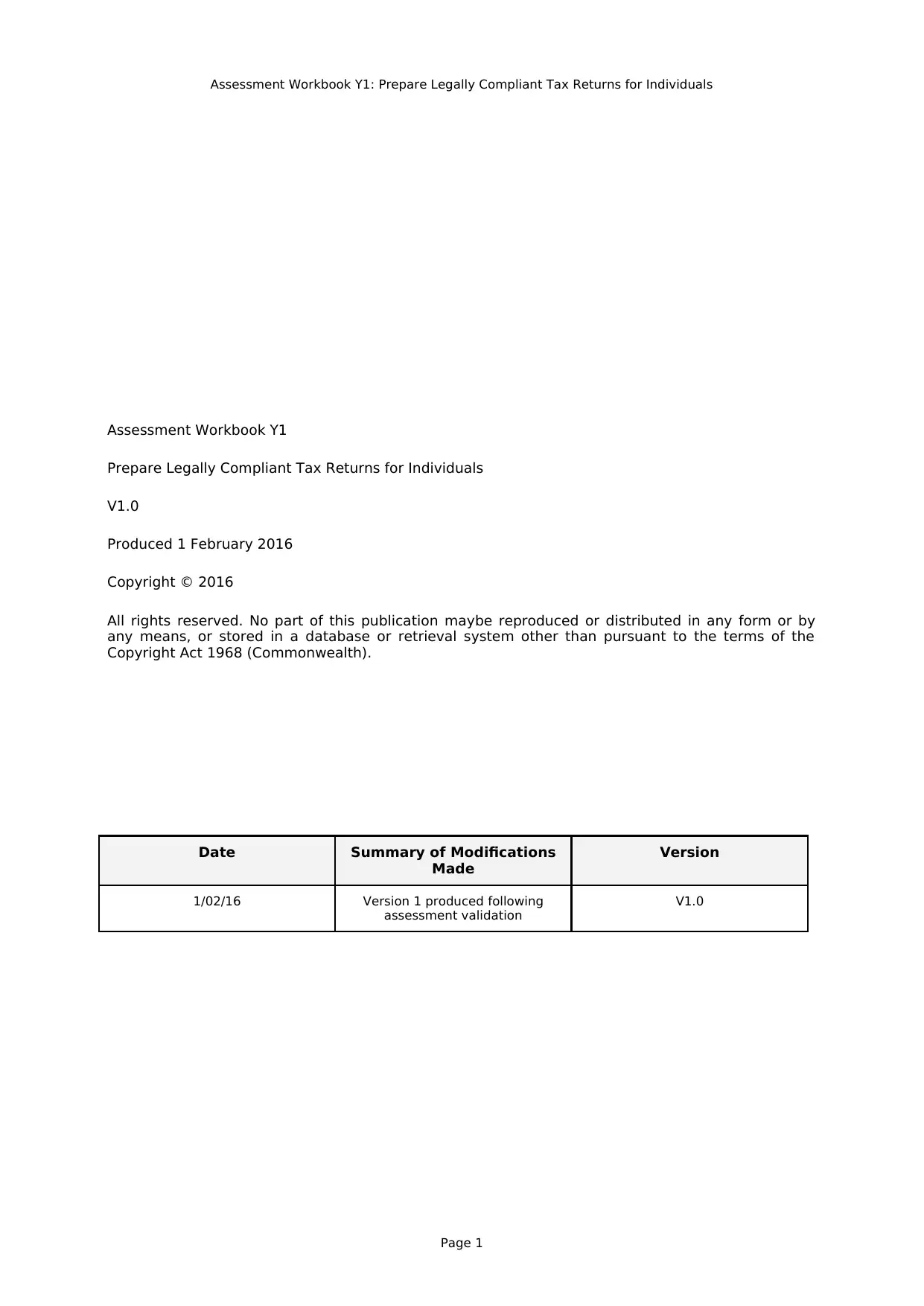
Assessment Workbook Y1: Prepare Legally Compliant Tax Returns for Individuals
Assessment Workbook Y1
Prepare Legally Compliant Tax Returns for Individuals
V1.0
Produced 1 February 2016
Copyright © 2016
All rights reserved. No part of this publication maybe reproduced or distributed in any form or by
any means, or stored in a database or retrieval system other than pursuant to the terms of the
Copyright Act 1968 (Commonwealth).
Date Summary of Modifications
Made
Version
1/02/16 Version 1 produced following
assessment validation
V1.0
Page 1
Assessment Workbook Y1
Prepare Legally Compliant Tax Returns for Individuals
V1.0
Produced 1 February 2016
Copyright © 2016
All rights reserved. No part of this publication maybe reproduced or distributed in any form or by
any means, or stored in a database or retrieval system other than pursuant to the terms of the
Copyright Act 1968 (Commonwealth).
Date Summary of Modifications
Made
Version
1/02/16 Version 1 produced following
assessment validation
V1.0
Page 1
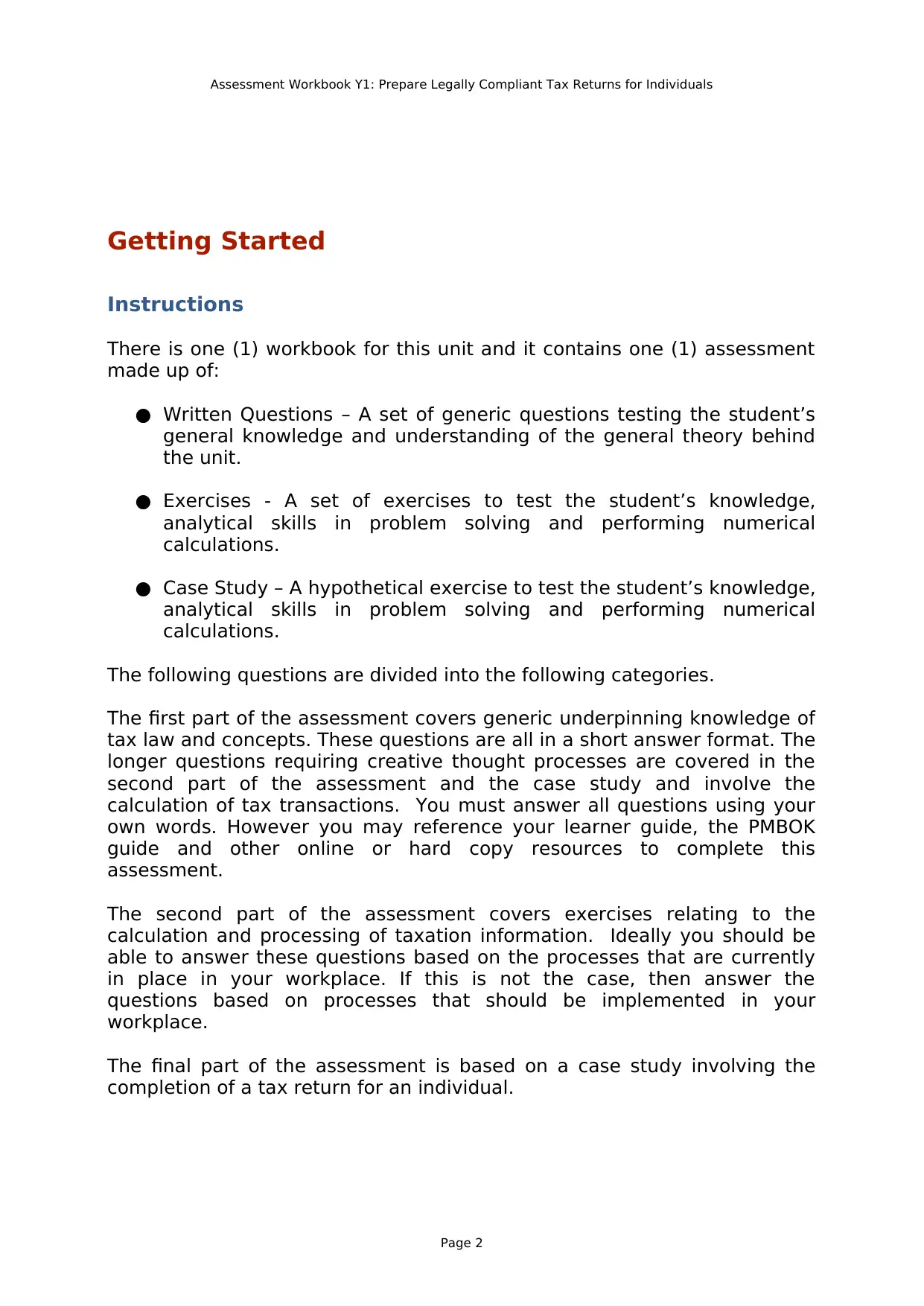
Assessment Workbook Y1: Prepare Legally Compliant Tax Returns for Individuals
Getting Started
Instructions
There is one (1) workbook for this unit and it contains one (1) assessment
made up of:
● Written Questions – A set of generic questions testing the student’s
general knowledge and understanding of the general theory behind
the unit.
● Exercises - A set of exercises to test the student’s knowledge,
analytical skills in problem solving and performing numerical
calculations.
● Case Study – A hypothetical exercise to test the student’s knowledge,
analytical skills in problem solving and performing numerical
calculations.
The following questions are divided into the following categories.
The first part of the assessment covers generic underpinning knowledge of
tax law and concepts. These questions are all in a short answer format. The
longer questions requiring creative thought processes are covered in the
second part of the assessment and the case study and involve the
calculation of tax transactions. You must answer all questions using your
own words. However you may reference your learner guide, the PMBOK
guide and other online or hard copy resources to complete this
assessment.
The second part of the assessment covers exercises relating to the
calculation and processing of taxation information. Ideally you should be
able to answer these questions based on the processes that are currently
in place in your workplace. If this is not the case, then answer the
questions based on processes that should be implemented in your
workplace.
The final part of the assessment is based on a case study involving the
completion of a tax return for an individual.
Page 2
Getting Started
Instructions
There is one (1) workbook for this unit and it contains one (1) assessment
made up of:
● Written Questions – A set of generic questions testing the student’s
general knowledge and understanding of the general theory behind
the unit.
● Exercises - A set of exercises to test the student’s knowledge,
analytical skills in problem solving and performing numerical
calculations.
● Case Study – A hypothetical exercise to test the student’s knowledge,
analytical skills in problem solving and performing numerical
calculations.
The following questions are divided into the following categories.
The first part of the assessment covers generic underpinning knowledge of
tax law and concepts. These questions are all in a short answer format. The
longer questions requiring creative thought processes are covered in the
second part of the assessment and the case study and involve the
calculation of tax transactions. You must answer all questions using your
own words. However you may reference your learner guide, the PMBOK
guide and other online or hard copy resources to complete this
assessment.
The second part of the assessment covers exercises relating to the
calculation and processing of taxation information. Ideally you should be
able to answer these questions based on the processes that are currently
in place in your workplace. If this is not the case, then answer the
questions based on processes that should be implemented in your
workplace.
The final part of the assessment is based on a case study involving the
completion of a tax return for an individual.
Page 2
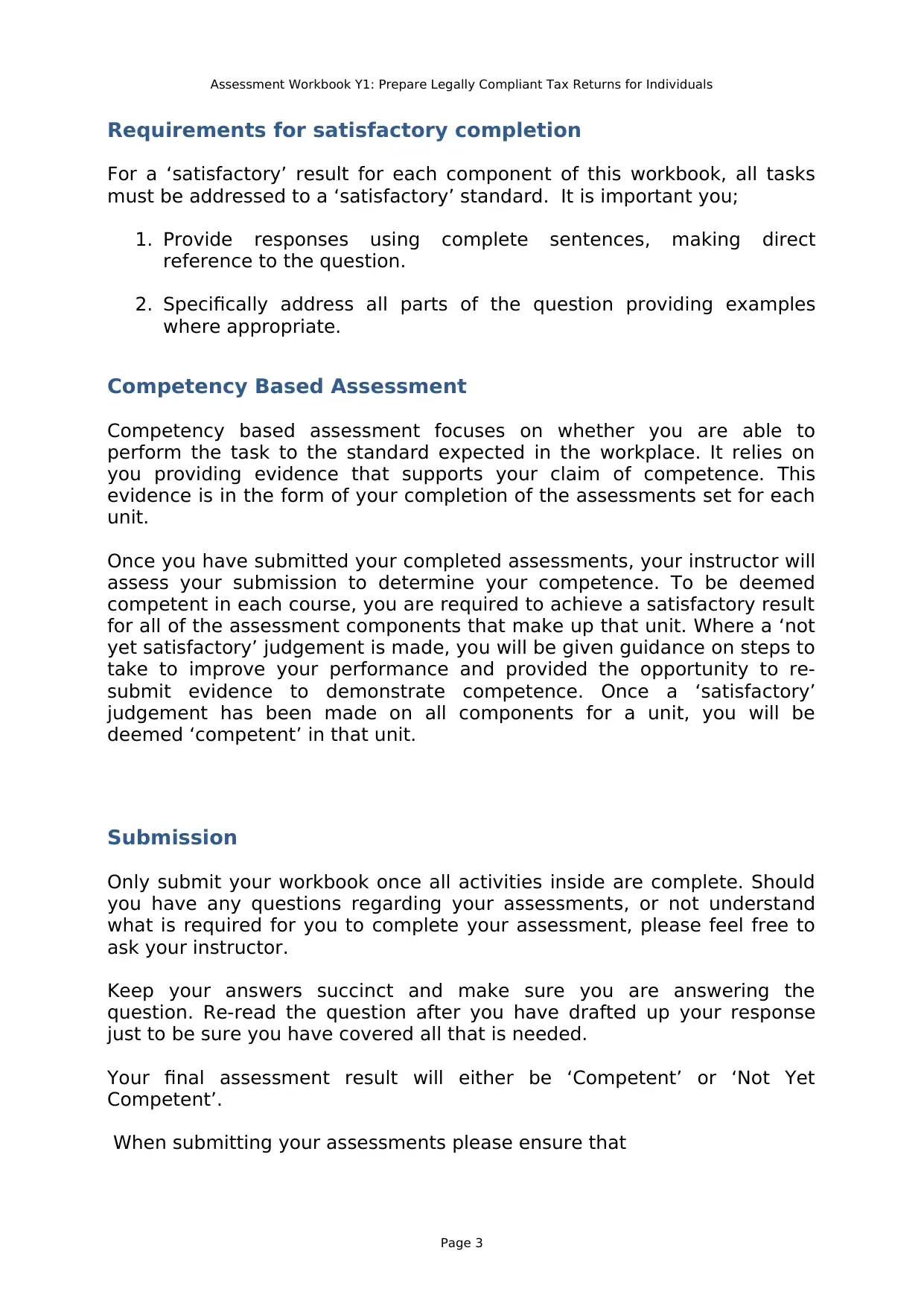
Assessment Workbook Y1: Prepare Legally Compliant Tax Returns for Individuals
Requirements for satisfactory completion
For a ‘satisfactory’ result for each component of this workbook, all tasks
must be addressed to a ‘satisfactory’ standard. It is important you;
1. Provide responses using complete sentences, making direct
reference to the question.
2. Specifically address all parts of the question providing examples
where appropriate.
Competency Based Assessment
Competency based assessment focuses on whether you are able to
perform the task to the standard expected in the workplace. It relies on
you providing evidence that supports your claim of competence. This
evidence is in the form of your completion of the assessments set for each
unit.
Once you have submitted your completed assessments, your instructor will
assess your submission to determine your competence. To be deemed
competent in each course, you are required to achieve a satisfactory result
for all of the assessment components that make up that unit. Where a ‘not
yet satisfactory’ judgement is made, you will be given guidance on steps to
take to improve your performance and provided the opportunity to re-
submit evidence to demonstrate competence. Once a ‘satisfactory’
judgement has been made on all components for a unit, you will be
deemed ‘competent’ in that unit.
Submission
Only submit your workbook once all activities inside are complete. Should
you have any questions regarding your assessments, or not understand
what is required for you to complete your assessment, please feel free to
ask your instructor.
Keep your answers succinct and make sure you are answering the
question. Re-read the question after you have drafted up your response
just to be sure you have covered all that is needed.
Your final assessment result will either be ‘Competent’ or ‘Not Yet
Competent’.
When submitting your assessments please ensure that
Page 3
Requirements for satisfactory completion
For a ‘satisfactory’ result for each component of this workbook, all tasks
must be addressed to a ‘satisfactory’ standard. It is important you;
1. Provide responses using complete sentences, making direct
reference to the question.
2. Specifically address all parts of the question providing examples
where appropriate.
Competency Based Assessment
Competency based assessment focuses on whether you are able to
perform the task to the standard expected in the workplace. It relies on
you providing evidence that supports your claim of competence. This
evidence is in the form of your completion of the assessments set for each
unit.
Once you have submitted your completed assessments, your instructor will
assess your submission to determine your competence. To be deemed
competent in each course, you are required to achieve a satisfactory result
for all of the assessment components that make up that unit. Where a ‘not
yet satisfactory’ judgement is made, you will be given guidance on steps to
take to improve your performance and provided the opportunity to re-
submit evidence to demonstrate competence. Once a ‘satisfactory’
judgement has been made on all components for a unit, you will be
deemed ‘competent’ in that unit.
Submission
Only submit your workbook once all activities inside are complete. Should
you have any questions regarding your assessments, or not understand
what is required for you to complete your assessment, please feel free to
ask your instructor.
Keep your answers succinct and make sure you are answering the
question. Re-read the question after you have drafted up your response
just to be sure you have covered all that is needed.
Your final assessment result will either be ‘Competent’ or ‘Not Yet
Competent’.
When submitting your assessments please ensure that
Page 3
Secure Best Marks with AI Grader
Need help grading? Try our AI Grader for instant feedback on your assignments.
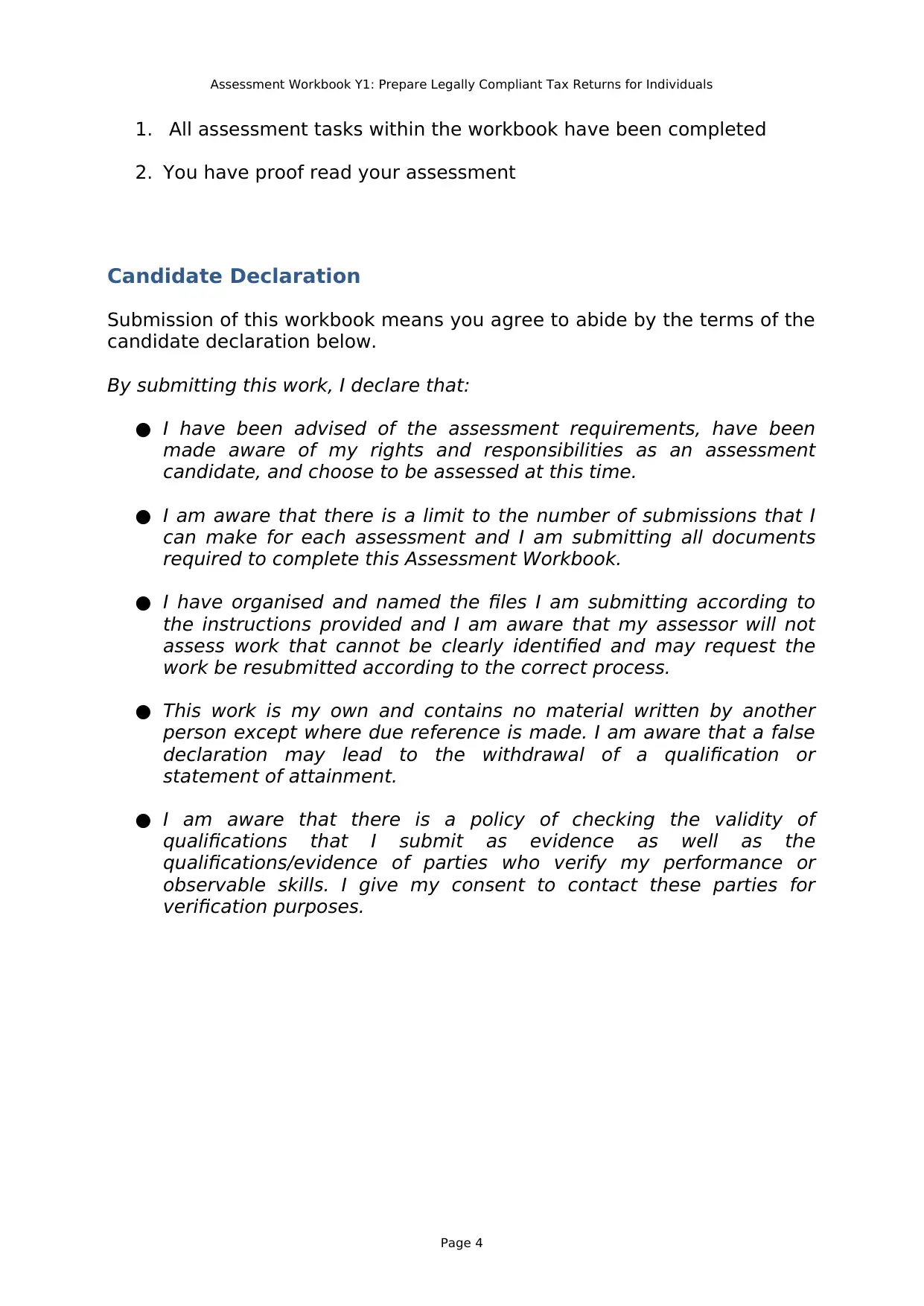
Assessment Workbook Y1: Prepare Legally Compliant Tax Returns for Individuals
1. All assessment tasks within the workbook have been completed
2. You have proof read your assessment
Candidate Declaration
Submission of this workbook means you agree to abide by the terms of the
candidate declaration below.
By submitting this work, I declare that:
● I have been advised of the assessment requirements, have been
made aware of my rights and responsibilities as an assessment
candidate, and choose to be assessed at this time.
● I am aware that there is a limit to the number of submissions that I
can make for each assessment and I am submitting all documents
required to complete this Assessment Workbook.
● I have organised and named the files I am submitting according to
the instructions provided and I am aware that my assessor will not
assess work that cannot be clearly identified and may request the
work be resubmitted according to the correct process.
● This work is my own and contains no material written by another
person except where due reference is made. I am aware that a false
declaration may lead to the withdrawal of a qualification or
statement of attainment.
● I am aware that there is a policy of checking the validity of
qualifications that I submit as evidence as well as the
qualifications/evidence of parties who verify my performance or
observable skills. I give my consent to contact these parties for
verification purposes.
Page 4
1. All assessment tasks within the workbook have been completed
2. You have proof read your assessment
Candidate Declaration
Submission of this workbook means you agree to abide by the terms of the
candidate declaration below.
By submitting this work, I declare that:
● I have been advised of the assessment requirements, have been
made aware of my rights and responsibilities as an assessment
candidate, and choose to be assessed at this time.
● I am aware that there is a limit to the number of submissions that I
can make for each assessment and I am submitting all documents
required to complete this Assessment Workbook.
● I have organised and named the files I am submitting according to
the instructions provided and I am aware that my assessor will not
assess work that cannot be clearly identified and may request the
work be resubmitted according to the correct process.
● This work is my own and contains no material written by another
person except where due reference is made. I am aware that a false
declaration may lead to the withdrawal of a qualification or
statement of attainment.
● I am aware that there is a policy of checking the validity of
qualifications that I submit as evidence as well as the
qualifications/evidence of parties who verify my performance or
observable skills. I give my consent to contact these parties for
verification purposes.
Page 4
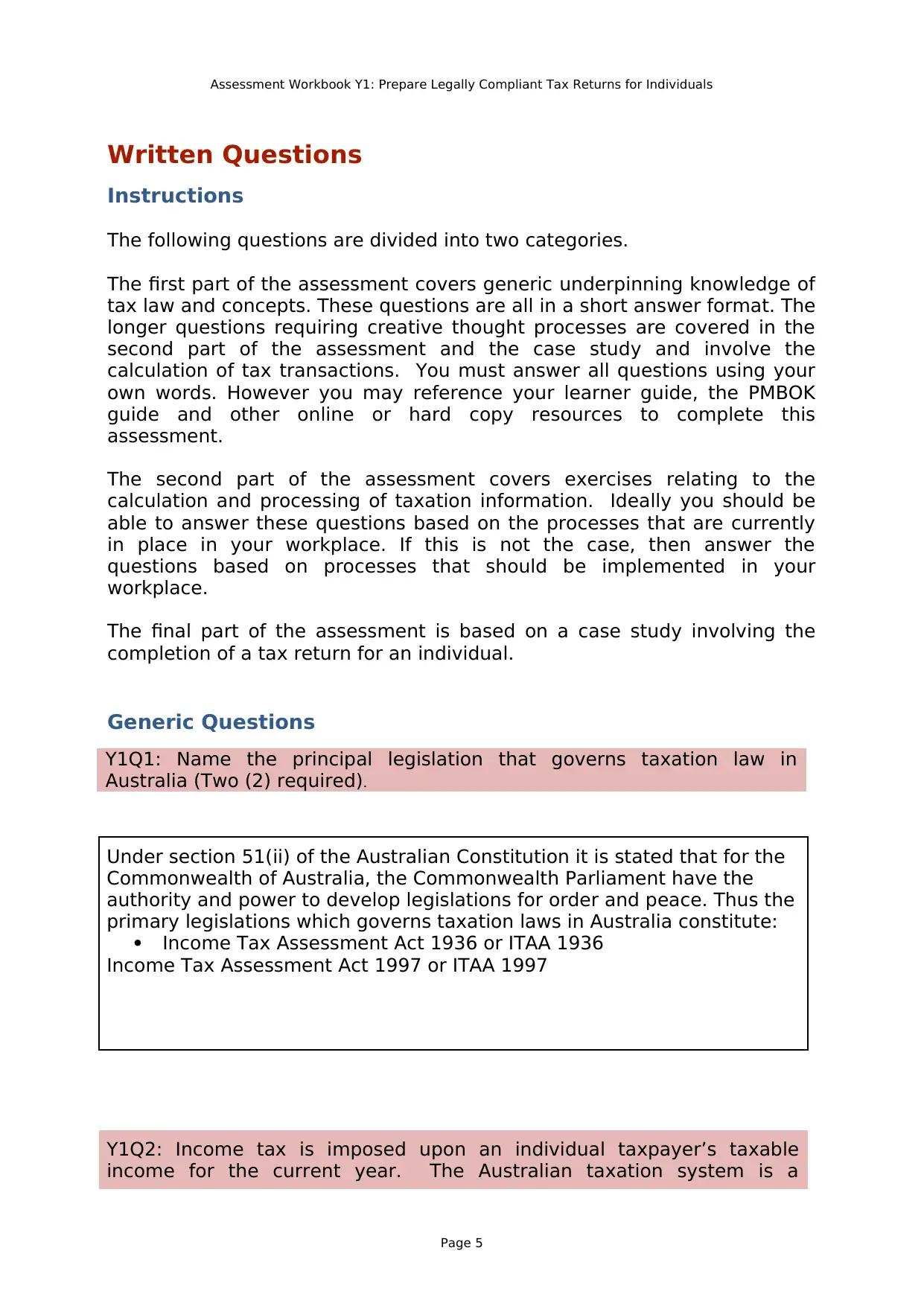
Assessment Workbook Y1: Prepare Legally Compliant Tax Returns for Individuals
Written Questions
Instructions
The following questions are divided into two categories.
The first part of the assessment covers generic underpinning knowledge of
tax law and concepts. These questions are all in a short answer format. The
longer questions requiring creative thought processes are covered in the
second part of the assessment and the case study and involve the
calculation of tax transactions. You must answer all questions using your
own words. However you may reference your learner guide, the PMBOK
guide and other online or hard copy resources to complete this
assessment.
The second part of the assessment covers exercises relating to the
calculation and processing of taxation information. Ideally you should be
able to answer these questions based on the processes that are currently
in place in your workplace. If this is not the case, then answer the
questions based on processes that should be implemented in your
workplace.
The final part of the assessment is based on a case study involving the
completion of a tax return for an individual.
Generic Questions
Y1Q1: Name the principal legislation that governs taxation law in
Australia (Two (2) required).
Under section 51(ii) of the Australian Constitution it is stated that for the
Commonwealth of Australia, the Commonwealth Parliament have the
authority and power to develop legislations for order and peace. Thus the
primary legislations which governs taxation laws in Australia constitute:
Income Tax Assessment Act 1936 or ITAA 1936
Income Tax Assessment Act 1997 or ITAA 1997
Y1Q2: Income tax is imposed upon an individual taxpayer’s taxable
income for the current year. The Australian taxation system is a
Page 5
Written Questions
Instructions
The following questions are divided into two categories.
The first part of the assessment covers generic underpinning knowledge of
tax law and concepts. These questions are all in a short answer format. The
longer questions requiring creative thought processes are covered in the
second part of the assessment and the case study and involve the
calculation of tax transactions. You must answer all questions using your
own words. However you may reference your learner guide, the PMBOK
guide and other online or hard copy resources to complete this
assessment.
The second part of the assessment covers exercises relating to the
calculation and processing of taxation information. Ideally you should be
able to answer these questions based on the processes that are currently
in place in your workplace. If this is not the case, then answer the
questions based on processes that should be implemented in your
workplace.
The final part of the assessment is based on a case study involving the
completion of a tax return for an individual.
Generic Questions
Y1Q1: Name the principal legislation that governs taxation law in
Australia (Two (2) required).
Under section 51(ii) of the Australian Constitution it is stated that for the
Commonwealth of Australia, the Commonwealth Parliament have the
authority and power to develop legislations for order and peace. Thus the
primary legislations which governs taxation laws in Australia constitute:
Income Tax Assessment Act 1936 or ITAA 1936
Income Tax Assessment Act 1997 or ITAA 1997
Y1Q2: Income tax is imposed upon an individual taxpayer’s taxable
income for the current year. The Australian taxation system is a
Page 5

Assessment Workbook Y1: Prepare Legally Compliant Tax Returns for Individuals
progressive tax system. What is meant by the terms “progressive tax
system” and “PAYG tax”?
The obligatory contribution towards the state revenue by any individual,
businesses or other entities is known as Tax. On the basis of an
individual’s or company’s or entity’s taxable income for the present
financial year income tax is levied upon them. Moreover in Australia, the
system of progressive taxation system is followed which implies that with
an increase in an individual’s taxable income, taxes that are levied on
them also increases gradually. Thus the more an individual will earn, the
more he had to pay the tax. Hence this concept is known as progressive
tax system.
In case of any employee who is a taxpayer in Australia an amount is
withheld from the gross salaries or wages of the individual as
installments of that person’s total tax liability. This withholding is known
as the system of Pay As You Go Tax or PAYG Tax.
Y1Q3: Based on the individual income tax rates for Australian residents
able to claim the tax free threshold for 2013-2014 (exclusive of the
medicare levy of 1.5%), calculate the amount of income tax to be paid for
the following amounts of taxable income:
Y1Q3A $95,000
Y1Q3B $36,000
Y1Q3C $250,000
Y1Q3D $19,500
Y1Q3A
Tax Payable= 17547+ (95000-80000) X37%= $23097.
Y1Q3B
Tax Payable= (36000-18200)X 19%= $3382
Y1Q3C
Tax payable= 54547+ (250000-180000) X 45%= $86047.
Page 6
progressive tax system. What is meant by the terms “progressive tax
system” and “PAYG tax”?
The obligatory contribution towards the state revenue by any individual,
businesses or other entities is known as Tax. On the basis of an
individual’s or company’s or entity’s taxable income for the present
financial year income tax is levied upon them. Moreover in Australia, the
system of progressive taxation system is followed which implies that with
an increase in an individual’s taxable income, taxes that are levied on
them also increases gradually. Thus the more an individual will earn, the
more he had to pay the tax. Hence this concept is known as progressive
tax system.
In case of any employee who is a taxpayer in Australia an amount is
withheld from the gross salaries or wages of the individual as
installments of that person’s total tax liability. This withholding is known
as the system of Pay As You Go Tax or PAYG Tax.
Y1Q3: Based on the individual income tax rates for Australian residents
able to claim the tax free threshold for 2013-2014 (exclusive of the
medicare levy of 1.5%), calculate the amount of income tax to be paid for
the following amounts of taxable income:
Y1Q3A $95,000
Y1Q3B $36,000
Y1Q3C $250,000
Y1Q3D $19,500
Y1Q3A
Tax Payable= 17547+ (95000-80000) X37%= $23097.
Y1Q3B
Tax Payable= (36000-18200)X 19%= $3382
Y1Q3C
Tax payable= 54547+ (250000-180000) X 45%= $86047.
Page 6
Paraphrase This Document
Need a fresh take? Get an instant paraphrase of this document with our AI Paraphraser

Assessment Workbook Y1: Prepare Legally Compliant Tax Returns for Individuals
Y1Q3D
Tax Payable= (19500-18200)X19%= $247.
Y1Q4: Richard has a taxable income of $125,000 for the year ended 2011
2012. His wife Emily has a taxable income of $35,000. They have two
(2) dependent children and do not have private hospital cover. Will
Richard and Emily have to pay a medicare levy surcharge in the 2011-
2012 income year? Give reasons for your decision.
As per Medicare Levy Surcharge legislations, any individual who is a
resident of Australia and families as well who’s annual taxable income is
above the threshold limit and also do not have a proper private patient
hospital coverage might need to pay an additional surcharge. This
surcharge is called Medicare Levy Surcharge. In this case Richard and
Emily is considered as a family where their total taxable income is
$160,000 plus $1,500 for one child after the first child. Thus this makes
their total family threshold for Medicare Levy Surcharge is $161,000. But
as per legislation if any family have a family threshold of $168,000 or
less, then the rate of Medicare Levy Surcharge is 0.00%. This clarifies
that there will be no Medicare Levy Surcharge applicable to Richard and
Emily.
Y1Q5: In the following situations determine whether the amount is
classified as assessable income and give an explanation for your
decision:
Y1Q5A Joan receives a fuel allowance of $2,000 each year from her
employer;
Y1Q5B Michael suffers an eye injury at work and receives a lump
sum compensation payment of $40,000 in compensation from his
employer;
Y1Q5C Jill slips on some tiles and breaks her leg while performing her
Page 7
Y1Q3D
Tax Payable= (19500-18200)X19%= $247.
Y1Q4: Richard has a taxable income of $125,000 for the year ended 2011
2012. His wife Emily has a taxable income of $35,000. They have two
(2) dependent children and do not have private hospital cover. Will
Richard and Emily have to pay a medicare levy surcharge in the 2011-
2012 income year? Give reasons for your decision.
As per Medicare Levy Surcharge legislations, any individual who is a
resident of Australia and families as well who’s annual taxable income is
above the threshold limit and also do not have a proper private patient
hospital coverage might need to pay an additional surcharge. This
surcharge is called Medicare Levy Surcharge. In this case Richard and
Emily is considered as a family where their total taxable income is
$160,000 plus $1,500 for one child after the first child. Thus this makes
their total family threshold for Medicare Levy Surcharge is $161,000. But
as per legislation if any family have a family threshold of $168,000 or
less, then the rate of Medicare Levy Surcharge is 0.00%. This clarifies
that there will be no Medicare Levy Surcharge applicable to Richard and
Emily.
Y1Q5: In the following situations determine whether the amount is
classified as assessable income and give an explanation for your
decision:
Y1Q5A Joan receives a fuel allowance of $2,000 each year from her
employer;
Y1Q5B Michael suffers an eye injury at work and receives a lump
sum compensation payment of $40,000 in compensation from his
employer;
Y1Q5C Jill slips on some tiles and breaks her leg while performing her
Page 7
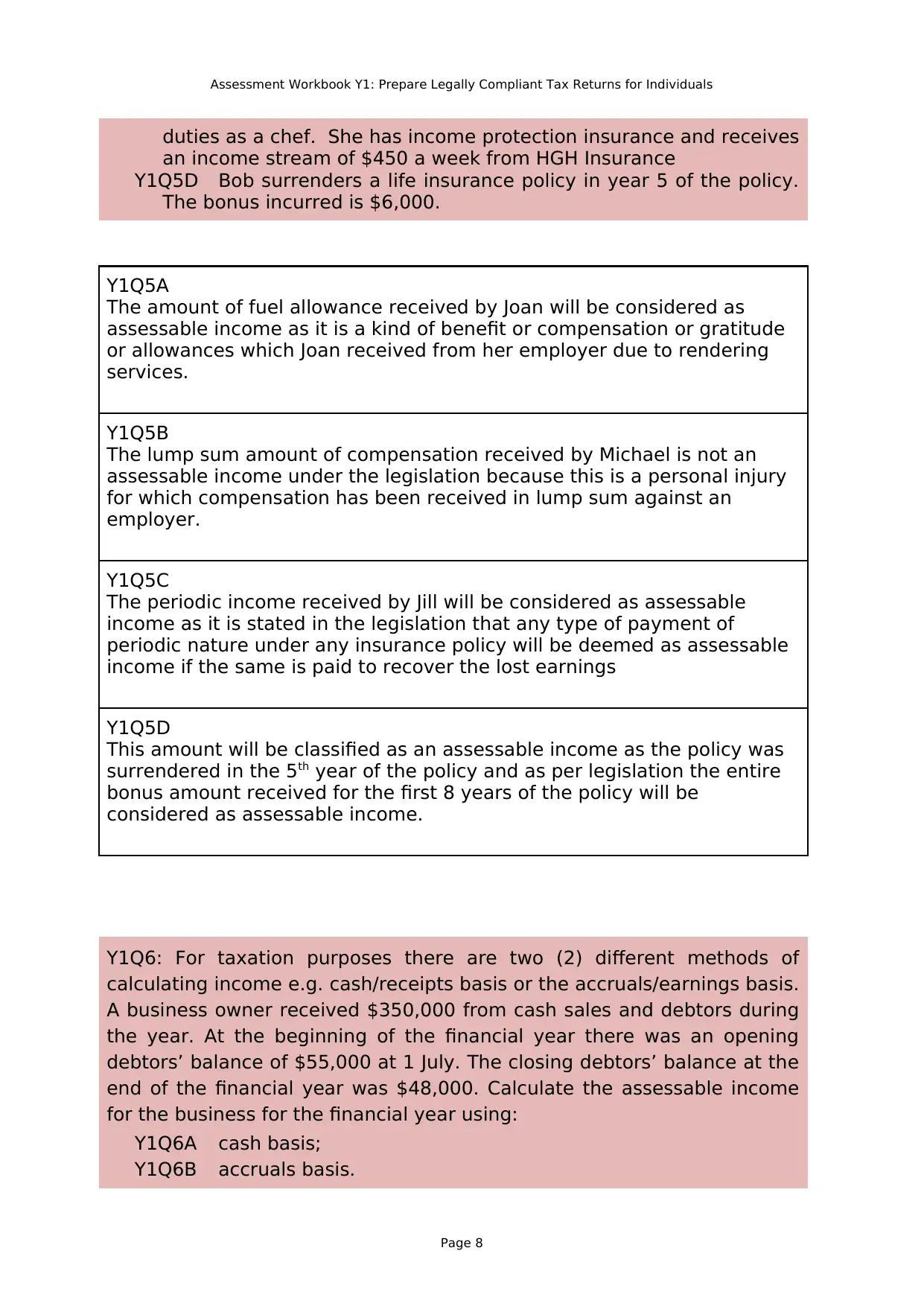
Assessment Workbook Y1: Prepare Legally Compliant Tax Returns for Individuals
duties as a chef. She has income protection insurance and receives
an income stream of $450 a week from HGH Insurance
Y1Q5D Bob surrenders a life insurance policy in year 5 of the policy.
The bonus incurred is $6,000.
Y1Q5A
The amount of fuel allowance received by Joan will be considered as
assessable income as it is a kind of benefit or compensation or gratitude
or allowances which Joan received from her employer due to rendering
services.
Y1Q5B
The lump sum amount of compensation received by Michael is not an
assessable income under the legislation because this is a personal injury
for which compensation has been received in lump sum against an
employer.
Y1Q5C
The periodic income received by Jill will be considered as assessable
income as it is stated in the legislation that any type of payment of
periodic nature under any insurance policy will be deemed as assessable
income if the same is paid to recover the lost earnings
Y1Q5D
This amount will be classified as an assessable income as the policy was
surrendered in the 5th year of the policy and as per legislation the entire
bonus amount received for the first 8 years of the policy will be
considered as assessable income.
Y1Q6: For taxation purposes there are two (2) different methods of
calculating income e.g. cash/receipts basis or the accruals/earnings basis.
A business owner received $350,000 from cash sales and debtors during
the year. At the beginning of the financial year there was an opening
debtors’ balance of $55,000 at 1 July. The closing debtors’ balance at the
end of the financial year was $48,000. Calculate the assessable income
for the business for the financial year using:
Y1Q6A cash basis;
Y1Q6B accruals basis.
Page 8
duties as a chef. She has income protection insurance and receives
an income stream of $450 a week from HGH Insurance
Y1Q5D Bob surrenders a life insurance policy in year 5 of the policy.
The bonus incurred is $6,000.
Y1Q5A
The amount of fuel allowance received by Joan will be considered as
assessable income as it is a kind of benefit or compensation or gratitude
or allowances which Joan received from her employer due to rendering
services.
Y1Q5B
The lump sum amount of compensation received by Michael is not an
assessable income under the legislation because this is a personal injury
for which compensation has been received in lump sum against an
employer.
Y1Q5C
The periodic income received by Jill will be considered as assessable
income as it is stated in the legislation that any type of payment of
periodic nature under any insurance policy will be deemed as assessable
income if the same is paid to recover the lost earnings
Y1Q5D
This amount will be classified as an assessable income as the policy was
surrendered in the 5th year of the policy and as per legislation the entire
bonus amount received for the first 8 years of the policy will be
considered as assessable income.
Y1Q6: For taxation purposes there are two (2) different methods of
calculating income e.g. cash/receipts basis or the accruals/earnings basis.
A business owner received $350,000 from cash sales and debtors during
the year. At the beginning of the financial year there was an opening
debtors’ balance of $55,000 at 1 July. The closing debtors’ balance at the
end of the financial year was $48,000. Calculate the assessable income
for the business for the financial year using:
Y1Q6A cash basis;
Y1Q6B accruals basis.
Page 8
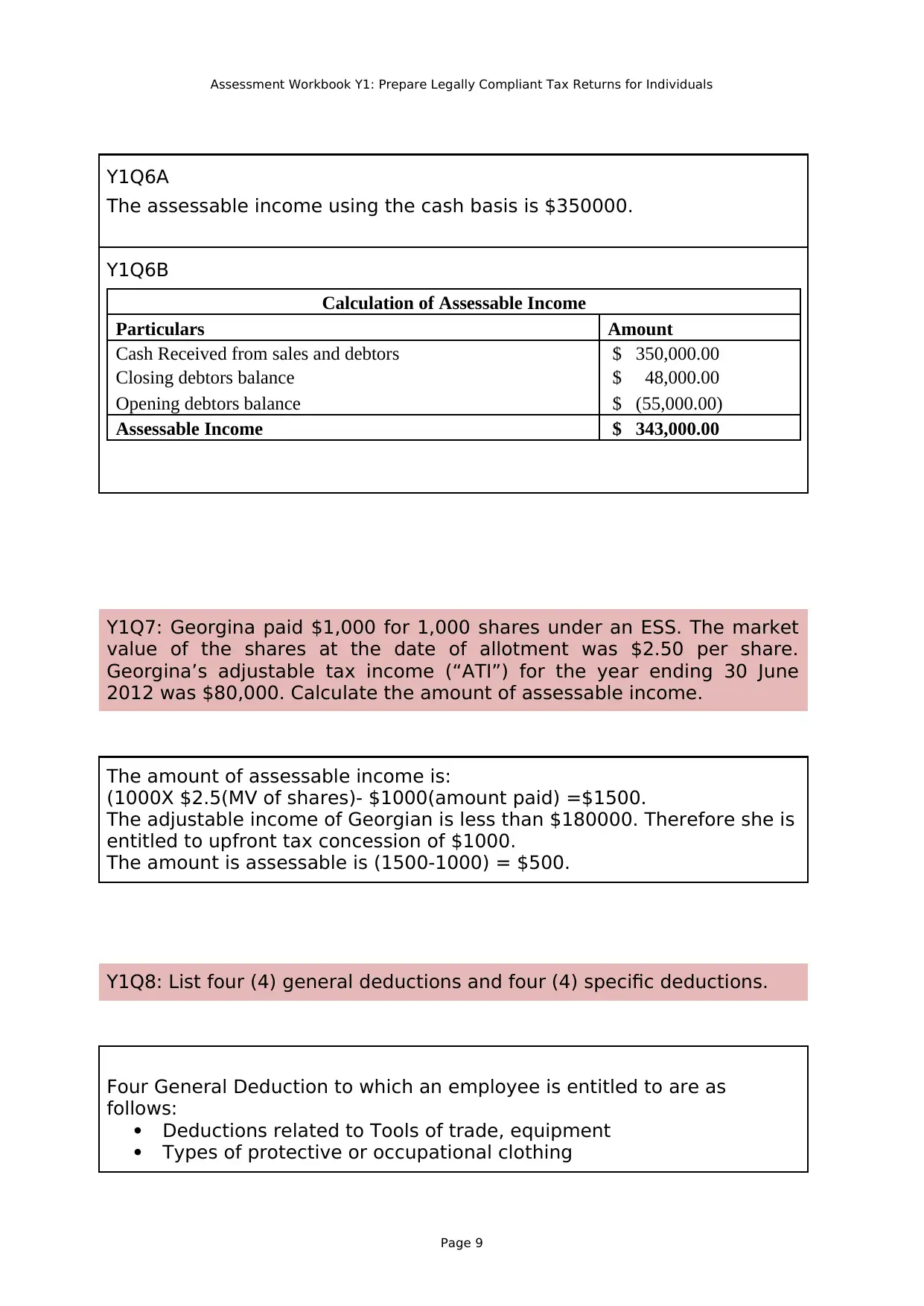
Assessment Workbook Y1: Prepare Legally Compliant Tax Returns for Individuals
Y1Q6A
The assessable income using the cash basis is $350000.
Y1Q6B
Calculation of Assessable Income
Particulars Amount
Cash Received from sales and debtors $ 350,000.00
Closing debtors balance $ 48,000.00
Opening debtors balance $ (55,000.00)
Assessable Income $ 343,000.00
Y1Q7: Georgina paid $1,000 for 1,000 shares under an ESS. The market
value of the shares at the date of allotment was $2.50 per share.
Georgina’s adjustable tax income (“ATI”) for the year ending 30 June
2012 was $80,000. Calculate the amount of assessable income.
The amount of assessable income is:
(1000X $2.5(MV of shares)- $1000(amount paid) =$1500.
The adjustable income of Georgian is less than $180000. Therefore she is
entitled to upfront tax concession of $1000.
The amount is assessable is (1500-1000) = $500.
Y1Q8: List four (4) general deductions and four (4) specific deductions.
Four General Deduction to which an employee is entitled to are as
follows:
Deductions related to Tools of trade, equipment
Types of protective or occupational clothing
Page 9
Y1Q6A
The assessable income using the cash basis is $350000.
Y1Q6B
Calculation of Assessable Income
Particulars Amount
Cash Received from sales and debtors $ 350,000.00
Closing debtors balance $ 48,000.00
Opening debtors balance $ (55,000.00)
Assessable Income $ 343,000.00
Y1Q7: Georgina paid $1,000 for 1,000 shares under an ESS. The market
value of the shares at the date of allotment was $2.50 per share.
Georgina’s adjustable tax income (“ATI”) for the year ending 30 June
2012 was $80,000. Calculate the amount of assessable income.
The amount of assessable income is:
(1000X $2.5(MV of shares)- $1000(amount paid) =$1500.
The adjustable income of Georgian is less than $180000. Therefore she is
entitled to upfront tax concession of $1000.
The amount is assessable is (1500-1000) = $500.
Y1Q8: List four (4) general deductions and four (4) specific deductions.
Four General Deduction to which an employee is entitled to are as
follows:
Deductions related to Tools of trade, equipment
Types of protective or occupational clothing
Page 9
Secure Best Marks with AI Grader
Need help grading? Try our AI Grader for instant feedback on your assignments.
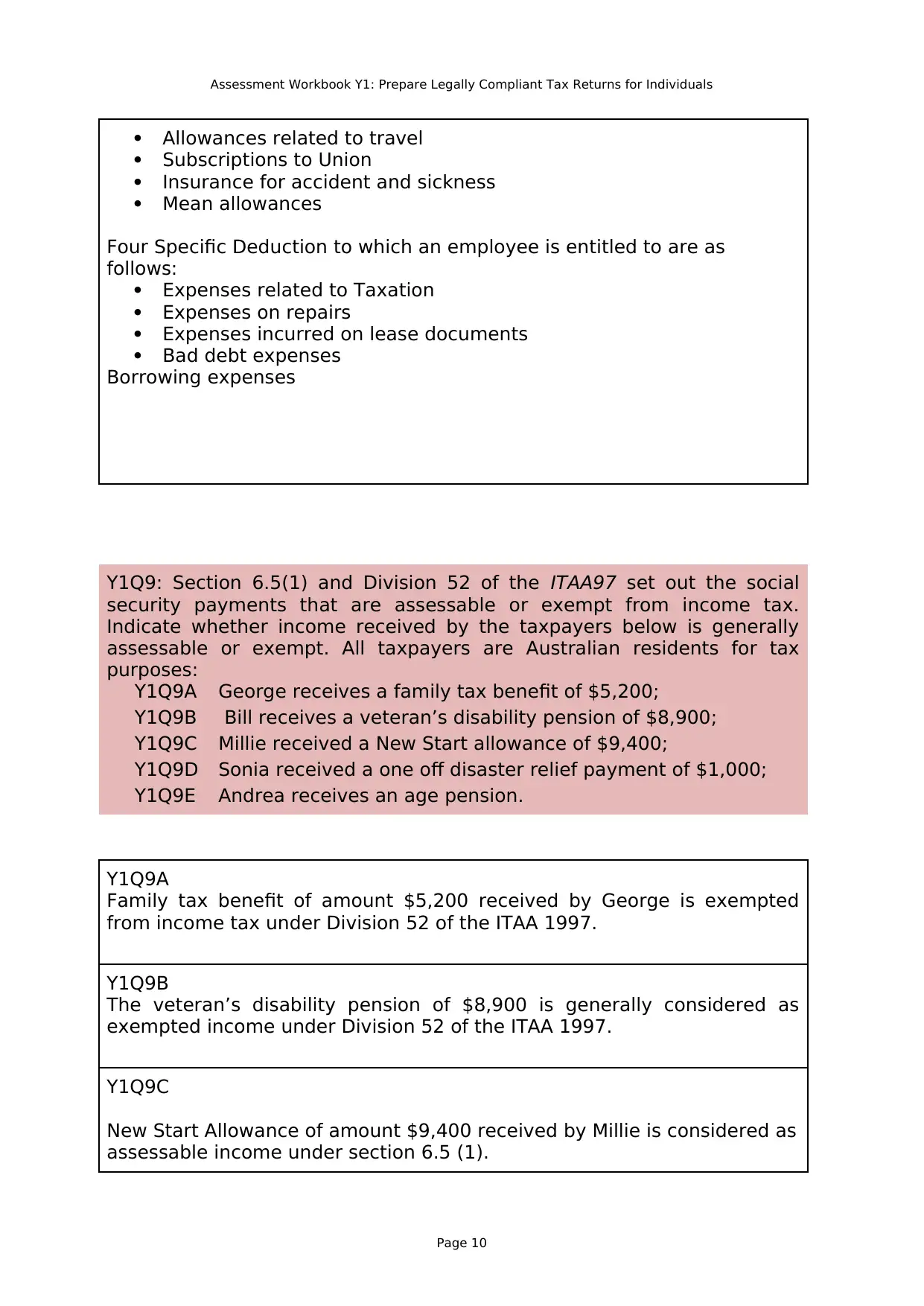
Assessment Workbook Y1: Prepare Legally Compliant Tax Returns for Individuals
Allowances related to travel
Subscriptions to Union
Insurance for accident and sickness
Mean allowances
Four Specific Deduction to which an employee is entitled to are as
follows:
Expenses related to Taxation
Expenses on repairs
Expenses incurred on lease documents
Bad debt expenses
Borrowing expenses
Y1Q9: Section 6.5(1) and Division 52 of the ITAA97 set out the social
security payments that are assessable or exempt from income tax.
Indicate whether income received by the taxpayers below is generally
assessable or exempt. All taxpayers are Australian residents for tax
purposes:
Y1Q9A George receives a family tax benefit of $5,200;
Y1Q9B Bill receives a veteran’s disability pension of $8,900;
Y1Q9C Millie received a New Start allowance of $9,400;
Y1Q9D Sonia received a one off disaster relief payment of $1,000;
Y1Q9E Andrea receives an age pension.
Y1Q9A
Family tax benefit of amount $5,200 received by George is exempted
from income tax under Division 52 of the ITAA 1997.
Y1Q9B
The veteran’s disability pension of $8,900 is generally considered as
exempted income under Division 52 of the ITAA 1997.
Y1Q9C
New Start Allowance of amount $9,400 received by Millie is considered as
assessable income under section 6.5 (1).
Page 10
Allowances related to travel
Subscriptions to Union
Insurance for accident and sickness
Mean allowances
Four Specific Deduction to which an employee is entitled to are as
follows:
Expenses related to Taxation
Expenses on repairs
Expenses incurred on lease documents
Bad debt expenses
Borrowing expenses
Y1Q9: Section 6.5(1) and Division 52 of the ITAA97 set out the social
security payments that are assessable or exempt from income tax.
Indicate whether income received by the taxpayers below is generally
assessable or exempt. All taxpayers are Australian residents for tax
purposes:
Y1Q9A George receives a family tax benefit of $5,200;
Y1Q9B Bill receives a veteran’s disability pension of $8,900;
Y1Q9C Millie received a New Start allowance of $9,400;
Y1Q9D Sonia received a one off disaster relief payment of $1,000;
Y1Q9E Andrea receives an age pension.
Y1Q9A
Family tax benefit of amount $5,200 received by George is exempted
from income tax under Division 52 of the ITAA 1997.
Y1Q9B
The veteran’s disability pension of $8,900 is generally considered as
exempted income under Division 52 of the ITAA 1997.
Y1Q9C
New Start Allowance of amount $9,400 received by Millie is considered as
assessable income under section 6.5 (1).
Page 10
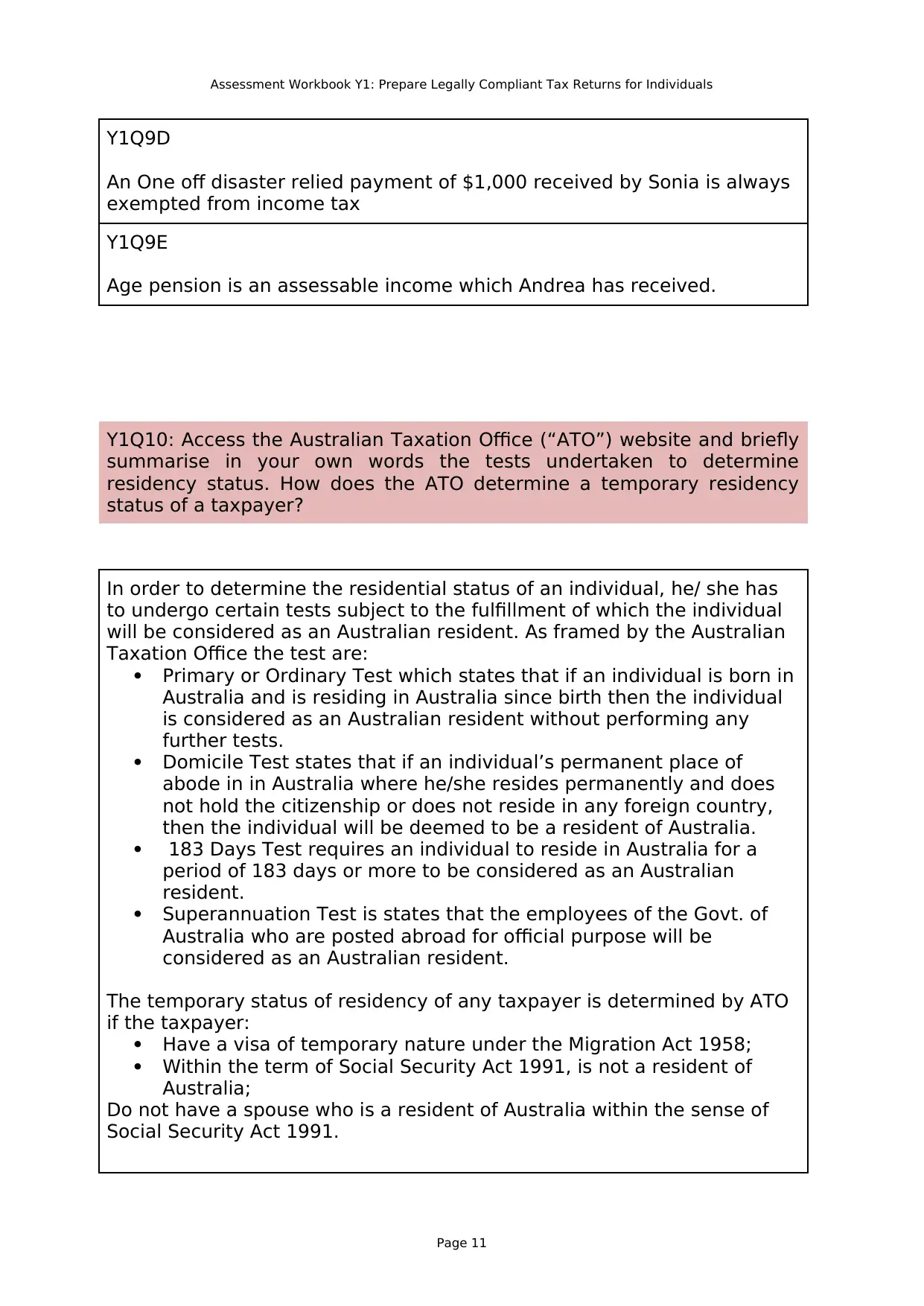
Assessment Workbook Y1: Prepare Legally Compliant Tax Returns for Individuals
Y1Q9D
An One off disaster relied payment of $1,000 received by Sonia is always
exempted from income tax
Y1Q9E
Age pension is an assessable income which Andrea has received.
Y1Q10: Access the Australian Taxation Office (“ATO”) website and briefly
summarise in your own words the tests undertaken to determine
residency status. How does the ATO determine a temporary residency
status of a taxpayer?
In order to determine the residential status of an individual, he/ she has
to undergo certain tests subject to the fulfillment of which the individual
will be considered as an Australian resident. As framed by the Australian
Taxation Office the test are:
Primary or Ordinary Test which states that if an individual is born in
Australia and is residing in Australia since birth then the individual
is considered as an Australian resident without performing any
further tests.
Domicile Test states that if an individual’s permanent place of
abode in in Australia where he/she resides permanently and does
not hold the citizenship or does not reside in any foreign country,
then the individual will be deemed to be a resident of Australia.
183 Days Test requires an individual to reside in Australia for a
period of 183 days or more to be considered as an Australian
resident.
Superannuation Test is states that the employees of the Govt. of
Australia who are posted abroad for official purpose will be
considered as an Australian resident.
The temporary status of residency of any taxpayer is determined by ATO
if the taxpayer:
Have a visa of temporary nature under the Migration Act 1958;
Within the term of Social Security Act 1991, is not a resident of
Australia;
Do not have a spouse who is a resident of Australia within the sense of
Social Security Act 1991.
Page 11
Y1Q9D
An One off disaster relied payment of $1,000 received by Sonia is always
exempted from income tax
Y1Q9E
Age pension is an assessable income which Andrea has received.
Y1Q10: Access the Australian Taxation Office (“ATO”) website and briefly
summarise in your own words the tests undertaken to determine
residency status. How does the ATO determine a temporary residency
status of a taxpayer?
In order to determine the residential status of an individual, he/ she has
to undergo certain tests subject to the fulfillment of which the individual
will be considered as an Australian resident. As framed by the Australian
Taxation Office the test are:
Primary or Ordinary Test which states that if an individual is born in
Australia and is residing in Australia since birth then the individual
is considered as an Australian resident without performing any
further tests.
Domicile Test states that if an individual’s permanent place of
abode in in Australia where he/she resides permanently and does
not hold the citizenship or does not reside in any foreign country,
then the individual will be deemed to be a resident of Australia.
183 Days Test requires an individual to reside in Australia for a
period of 183 days or more to be considered as an Australian
resident.
Superannuation Test is states that the employees of the Govt. of
Australia who are posted abroad for official purpose will be
considered as an Australian resident.
The temporary status of residency of any taxpayer is determined by ATO
if the taxpayer:
Have a visa of temporary nature under the Migration Act 1958;
Within the term of Social Security Act 1991, is not a resident of
Australia;
Do not have a spouse who is a resident of Australia within the sense of
Social Security Act 1991.
Page 11
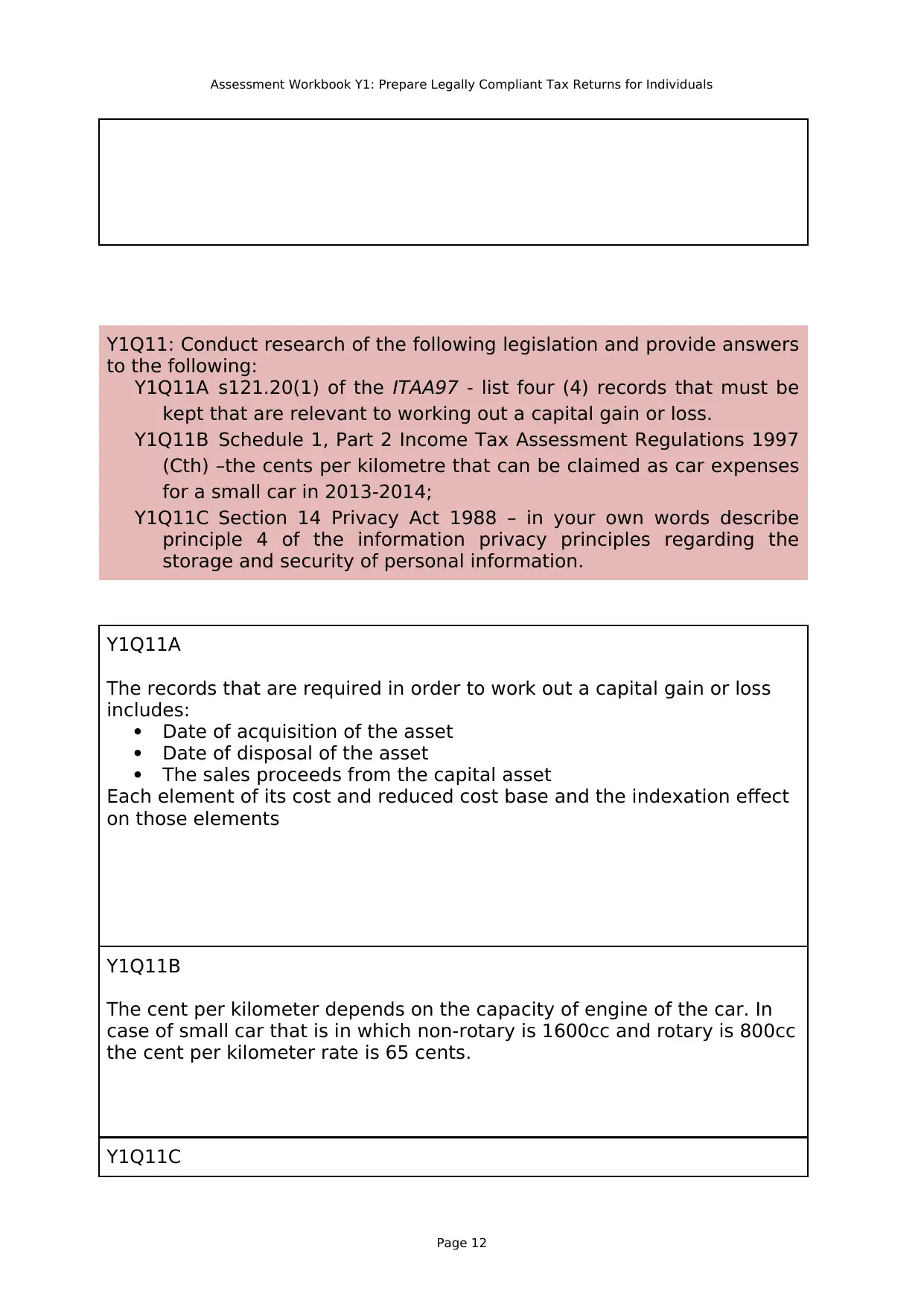
Assessment Workbook Y1: Prepare Legally Compliant Tax Returns for Individuals
Y1Q11: Conduct research of the following legislation and provide answers
to the following:
Y1Q11A s121.20(1) of the ITAA97 - list four (4) records that must be
kept that are relevant to working out a capital gain or loss.
Y1Q11B Schedule 1, Part 2 Income Tax Assessment Regulations 1997
(Cth) –the cents per kilometre that can be claimed as car expenses
for a small car in 2013-2014;
Y1Q11C Section 14 Privacy Act 1988 – in your own words describe
principle 4 of the information privacy principles regarding the
storage and security of personal information.
Y1Q11A
The records that are required in order to work out a capital gain or loss
includes:
Date of acquisition of the asset
Date of disposal of the asset
The sales proceeds from the capital asset
Each element of its cost and reduced cost base and the indexation effect
on those elements
Y1Q11B
The cent per kilometer depends on the capacity of engine of the car. In
case of small car that is in which non-rotary is 1600cc and rotary is 800cc
the cent per kilometer rate is 65 cents.
Y1Q11C
Page 12
Y1Q11: Conduct research of the following legislation and provide answers
to the following:
Y1Q11A s121.20(1) of the ITAA97 - list four (4) records that must be
kept that are relevant to working out a capital gain or loss.
Y1Q11B Schedule 1, Part 2 Income Tax Assessment Regulations 1997
(Cth) –the cents per kilometre that can be claimed as car expenses
for a small car in 2013-2014;
Y1Q11C Section 14 Privacy Act 1988 – in your own words describe
principle 4 of the information privacy principles regarding the
storage and security of personal information.
Y1Q11A
The records that are required in order to work out a capital gain or loss
includes:
Date of acquisition of the asset
Date of disposal of the asset
The sales proceeds from the capital asset
Each element of its cost and reduced cost base and the indexation effect
on those elements
Y1Q11B
The cent per kilometer depends on the capacity of engine of the car. In
case of small car that is in which non-rotary is 1600cc and rotary is 800cc
the cent per kilometer rate is 65 cents.
Y1Q11C
Page 12
Paraphrase This Document
Need a fresh take? Get an instant paraphrase of this document with our AI Paraphraser
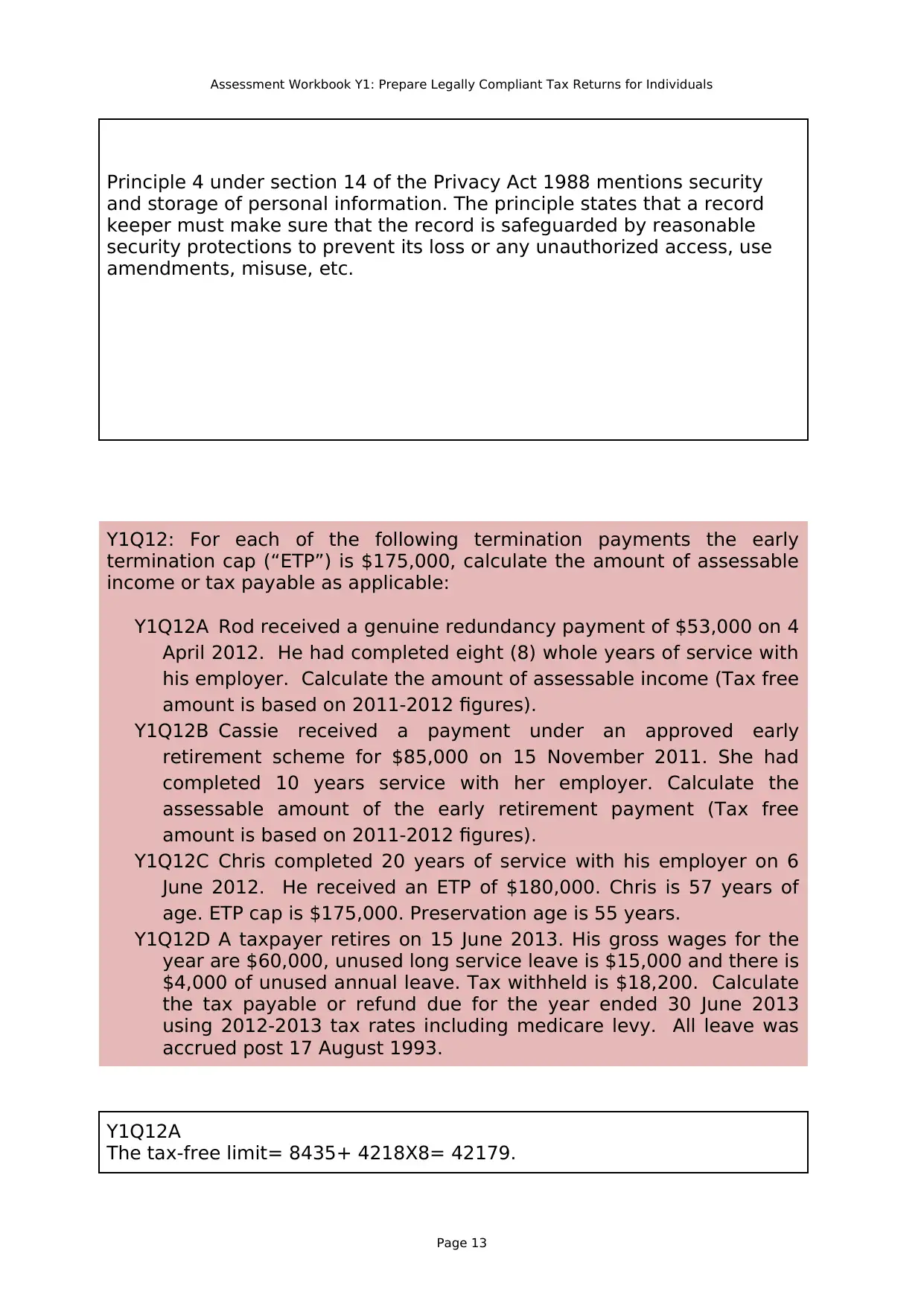
Assessment Workbook Y1: Prepare Legally Compliant Tax Returns for Individuals
Principle 4 under section 14 of the Privacy Act 1988 mentions security
and storage of personal information. The principle states that a record
keeper must make sure that the record is safeguarded by reasonable
security protections to prevent its loss or any unauthorized access, use
amendments, misuse, etc.
Y1Q12: For each of the following termination payments the early
termination cap (“ETP”) is $175,000, calculate the amount of assessable
income or tax payable as applicable:
Y1Q12A Rod received a genuine redundancy payment of $53,000 on 4
April 2012. He had completed eight (8) whole years of service with
his employer. Calculate the amount of assessable income (Tax free
amount is based on 2011-2012 figures).
Y1Q12B Cassie received a payment under an approved early
retirement scheme for $85,000 on 15 November 2011. She had
completed 10 years service with her employer. Calculate the
assessable amount of the early retirement payment (Tax free
amount is based on 2011-2012 figures).
Y1Q12C Chris completed 20 years of service with his employer on 6
June 2012. He received an ETP of $180,000. Chris is 57 years of
age. ETP cap is $175,000. Preservation age is 55 years.
Y1Q12D A taxpayer retires on 15 June 2013. His gross wages for the
year are $60,000, unused long service leave is $15,000 and there is
$4,000 of unused annual leave. Tax withheld is $18,200. Calculate
the tax payable or refund due for the year ended 30 June 2013
using 2012-2013 tax rates including medicare levy. All leave was
accrued post 17 August 1993.
Y1Q12A
The tax-free limit= 8435+ 4218X8= 42179.
Page 13
Principle 4 under section 14 of the Privacy Act 1988 mentions security
and storage of personal information. The principle states that a record
keeper must make sure that the record is safeguarded by reasonable
security protections to prevent its loss or any unauthorized access, use
amendments, misuse, etc.
Y1Q12: For each of the following termination payments the early
termination cap (“ETP”) is $175,000, calculate the amount of assessable
income or tax payable as applicable:
Y1Q12A Rod received a genuine redundancy payment of $53,000 on 4
April 2012. He had completed eight (8) whole years of service with
his employer. Calculate the amount of assessable income (Tax free
amount is based on 2011-2012 figures).
Y1Q12B Cassie received a payment under an approved early
retirement scheme for $85,000 on 15 November 2011. She had
completed 10 years service with her employer. Calculate the
assessable amount of the early retirement payment (Tax free
amount is based on 2011-2012 figures).
Y1Q12C Chris completed 20 years of service with his employer on 6
June 2012. He received an ETP of $180,000. Chris is 57 years of
age. ETP cap is $175,000. Preservation age is 55 years.
Y1Q12D A taxpayer retires on 15 June 2013. His gross wages for the
year are $60,000, unused long service leave is $15,000 and there is
$4,000 of unused annual leave. Tax withheld is $18,200. Calculate
the tax payable or refund due for the year ended 30 June 2013
using 2012-2013 tax rates including medicare levy. All leave was
accrued post 17 August 1993.
Y1Q12A
The tax-free limit= 8435+ 4218X8= 42179.
Page 13

Assessment Workbook Y1: Prepare Legally Compliant Tax Returns for Individuals
The redundancy payment that is above the tax-free limit should be
included in the assessable income. In the current case, the amount that
should be included in the assessable income is:
53000-42179= $10821.
Y1Q12B
Calculation of Assessable amount of early retirement payment
Particulars Amount
Early retirement payment received $ 85,000.00
Tax free limit $ 50,615.00
Amount included in Assessable income $ 34,385.00
Y1Q12C
Calculation of Assessable amount of early retirement payment
Particulars Amount
Early retirement payment received $ 180,000.00
Tax free limit $ 92,795.00
Amount included in Assessable income $ 87,205.00
Y1Q12D
Statement showing calculation of tax payable
Particulars Amount
Gross Wages $ 60,000.00
Unused long service leave $ 15,000.00
Unused Annual leave $ 4,000.00
Total Taxable Income $ 79,000.00
Tax on taxable income $ 19,112.00
Add:
Medicare Levy $ 1,185.00
$ 20,297.00
Less:
PAYG withheld $ 18,200.00
Net tax Payable $ 2,097.00
Page 14
The redundancy payment that is above the tax-free limit should be
included in the assessable income. In the current case, the amount that
should be included in the assessable income is:
53000-42179= $10821.
Y1Q12B
Calculation of Assessable amount of early retirement payment
Particulars Amount
Early retirement payment received $ 85,000.00
Tax free limit $ 50,615.00
Amount included in Assessable income $ 34,385.00
Y1Q12C
Calculation of Assessable amount of early retirement payment
Particulars Amount
Early retirement payment received $ 180,000.00
Tax free limit $ 92,795.00
Amount included in Assessable income $ 87,205.00
Y1Q12D
Statement showing calculation of tax payable
Particulars Amount
Gross Wages $ 60,000.00
Unused long service leave $ 15,000.00
Unused Annual leave $ 4,000.00
Total Taxable Income $ 79,000.00
Tax on taxable income $ 19,112.00
Add:
Medicare Levy $ 1,185.00
$ 20,297.00
Less:
PAYG withheld $ 18,200.00
Net tax Payable $ 2,097.00
Page 14
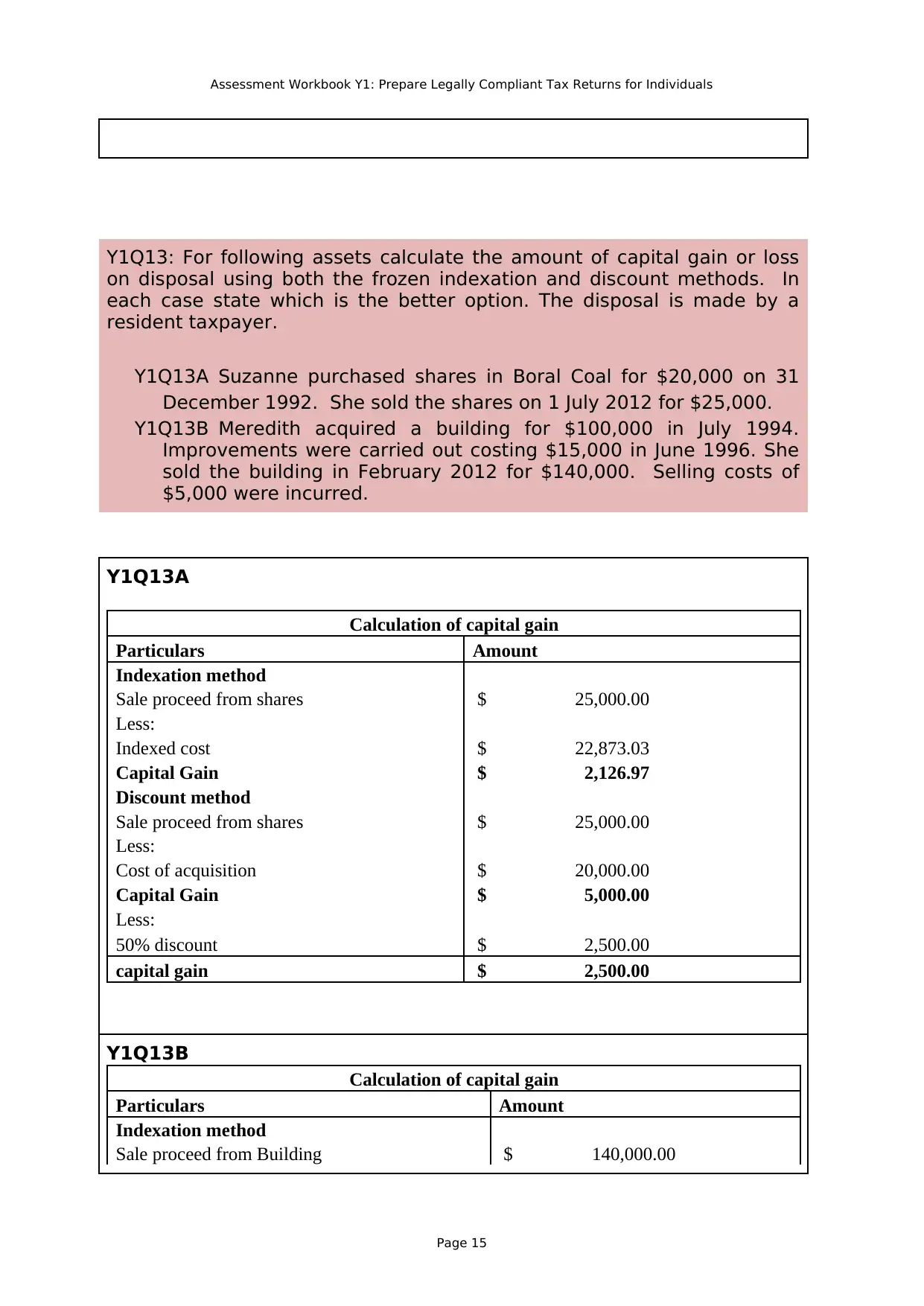
Assessment Workbook Y1: Prepare Legally Compliant Tax Returns for Individuals
Y1Q13: For following assets calculate the amount of capital gain or loss
on disposal using both the frozen indexation and discount methods. In
each case state which is the better option. The disposal is made by a
resident taxpayer.
Y1Q13A Suzanne purchased shares in Boral Coal for $20,000 on 31
December 1992. She sold the shares on 1 July 2012 for $25,000.
Y1Q13B Meredith acquired a building for $100,000 in July 1994.
Improvements were carried out costing $15,000 in June 1996. She
sold the building in February 2012 for $140,000. Selling costs of
$5,000 were incurred.
Y1Q13A
Calculation of capital gain
Particulars Amount
Indexation method
Sale proceed from shares $ 25,000.00
Less:
Indexed cost $ 22,873.03
Capital Gain $ 2,126.97
Discount method
Sale proceed from shares $ 25,000.00
Less:
Cost of acquisition $ 20,000.00
Capital Gain $ 5,000.00
Less:
50% discount $ 2,500.00
capital gain $ 2,500.00
Y1Q13B
Calculation of capital gain
Particulars Amount
Indexation method
Sale proceed from Building $ 140,000.00
Page 15
Y1Q13: For following assets calculate the amount of capital gain or loss
on disposal using both the frozen indexation and discount methods. In
each case state which is the better option. The disposal is made by a
resident taxpayer.
Y1Q13A Suzanne purchased shares in Boral Coal for $20,000 on 31
December 1992. She sold the shares on 1 July 2012 for $25,000.
Y1Q13B Meredith acquired a building for $100,000 in July 1994.
Improvements were carried out costing $15,000 in June 1996. She
sold the building in February 2012 for $140,000. Selling costs of
$5,000 were incurred.
Y1Q13A
Calculation of capital gain
Particulars Amount
Indexation method
Sale proceed from shares $ 25,000.00
Less:
Indexed cost $ 22,873.03
Capital Gain $ 2,126.97
Discount method
Sale proceed from shares $ 25,000.00
Less:
Cost of acquisition $ 20,000.00
Capital Gain $ 5,000.00
Less:
50% discount $ 2,500.00
capital gain $ 2,500.00
Y1Q13B
Calculation of capital gain
Particulars Amount
Indexation method
Sale proceed from Building $ 140,000.00
Page 15
Secure Best Marks with AI Grader
Need help grading? Try our AI Grader for instant feedback on your assignments.
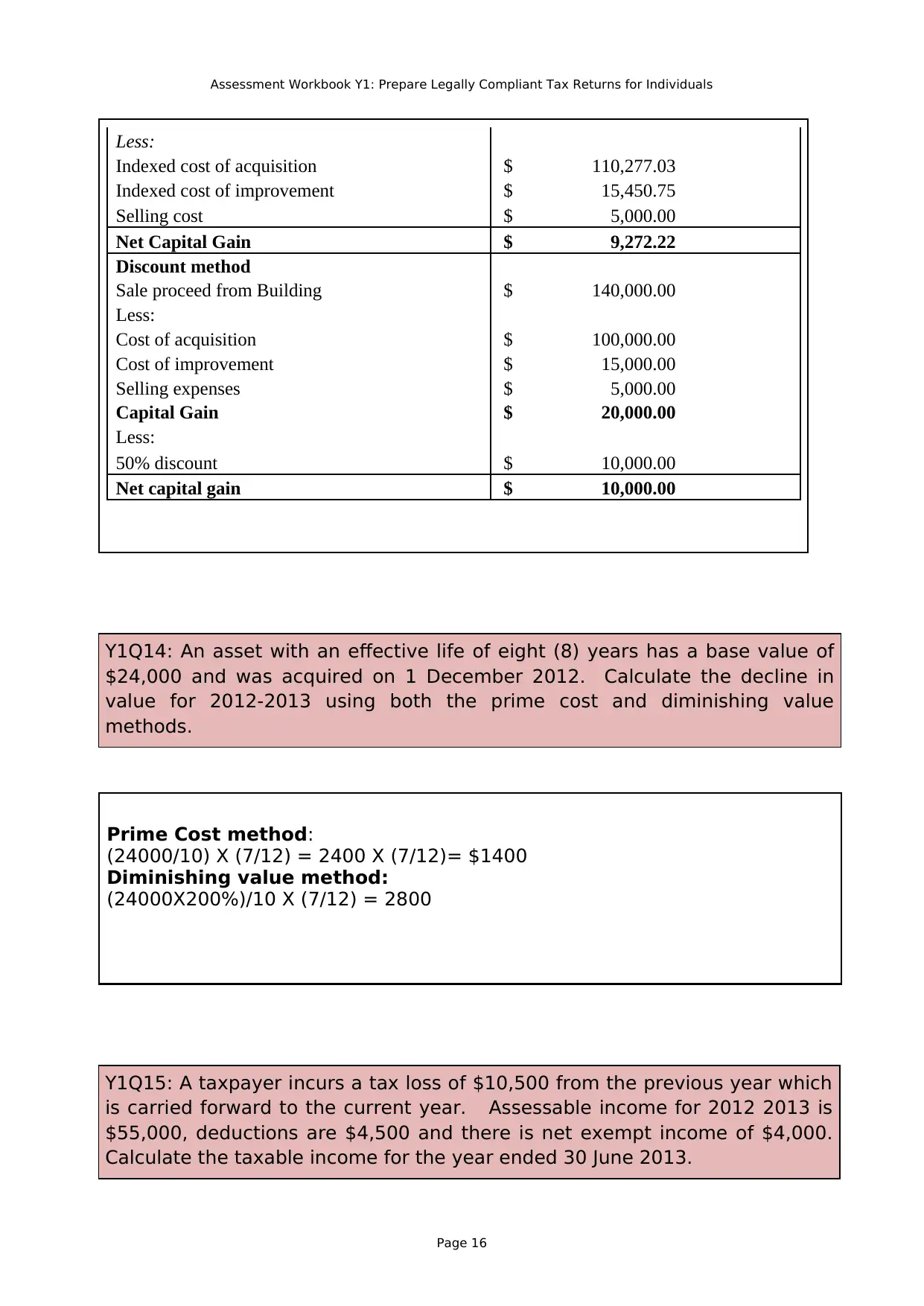
Assessment Workbook Y1: Prepare Legally Compliant Tax Returns for Individuals
Less:
Indexed cost of acquisition $ 110,277.03
Indexed cost of improvement $ 15,450.75
Selling cost $ 5,000.00
Net Capital Gain $ 9,272.22
Discount method
Sale proceed from Building $ 140,000.00
Less:
Cost of acquisition $ 100,000.00
Cost of improvement $ 15,000.00
Selling expenses $ 5,000.00
Capital Gain $ 20,000.00
Less:
50% discount $ 10,000.00
Net capital gain $ 10,000.00
Y1Q14: An asset with an effective life of eight (8) years has a base value of
$24,000 and was acquired on 1 December 2012. Calculate the decline in
value for 2012-2013 using both the prime cost and diminishing value
methods.
Prime Cost method:
(24000/10) X (7/12) = 2400 X (7/12)= $1400
Diminishing value method:
(24000X200%)/10 X (7/12) = 2800
Y1Q15: A taxpayer incurs a tax loss of $10,500 from the previous year which
is carried forward to the current year. Assessable income for 2012 2013 is
$55,000, deductions are $4,500 and there is net exempt income of $4,000.
Calculate the taxable income for the year ended 30 June 2013.
Page 16
Less:
Indexed cost of acquisition $ 110,277.03
Indexed cost of improvement $ 15,450.75
Selling cost $ 5,000.00
Net Capital Gain $ 9,272.22
Discount method
Sale proceed from Building $ 140,000.00
Less:
Cost of acquisition $ 100,000.00
Cost of improvement $ 15,000.00
Selling expenses $ 5,000.00
Capital Gain $ 20,000.00
Less:
50% discount $ 10,000.00
Net capital gain $ 10,000.00
Y1Q14: An asset with an effective life of eight (8) years has a base value of
$24,000 and was acquired on 1 December 2012. Calculate the decline in
value for 2012-2013 using both the prime cost and diminishing value
methods.
Prime Cost method:
(24000/10) X (7/12) = 2400 X (7/12)= $1400
Diminishing value method:
(24000X200%)/10 X (7/12) = 2800
Y1Q15: A taxpayer incurs a tax loss of $10,500 from the previous year which
is carried forward to the current year. Assessable income for 2012 2013 is
$55,000, deductions are $4,500 and there is net exempt income of $4,000.
Calculate the taxable income for the year ended 30 June 2013.
Page 16
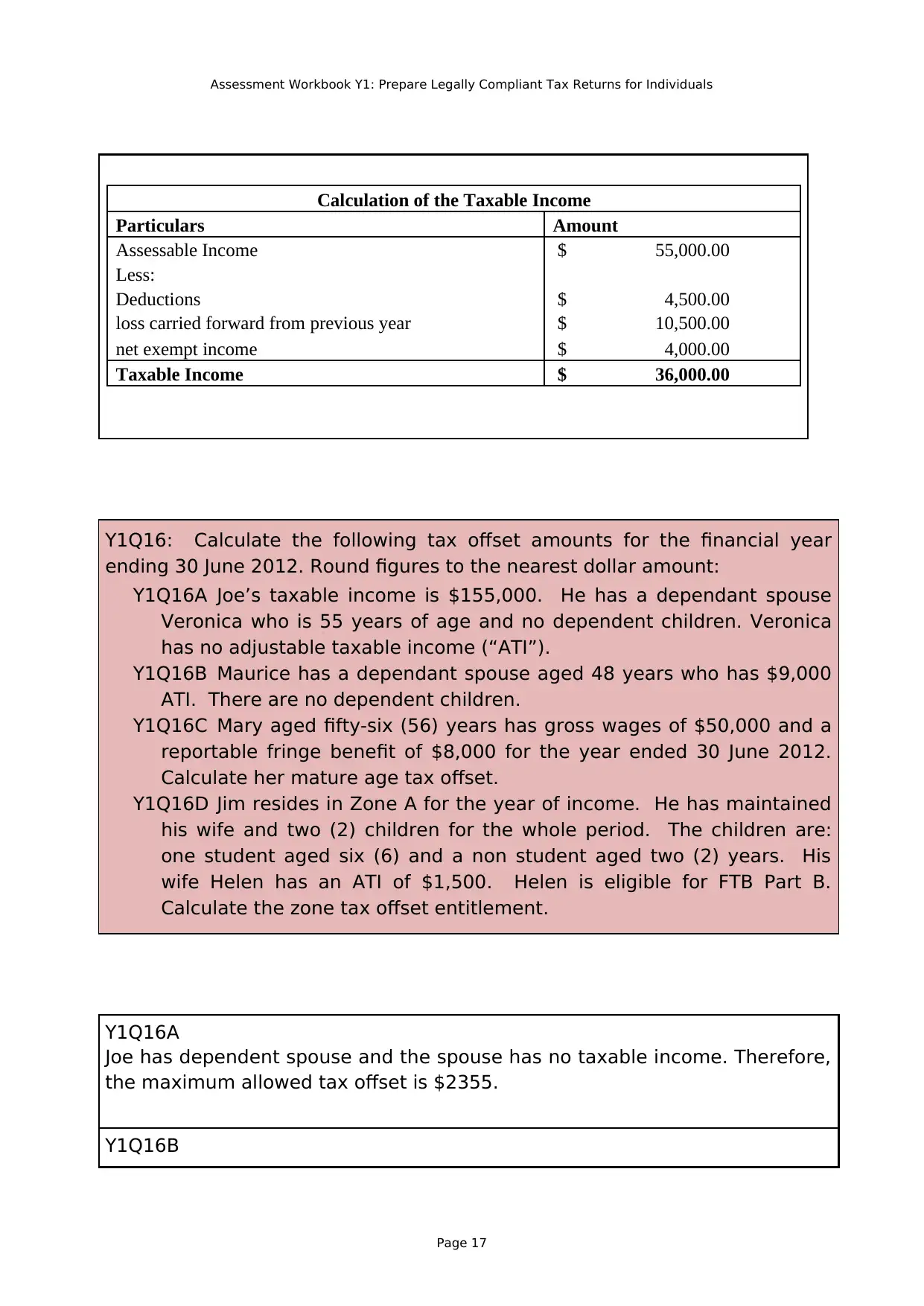
Assessment Workbook Y1: Prepare Legally Compliant Tax Returns for Individuals
Calculation of the Taxable Income
Particulars Amount
Assessable Income $ 55,000.00
Less:
Deductions $ 4,500.00
loss carried forward from previous year $ 10,500.00
net exempt income $ 4,000.00
Taxable Income $ 36,000.00
Y1Q16: Calculate the following tax offset amounts for the financial year
ending 30 June 2012. Round figures to the nearest dollar amount:
Y1Q16A Joe’s taxable income is $155,000. He has a dependant spouse
Veronica who is 55 years of age and no dependent children. Veronica
has no adjustable taxable income (“ATI”).
Y1Q16B Maurice has a dependant spouse aged 48 years who has $9,000
ATI. There are no dependent children.
Y1Q16C Mary aged fifty-six (56) years has gross wages of $50,000 and a
reportable fringe benefit of $8,000 for the year ended 30 June 2012.
Calculate her mature age tax offset.
Y1Q16D Jim resides in Zone A for the year of income. He has maintained
his wife and two (2) children for the whole period. The children are:
one student aged six (6) and a non student aged two (2) years. His
wife Helen has an ATI of $1,500. Helen is eligible for FTB Part B.
Calculate the zone tax offset entitlement.
Y1Q16A
Joe has dependent spouse and the spouse has no taxable income. Therefore,
the maximum allowed tax offset is $2355.
Y1Q16B
Page 17
Calculation of the Taxable Income
Particulars Amount
Assessable Income $ 55,000.00
Less:
Deductions $ 4,500.00
loss carried forward from previous year $ 10,500.00
net exempt income $ 4,000.00
Taxable Income $ 36,000.00
Y1Q16: Calculate the following tax offset amounts for the financial year
ending 30 June 2012. Round figures to the nearest dollar amount:
Y1Q16A Joe’s taxable income is $155,000. He has a dependant spouse
Veronica who is 55 years of age and no dependent children. Veronica
has no adjustable taxable income (“ATI”).
Y1Q16B Maurice has a dependant spouse aged 48 years who has $9,000
ATI. There are no dependent children.
Y1Q16C Mary aged fifty-six (56) years has gross wages of $50,000 and a
reportable fringe benefit of $8,000 for the year ended 30 June 2012.
Calculate her mature age tax offset.
Y1Q16D Jim resides in Zone A for the year of income. He has maintained
his wife and two (2) children for the whole period. The children are:
one student aged six (6) and a non student aged two (2) years. His
wife Helen has an ATI of $1,500. Helen is eligible for FTB Part B.
Calculate the zone tax offset entitlement.
Y1Q16A
Joe has dependent spouse and the spouse has no taxable income. Therefore,
the maximum allowed tax offset is $2355.
Y1Q16B
Page 17
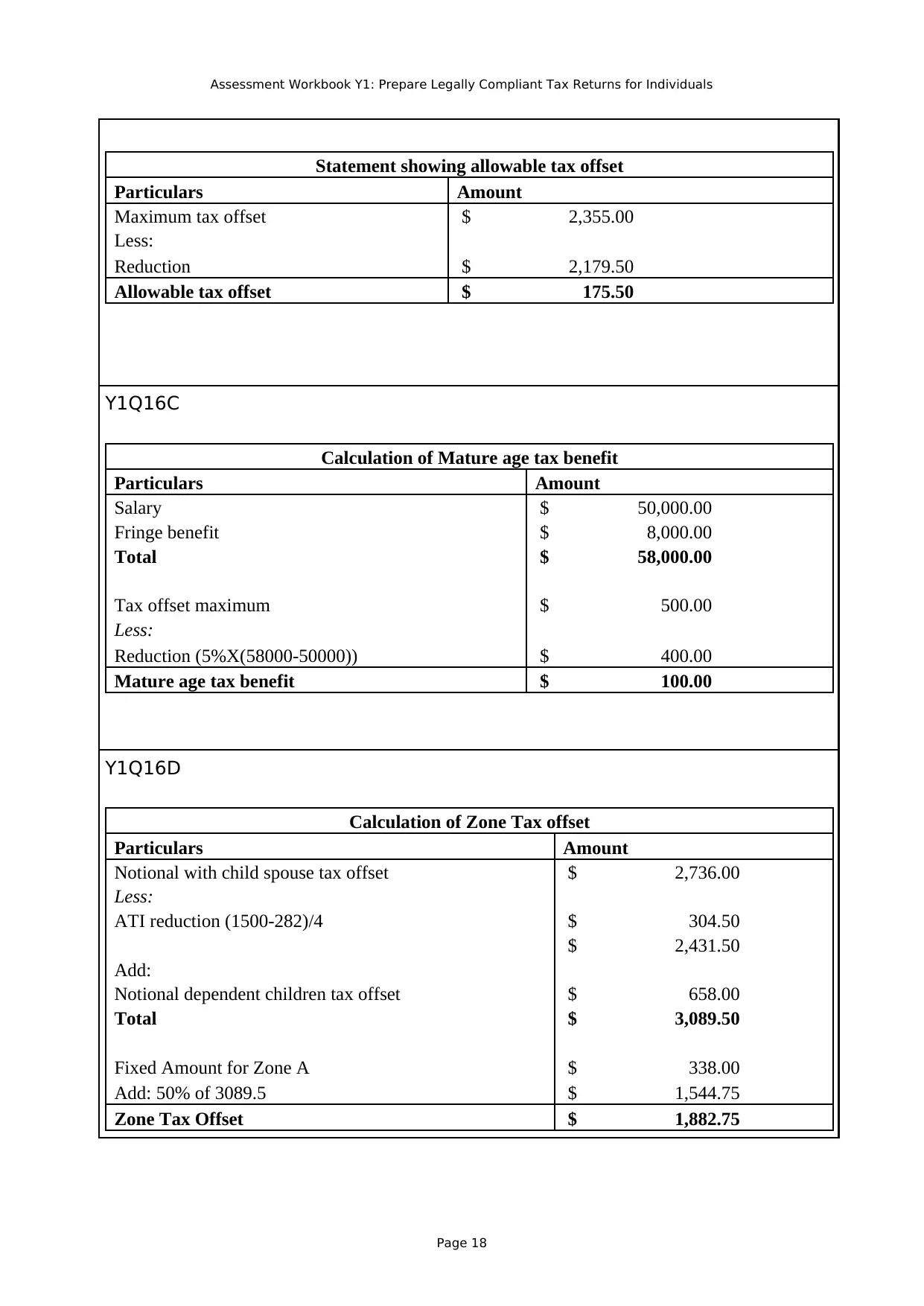
Assessment Workbook Y1: Prepare Legally Compliant Tax Returns for Individuals
Statement showing allowable tax offset
Particulars Amount
Maximum tax offset $ 2,355.00
Less:
Reduction $ 2,179.50
Allowable tax offset $ 175.50
Y1Q16C
Calculation of Mature age tax benefit
Particulars Amount
Salary $ 50,000.00
Fringe benefit $ 8,000.00
Total $ 58,000.00
Tax offset maximum $ 500.00
Less:
Reduction (5%X(58000-50000)) $ 400.00
Mature age tax benefit $ 100.00
Y1Q16D
Calculation of Zone Tax offset
Particulars Amount
Notional with child spouse tax offset $ 2,736.00
Less:
ATI reduction (1500-282)/4 $ 304.50
$ 2,431.50
Add:
Notional dependent children tax offset $ 658.00
Total $ 3,089.50
Fixed Amount for Zone A $ 338.00
Add: 50% of 3089.5 $ 1,544.75
Zone Tax Offset $ 1,882.75
Page 18
Statement showing allowable tax offset
Particulars Amount
Maximum tax offset $ 2,355.00
Less:
Reduction $ 2,179.50
Allowable tax offset $ 175.50
Y1Q16C
Calculation of Mature age tax benefit
Particulars Amount
Salary $ 50,000.00
Fringe benefit $ 8,000.00
Total $ 58,000.00
Tax offset maximum $ 500.00
Less:
Reduction (5%X(58000-50000)) $ 400.00
Mature age tax benefit $ 100.00
Y1Q16D
Calculation of Zone Tax offset
Particulars Amount
Notional with child spouse tax offset $ 2,736.00
Less:
ATI reduction (1500-282)/4 $ 304.50
$ 2,431.50
Add:
Notional dependent children tax offset $ 658.00
Total $ 3,089.50
Fixed Amount for Zone A $ 338.00
Add: 50% of 3089.5 $ 1,544.75
Zone Tax Offset $ 1,882.75
Page 18
Paraphrase This Document
Need a fresh take? Get an instant paraphrase of this document with our AI Paraphraser

Assessment Workbook Y1: Prepare Legally Compliant Tax Returns for Individuals
Y1Q17: Describe the differences between tax avoidance and tax evasion.
Tax avoidance is an illegal method of misusing the system of tax to
reduce the burden of current and future tax liability using such ways that
the parliament has not proposed to do. Whereas Tax evasion is the
process where an individual do not shows his / her real income,
suppresses, or reduced his / her actual income to pay less or no tax.
Y1Q18: Describe the term “tax haven” and the role of the Australian
Transaction Reports and Analysis Centre (“AUSTRAC”) with respect to
monitoring and investigating international transactions and activities.
The countries that provides foreign businesses or individuals a negligible
tax obligation in an environment that is economically as well as politically
steady where very little or no information of financial nature is
communicated with the foreign tax establishments is known as Tax
Haven.
The roles of AUSTRAC are stated below:
Implementation of programs in order to identify and monitor
customers;
Management of risk effectively that are related to money
laundering and terrorism financing;
Reporting those matters that are of suspicious nature;
Submission of an annual compliance statement or report.
Y1Q19: With respect to penalties and shortfalls in tax payments provide
Page 19
Y1Q17: Describe the differences between tax avoidance and tax evasion.
Tax avoidance is an illegal method of misusing the system of tax to
reduce the burden of current and future tax liability using such ways that
the parliament has not proposed to do. Whereas Tax evasion is the
process where an individual do not shows his / her real income,
suppresses, or reduced his / her actual income to pay less or no tax.
Y1Q18: Describe the term “tax haven” and the role of the Australian
Transaction Reports and Analysis Centre (“AUSTRAC”) with respect to
monitoring and investigating international transactions and activities.
The countries that provides foreign businesses or individuals a negligible
tax obligation in an environment that is economically as well as politically
steady where very little or no information of financial nature is
communicated with the foreign tax establishments is known as Tax
Haven.
The roles of AUSTRAC are stated below:
Implementation of programs in order to identify and monitor
customers;
Management of risk effectively that are related to money
laundering and terrorism financing;
Reporting those matters that are of suspicious nature;
Submission of an annual compliance statement or report.
Y1Q19: With respect to penalties and shortfalls in tax payments provide
Page 19
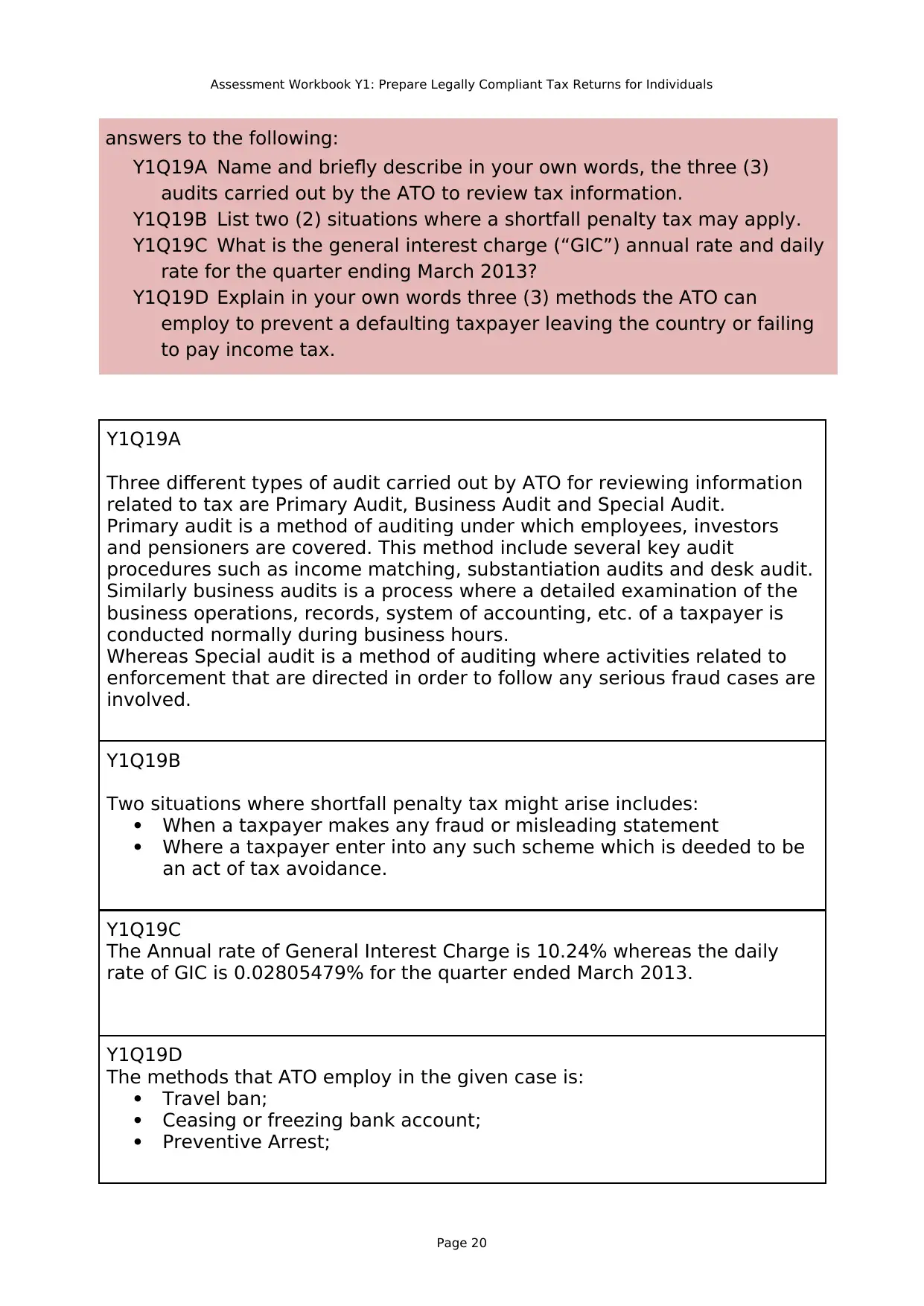
Assessment Workbook Y1: Prepare Legally Compliant Tax Returns for Individuals
answers to the following:
Y1Q19A Name and briefly describe in your own words, the three (3)
audits carried out by the ATO to review tax information.
Y1Q19B List two (2) situations where a shortfall penalty tax may apply.
Y1Q19C What is the general interest charge (“GIC”) annual rate and daily
rate for the quarter ending March 2013?
Y1Q19D Explain in your own words three (3) methods the ATO can
employ to prevent a defaulting taxpayer leaving the country or failing
to pay income tax.
Y1Q19A
Three different types of audit carried out by ATO for reviewing information
related to tax are Primary Audit, Business Audit and Special Audit.
Primary audit is a method of auditing under which employees, investors
and pensioners are covered. This method include several key audit
procedures such as income matching, substantiation audits and desk audit.
Similarly business audits is a process where a detailed examination of the
business operations, records, system of accounting, etc. of a taxpayer is
conducted normally during business hours.
Whereas Special audit is a method of auditing where activities related to
enforcement that are directed in order to follow any serious fraud cases are
involved.
Y1Q19B
Two situations where shortfall penalty tax might arise includes:
When a taxpayer makes any fraud or misleading statement
Where a taxpayer enter into any such scheme which is deeded to be
an act of tax avoidance.
Y1Q19C
The Annual rate of General Interest Charge is 10.24% whereas the daily
rate of GIC is 0.02805479% for the quarter ended March 2013.
Y1Q19D
The methods that ATO employ in the given case is:
Travel ban;
Ceasing or freezing bank account;
Preventive Arrest;
Page 20
answers to the following:
Y1Q19A Name and briefly describe in your own words, the three (3)
audits carried out by the ATO to review tax information.
Y1Q19B List two (2) situations where a shortfall penalty tax may apply.
Y1Q19C What is the general interest charge (“GIC”) annual rate and daily
rate for the quarter ending March 2013?
Y1Q19D Explain in your own words three (3) methods the ATO can
employ to prevent a defaulting taxpayer leaving the country or failing
to pay income tax.
Y1Q19A
Three different types of audit carried out by ATO for reviewing information
related to tax are Primary Audit, Business Audit and Special Audit.
Primary audit is a method of auditing under which employees, investors
and pensioners are covered. This method include several key audit
procedures such as income matching, substantiation audits and desk audit.
Similarly business audits is a process where a detailed examination of the
business operations, records, system of accounting, etc. of a taxpayer is
conducted normally during business hours.
Whereas Special audit is a method of auditing where activities related to
enforcement that are directed in order to follow any serious fraud cases are
involved.
Y1Q19B
Two situations where shortfall penalty tax might arise includes:
When a taxpayer makes any fraud or misleading statement
Where a taxpayer enter into any such scheme which is deeded to be
an act of tax avoidance.
Y1Q19C
The Annual rate of General Interest Charge is 10.24% whereas the daily
rate of GIC is 0.02805479% for the quarter ended March 2013.
Y1Q19D
The methods that ATO employ in the given case is:
Travel ban;
Ceasing or freezing bank account;
Preventive Arrest;
Page 20
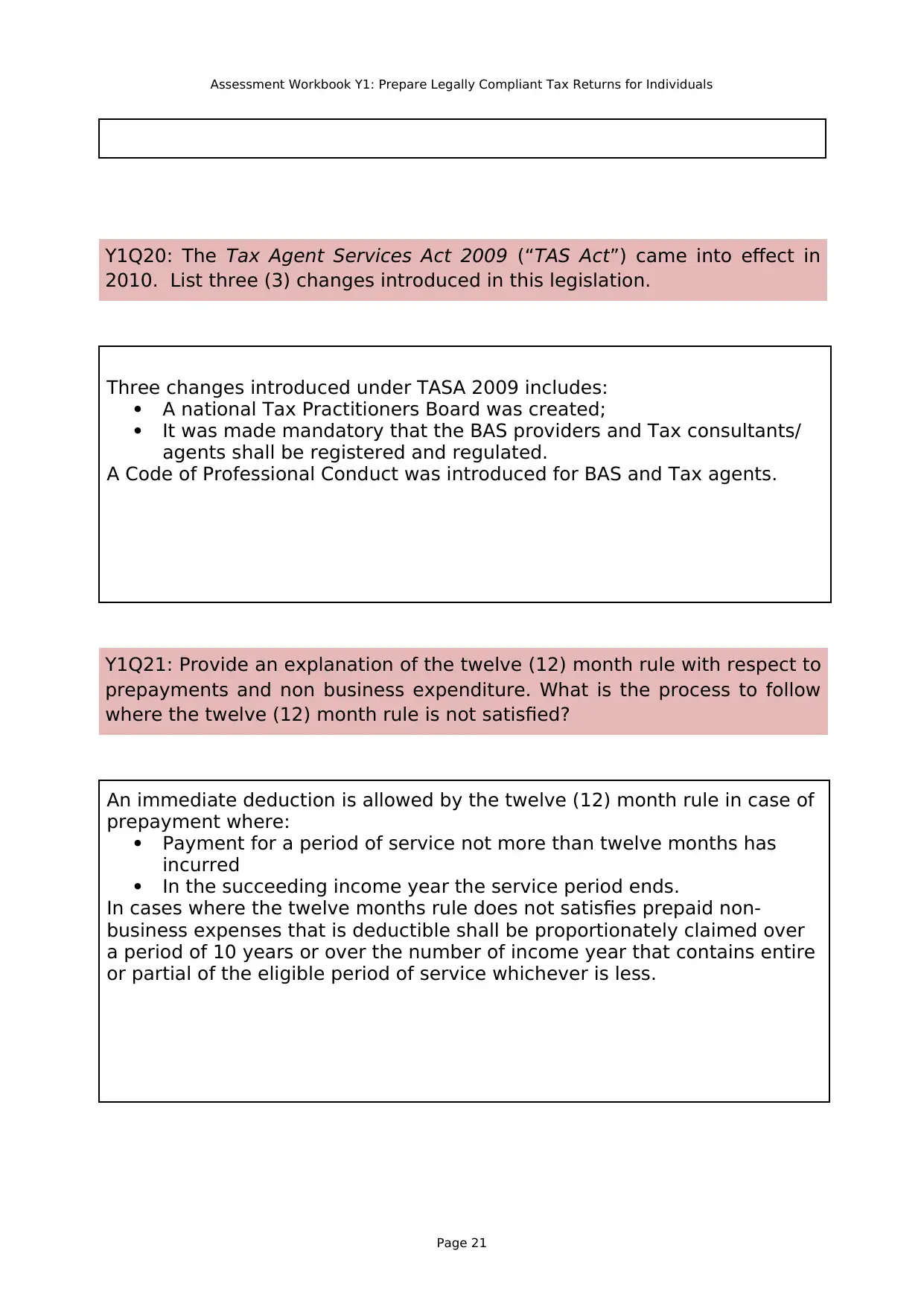
Assessment Workbook Y1: Prepare Legally Compliant Tax Returns for Individuals
Y1Q20: The Tax Agent Services Act 2009 (“TAS Act”) came into effect in
2010. List three (3) changes introduced in this legislation.
Three changes introduced under TASA 2009 includes:
A national Tax Practitioners Board was created;
It was made mandatory that the BAS providers and Tax consultants/
agents shall be registered and regulated.
A Code of Professional Conduct was introduced for BAS and Tax agents.
Y1Q21: Provide an explanation of the twelve (12) month rule with respect to
prepayments and non business expenditure. What is the process to follow
where the twelve (12) month rule is not satisfied?
An immediate deduction is allowed by the twelve (12) month rule in case of
prepayment where:
Payment for a period of service not more than twelve months has
incurred
In the succeeding income year the service period ends.
In cases where the twelve months rule does not satisfies prepaid non-
business expenses that is deductible shall be proportionately claimed over
a period of 10 years or over the number of income year that contains entire
or partial of the eligible period of service whichever is less.
Page 21
Y1Q20: The Tax Agent Services Act 2009 (“TAS Act”) came into effect in
2010. List three (3) changes introduced in this legislation.
Three changes introduced under TASA 2009 includes:
A national Tax Practitioners Board was created;
It was made mandatory that the BAS providers and Tax consultants/
agents shall be registered and regulated.
A Code of Professional Conduct was introduced for BAS and Tax agents.
Y1Q21: Provide an explanation of the twelve (12) month rule with respect to
prepayments and non business expenditure. What is the process to follow
where the twelve (12) month rule is not satisfied?
An immediate deduction is allowed by the twelve (12) month rule in case of
prepayment where:
Payment for a period of service not more than twelve months has
incurred
In the succeeding income year the service period ends.
In cases where the twelve months rule does not satisfies prepaid non-
business expenses that is deductible shall be proportionately claimed over
a period of 10 years or over the number of income year that contains entire
or partial of the eligible period of service whichever is less.
Page 21
Secure Best Marks with AI Grader
Need help grading? Try our AI Grader for instant feedback on your assignments.
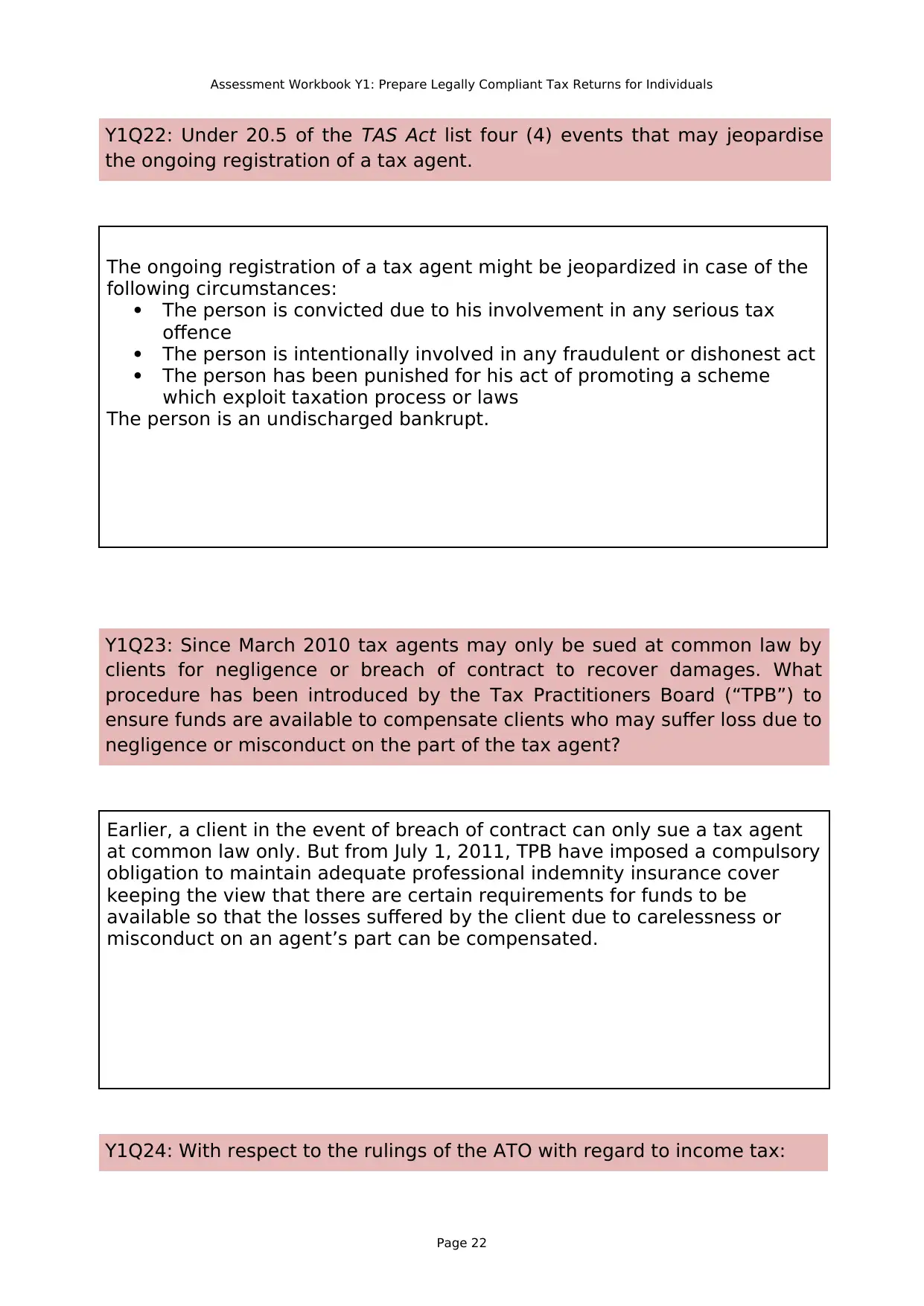
Assessment Workbook Y1: Prepare Legally Compliant Tax Returns for Individuals
Y1Q22: Under 20.5 of the TAS Act list four (4) events that may jeopardise
the ongoing registration of a tax agent.
The ongoing registration of a tax agent might be jeopardized in case of the
following circumstances:
The person is convicted due to his involvement in any serious tax
offence
The person is intentionally involved in any fraudulent or dishonest act
The person has been punished for his act of promoting a scheme
which exploit taxation process or laws
The person is an undischarged bankrupt.
Y1Q23: Since March 2010 tax agents may only be sued at common law by
clients for negligence or breach of contract to recover damages. What
procedure has been introduced by the Tax Practitioners Board (“TPB”) to
ensure funds are available to compensate clients who may suffer loss due to
negligence or misconduct on the part of the tax agent?
Earlier, a client in the event of breach of contract can only sue a tax agent
at common law only. But from July 1, 2011, TPB have imposed a compulsory
obligation to maintain adequate professional indemnity insurance cover
keeping the view that there are certain requirements for funds to be
available so that the losses suffered by the client due to carelessness or
misconduct on an agent’s part can be compensated.
Y1Q24: With respect to the rulings of the ATO with regard to income tax:
Page 22
Y1Q22: Under 20.5 of the TAS Act list four (4) events that may jeopardise
the ongoing registration of a tax agent.
The ongoing registration of a tax agent might be jeopardized in case of the
following circumstances:
The person is convicted due to his involvement in any serious tax
offence
The person is intentionally involved in any fraudulent or dishonest act
The person has been punished for his act of promoting a scheme
which exploit taxation process or laws
The person is an undischarged bankrupt.
Y1Q23: Since March 2010 tax agents may only be sued at common law by
clients for negligence or breach of contract to recover damages. What
procedure has been introduced by the Tax Practitioners Board (“TPB”) to
ensure funds are available to compensate clients who may suffer loss due to
negligence or misconduct on the part of the tax agent?
Earlier, a client in the event of breach of contract can only sue a tax agent
at common law only. But from July 1, 2011, TPB have imposed a compulsory
obligation to maintain adequate professional indemnity insurance cover
keeping the view that there are certain requirements for funds to be
available so that the losses suffered by the client due to carelessness or
misconduct on an agent’s part can be compensated.
Y1Q24: With respect to the rulings of the ATO with regard to income tax:
Page 22
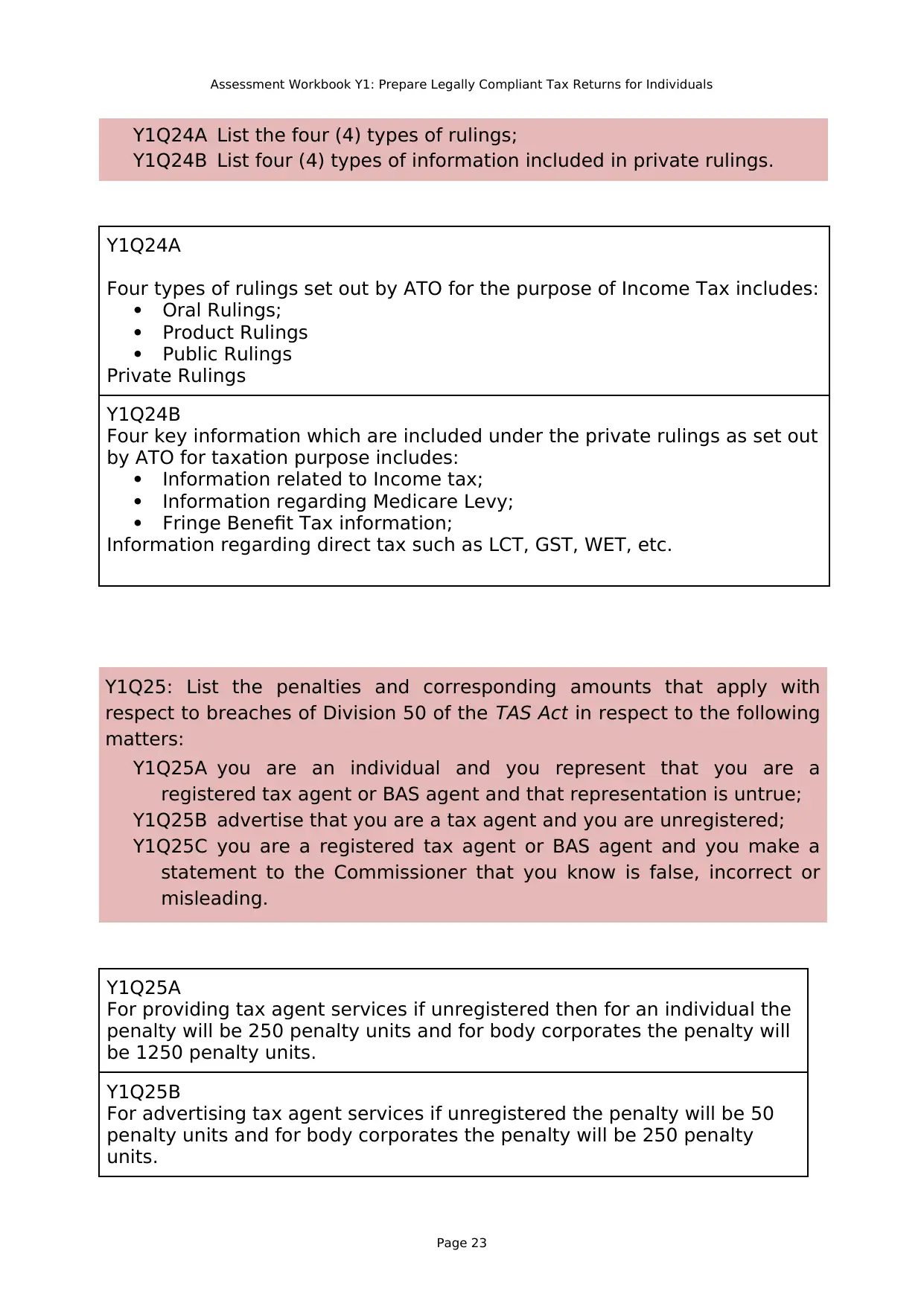
Assessment Workbook Y1: Prepare Legally Compliant Tax Returns for Individuals
Y1Q24A List the four (4) types of rulings;
Y1Q24B List four (4) types of information included in private rulings.
Y1Q24A
Four types of rulings set out by ATO for the purpose of Income Tax includes:
Oral Rulings;
Product Rulings
Public Rulings
Private Rulings
Y1Q24B
Four key information which are included under the private rulings as set out
by ATO for taxation purpose includes:
Information related to Income tax;
Information regarding Medicare Levy;
Fringe Benefit Tax information;
Information regarding direct tax such as LCT, GST, WET, etc.
Y1Q25: List the penalties and corresponding amounts that apply with
respect to breaches of Division 50 of the TAS Act in respect to the following
matters:
Y1Q25A you are an individual and you represent that you are a
registered tax agent or BAS agent and that representation is untrue;
Y1Q25B advertise that you are a tax agent and you are unregistered;
Y1Q25C you are a registered tax agent or BAS agent and you make a
statement to the Commissioner that you know is false, incorrect or
misleading.
Y1Q25A
For providing tax agent services if unregistered then for an individual the
penalty will be 250 penalty units and for body corporates the penalty will
be 1250 penalty units.
Y1Q25B
For advertising tax agent services if unregistered the penalty will be 50
penalty units and for body corporates the penalty will be 250 penalty
units.
Page 23
Y1Q24A List the four (4) types of rulings;
Y1Q24B List four (4) types of information included in private rulings.
Y1Q24A
Four types of rulings set out by ATO for the purpose of Income Tax includes:
Oral Rulings;
Product Rulings
Public Rulings
Private Rulings
Y1Q24B
Four key information which are included under the private rulings as set out
by ATO for taxation purpose includes:
Information related to Income tax;
Information regarding Medicare Levy;
Fringe Benefit Tax information;
Information regarding direct tax such as LCT, GST, WET, etc.
Y1Q25: List the penalties and corresponding amounts that apply with
respect to breaches of Division 50 of the TAS Act in respect to the following
matters:
Y1Q25A you are an individual and you represent that you are a
registered tax agent or BAS agent and that representation is untrue;
Y1Q25B advertise that you are a tax agent and you are unregistered;
Y1Q25C you are a registered tax agent or BAS agent and you make a
statement to the Commissioner that you know is false, incorrect or
misleading.
Y1Q25A
For providing tax agent services if unregistered then for an individual the
penalty will be 250 penalty units and for body corporates the penalty will
be 1250 penalty units.
Y1Q25B
For advertising tax agent services if unregistered the penalty will be 50
penalty units and for body corporates the penalty will be 250 penalty
units.
Page 23
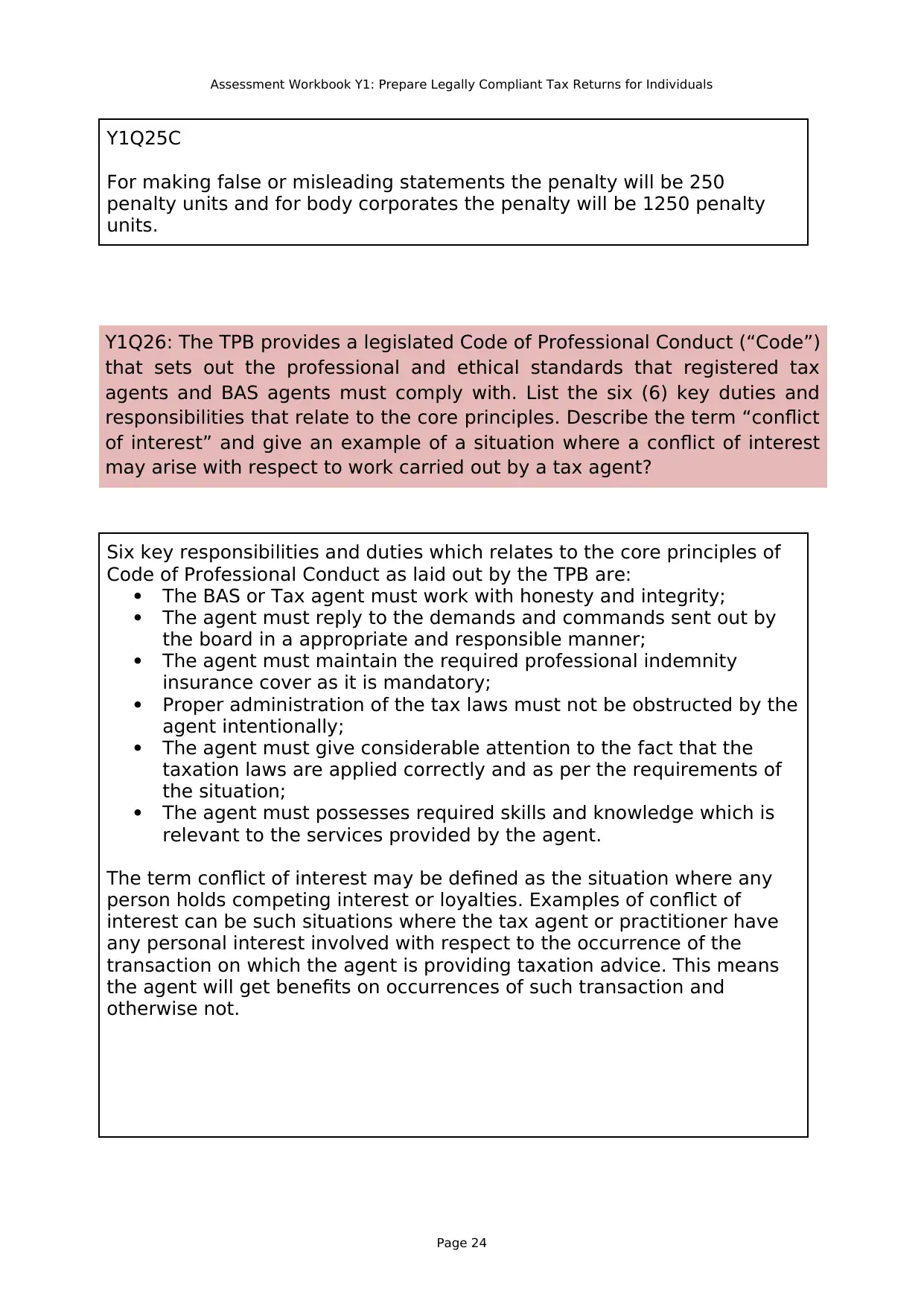
Assessment Workbook Y1: Prepare Legally Compliant Tax Returns for Individuals
Y1Q25C
For making false or misleading statements the penalty will be 250
penalty units and for body corporates the penalty will be 1250 penalty
units.
Y1Q26: The TPB provides a legislated Code of Professional Conduct (“Code”)
that sets out the professional and ethical standards that registered tax
agents and BAS agents must comply with. List the six (6) key duties and
responsibilities that relate to the core principles. Describe the term “conflict
of interest” and give an example of a situation where a conflict of interest
may arise with respect to work carried out by a tax agent?
Six key responsibilities and duties which relates to the core principles of
Code of Professional Conduct as laid out by the TPB are:
The BAS or Tax agent must work with honesty and integrity;
The agent must reply to the demands and commands sent out by
the board in a appropriate and responsible manner;
The agent must maintain the required professional indemnity
insurance cover as it is mandatory;
Proper administration of the tax laws must not be obstructed by the
agent intentionally;
The agent must give considerable attention to the fact that the
taxation laws are applied correctly and as per the requirements of
the situation;
The agent must possesses required skills and knowledge which is
relevant to the services provided by the agent.
The term conflict of interest may be defined as the situation where any
person holds competing interest or loyalties. Examples of conflict of
interest can be such situations where the tax agent or practitioner have
any personal interest involved with respect to the occurrence of the
transaction on which the agent is providing taxation advice. This means
the agent will get benefits on occurrences of such transaction and
otherwise not.
Page 24
Y1Q25C
For making false or misleading statements the penalty will be 250
penalty units and for body corporates the penalty will be 1250 penalty
units.
Y1Q26: The TPB provides a legislated Code of Professional Conduct (“Code”)
that sets out the professional and ethical standards that registered tax
agents and BAS agents must comply with. List the six (6) key duties and
responsibilities that relate to the core principles. Describe the term “conflict
of interest” and give an example of a situation where a conflict of interest
may arise with respect to work carried out by a tax agent?
Six key responsibilities and duties which relates to the core principles of
Code of Professional Conduct as laid out by the TPB are:
The BAS or Tax agent must work with honesty and integrity;
The agent must reply to the demands and commands sent out by
the board in a appropriate and responsible manner;
The agent must maintain the required professional indemnity
insurance cover as it is mandatory;
Proper administration of the tax laws must not be obstructed by the
agent intentionally;
The agent must give considerable attention to the fact that the
taxation laws are applied correctly and as per the requirements of
the situation;
The agent must possesses required skills and knowledge which is
relevant to the services provided by the agent.
The term conflict of interest may be defined as the situation where any
person holds competing interest or loyalties. Examples of conflict of
interest can be such situations where the tax agent or practitioner have
any personal interest involved with respect to the occurrence of the
transaction on which the agent is providing taxation advice. This means
the agent will get benefits on occurrences of such transaction and
otherwise not.
Page 24
Paraphrase This Document
Need a fresh take? Get an instant paraphrase of this document with our AI Paraphraser
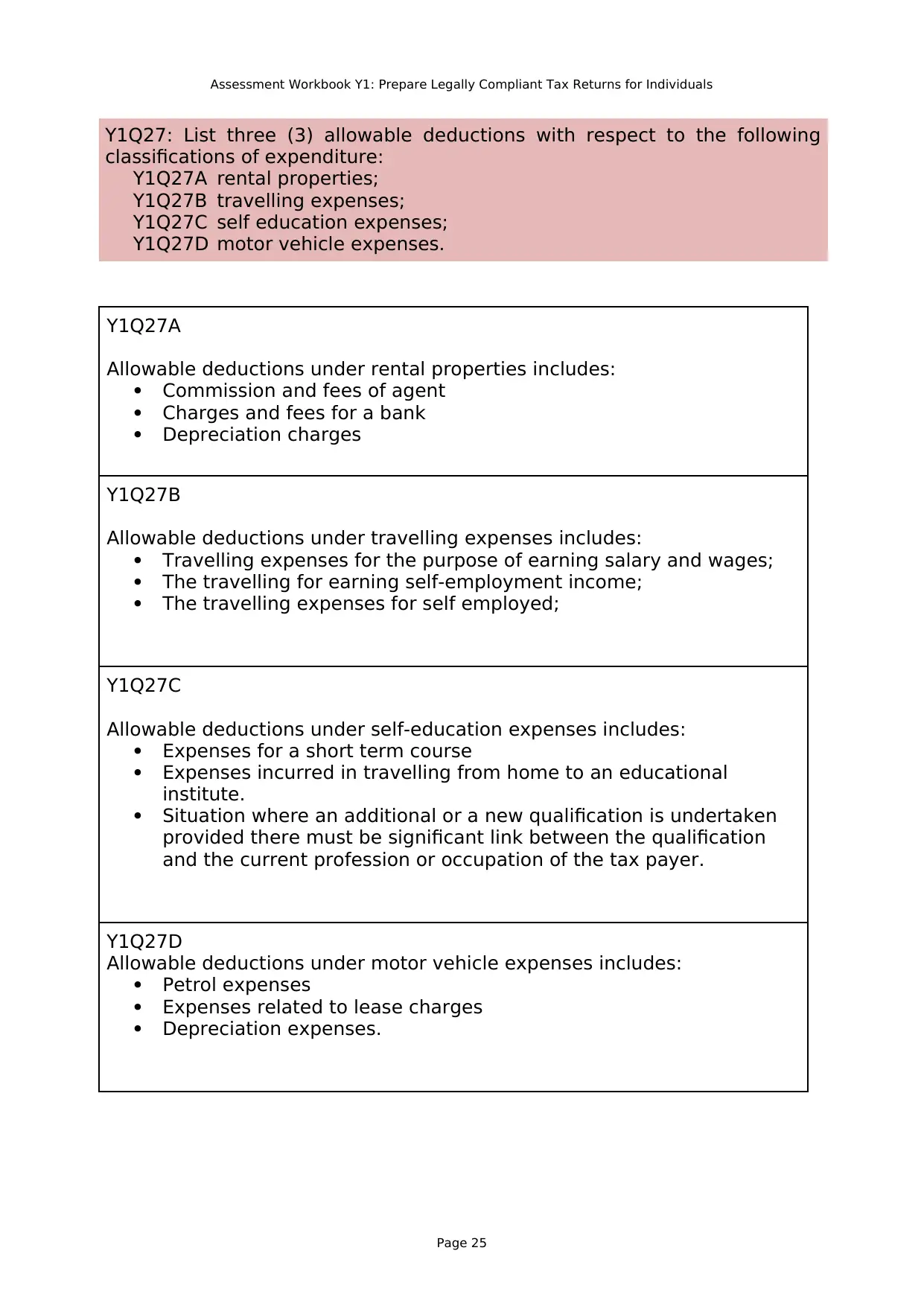
Assessment Workbook Y1: Prepare Legally Compliant Tax Returns for Individuals
Y1Q27: List three (3) allowable deductions with respect to the following
classifications of expenditure:
Y1Q27A rental properties;
Y1Q27B travelling expenses;
Y1Q27C self education expenses;
Y1Q27D motor vehicle expenses.
Y1Q27A
Allowable deductions under rental properties includes:
Commission and fees of agent
Charges and fees for a bank
Depreciation charges
Y1Q27B
Allowable deductions under travelling expenses includes:
Travelling expenses for the purpose of earning salary and wages;
The travelling for earning self-employment income;
The travelling expenses for self employed;
Y1Q27C
Allowable deductions under self-education expenses includes:
Expenses for a short term course
Expenses incurred in travelling from home to an educational
institute.
Situation where an additional or a new qualification is undertaken
provided there must be significant link between the qualification
and the current profession or occupation of the tax payer.
Y1Q27D
Allowable deductions under motor vehicle expenses includes:
Petrol expenses
Expenses related to lease charges
Depreciation expenses.
Page 25
Y1Q27: List three (3) allowable deductions with respect to the following
classifications of expenditure:
Y1Q27A rental properties;
Y1Q27B travelling expenses;
Y1Q27C self education expenses;
Y1Q27D motor vehicle expenses.
Y1Q27A
Allowable deductions under rental properties includes:
Commission and fees of agent
Charges and fees for a bank
Depreciation charges
Y1Q27B
Allowable deductions under travelling expenses includes:
Travelling expenses for the purpose of earning salary and wages;
The travelling for earning self-employment income;
The travelling expenses for self employed;
Y1Q27C
Allowable deductions under self-education expenses includes:
Expenses for a short term course
Expenses incurred in travelling from home to an educational
institute.
Situation where an additional or a new qualification is undertaken
provided there must be significant link between the qualification
and the current profession or occupation of the tax payer.
Y1Q27D
Allowable deductions under motor vehicle expenses includes:
Petrol expenses
Expenses related to lease charges
Depreciation expenses.
Page 25
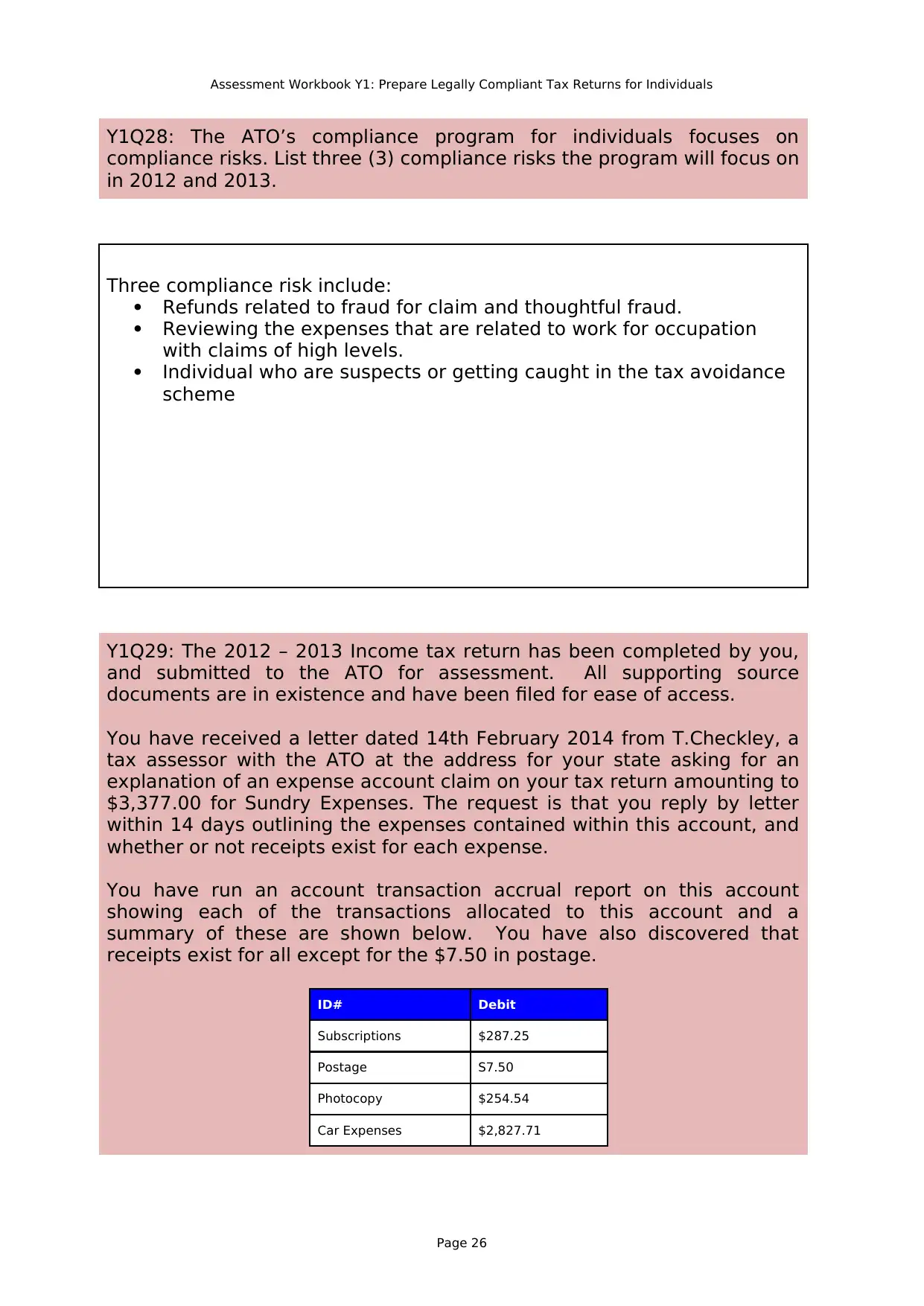
Assessment Workbook Y1: Prepare Legally Compliant Tax Returns for Individuals
Y1Q28: The ATO’s compliance program for individuals focuses on
compliance risks. List three (3) compliance risks the program will focus on
in 2012 and 2013.
Three compliance risk include:
Refunds related to fraud for claim and thoughtful fraud.
Reviewing the expenses that are related to work for occupation
with claims of high levels.
Individual who are suspects or getting caught in the tax avoidance
scheme
Y1Q29: The 2012 – 2013 Income tax return has been completed by you,
and submitted to the ATO for assessment. All supporting source
documents are in existence and have been filed for ease of access.
You have received a letter dated 14th February 2014 from T.Checkley, a
tax assessor with the ATO at the address for your state asking for an
explanation of an expense account claim on your tax return amounting to
$3,377.00 for Sundry Expenses. The request is that you reply by letter
within 14 days outlining the expenses contained within this account, and
whether or not receipts exist for each expense.
You have run an account transaction accrual report on this account
showing each of the transactions allocated to this account and a
summary of these are shown below. You have also discovered that
receipts exist for all except for the $7.50 in postage.
ID# Debit
Subscriptions $287.25
Postage S7.50
Photocopy $254.54
Car Expenses $2,827.71
Page 26
Y1Q28: The ATO’s compliance program for individuals focuses on
compliance risks. List three (3) compliance risks the program will focus on
in 2012 and 2013.
Three compliance risk include:
Refunds related to fraud for claim and thoughtful fraud.
Reviewing the expenses that are related to work for occupation
with claims of high levels.
Individual who are suspects or getting caught in the tax avoidance
scheme
Y1Q29: The 2012 – 2013 Income tax return has been completed by you,
and submitted to the ATO for assessment. All supporting source
documents are in existence and have been filed for ease of access.
You have received a letter dated 14th February 2014 from T.Checkley, a
tax assessor with the ATO at the address for your state asking for an
explanation of an expense account claim on your tax return amounting to
$3,377.00 for Sundry Expenses. The request is that you reply by letter
within 14 days outlining the expenses contained within this account, and
whether or not receipts exist for each expense.
You have run an account transaction accrual report on this account
showing each of the transactions allocated to this account and a
summary of these are shown below. You have also discovered that
receipts exist for all except for the $7.50 in postage.
ID# Debit
Subscriptions $287.25
Postage S7.50
Photocopy $254.54
Car Expenses $2,827.71
Page 26

Assessment Workbook Y1: Prepare Legally Compliant Tax Returns for Individuals
S3,377.00
Write the reply letter within 14 days outlining the expenses contained
within this account, and whether or not receipts exist for each expense.
Dear T. Checkley,
This letter in addressed in reply of the verifications of the necessary
evidences relating to the above accounts, and I would like to inform you
that all the proper documents such as the receipts for subscriptions of
$287.25, Photocopy receipts of $254.54 and car expenses invoices of
$2,827.71 are held with me and are equally authentic as well. Only
documents relate to postage of $7.50 is not available. Thus I would like to
request you to process the claim of the above mentioned accounts or
transaction for which necessary documents and proofs are available.
Y1Q30:
You have been asked to access loan information for the purchase of a new
high speed photocopier costing $16,500. The following quotes have been
provided by 2 finance providers, please recommend the most appropriate
loan and the reasons for your choice.
Loan A Loan B
Amount Borrowed 16,500.00 16,500.00
Interest Rate 11.75% 11.48%
Term of the loan - Months 36 48
Page 27
S3,377.00
Write the reply letter within 14 days outlining the expenses contained
within this account, and whether or not receipts exist for each expense.
Dear T. Checkley,
This letter in addressed in reply of the verifications of the necessary
evidences relating to the above accounts, and I would like to inform you
that all the proper documents such as the receipts for subscriptions of
$287.25, Photocopy receipts of $254.54 and car expenses invoices of
$2,827.71 are held with me and are equally authentic as well. Only
documents relate to postage of $7.50 is not available. Thus I would like to
request you to process the claim of the above mentioned accounts or
transaction for which necessary documents and proofs are available.
Y1Q30:
You have been asked to access loan information for the purchase of a new
high speed photocopier costing $16,500. The following quotes have been
provided by 2 finance providers, please recommend the most appropriate
loan and the reasons for your choice.
Loan A Loan B
Amount Borrowed 16,500.00 16,500.00
Interest Rate 11.75% 11.48%
Term of the loan - Months 36 48
Page 27
Secure Best Marks with AI Grader
Need help grading? Try our AI Grader for instant feedback on your assignments.

Assessment Workbook Y1: Prepare Legally Compliant Tax Returns for Individuals
Borrowing Costs 360.00 360.00
Monthly Repayments 556.00 438.00
Particulars Loan A Loan B
Amount Borrowed 16,500.00 16,500.0
0
Term of the loan - Months 36 48
Monthly Repayments 556 438
Total Amount Repaid 20016 21024
Interest cost 3,516.00 4,524.00
Therefore it can be said that Loan A should be selected as the cost is low.
Page 28
Borrowing Costs 360.00 360.00
Monthly Repayments 556.00 438.00
Particulars Loan A Loan B
Amount Borrowed 16,500.00 16,500.0
0
Term of the loan - Months 36 48
Monthly Repayments 556 438
Total Amount Repaid 20016 21024
Interest cost 3,516.00 4,524.00
Therefore it can be said that Loan A should be selected as the cost is low.
Page 28
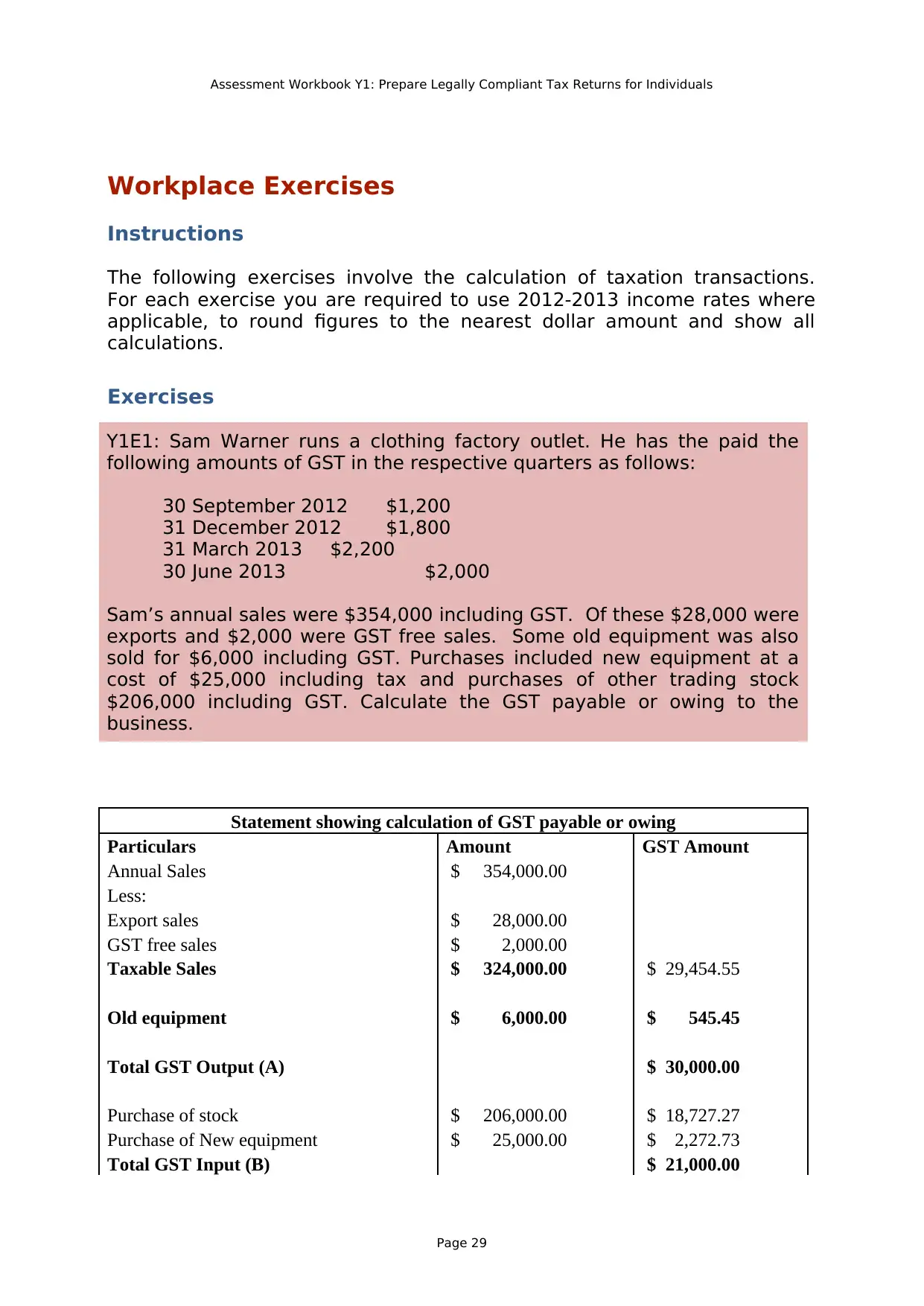
Assessment Workbook Y1: Prepare Legally Compliant Tax Returns for Individuals
Workplace Exercises
Instructions
The following exercises involve the calculation of taxation transactions.
For each exercise you are required to use 2012-2013 income rates where
applicable, to round figures to the nearest dollar amount and show all
calculations.
Exercises
Y1E1: Sam Warner runs a clothing factory outlet. He has the paid the
following amounts of GST in the respective quarters as follows:
30 September 2012 $1,200
31 December 2012 $1,800
31 March 2013 $2,200
30 June 2013 $2,000
Sam’s annual sales were $354,000 including GST. Of these $28,000 were
exports and $2,000 were GST free sales. Some old equipment was also
sold for $6,000 including GST. Purchases included new equipment at a
cost of $25,000 including tax and purchases of other trading stock
$206,000 including GST. Calculate the GST payable or owing to the
business.
Statement showing calculation of GST payable or owing
Particulars Amount GST Amount
Annual Sales $ 354,000.00
Less:
Export sales $ 28,000.00
GST free sales $ 2,000.00
Taxable Sales $ 324,000.00 $ 29,454.55
Old equipment $ 6,000.00 $ 545.45
Total GST Output (A) $ 30,000.00
Purchase of stock $ 206,000.00 $ 18,727.27
Purchase of New equipment $ 25,000.00 $ 2,272.73
Total GST Input (B) $ 21,000.00
Page 29
Workplace Exercises
Instructions
The following exercises involve the calculation of taxation transactions.
For each exercise you are required to use 2012-2013 income rates where
applicable, to round figures to the nearest dollar amount and show all
calculations.
Exercises
Y1E1: Sam Warner runs a clothing factory outlet. He has the paid the
following amounts of GST in the respective quarters as follows:
30 September 2012 $1,200
31 December 2012 $1,800
31 March 2013 $2,200
30 June 2013 $2,000
Sam’s annual sales were $354,000 including GST. Of these $28,000 were
exports and $2,000 were GST free sales. Some old equipment was also
sold for $6,000 including GST. Purchases included new equipment at a
cost of $25,000 including tax and purchases of other trading stock
$206,000 including GST. Calculate the GST payable or owing to the
business.
Statement showing calculation of GST payable or owing
Particulars Amount GST Amount
Annual Sales $ 354,000.00
Less:
Export sales $ 28,000.00
GST free sales $ 2,000.00
Taxable Sales $ 324,000.00 $ 29,454.55
Old equipment $ 6,000.00 $ 545.45
Total GST Output (A) $ 30,000.00
Purchase of stock $ 206,000.00 $ 18,727.27
Purchase of New equipment $ 25,000.00 $ 2,272.73
Total GST Input (B) $ 21,000.00
Page 29
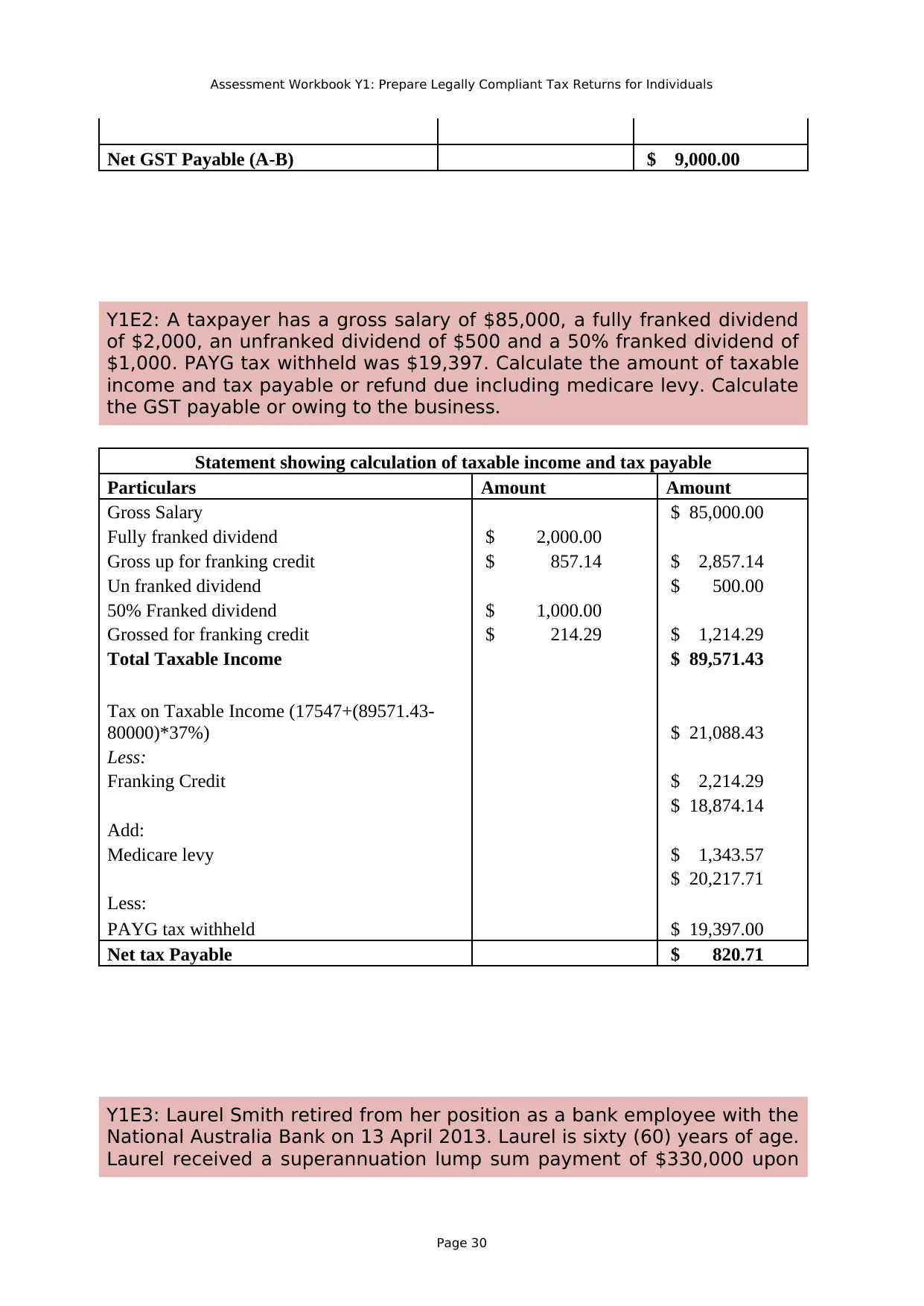
Assessment Workbook Y1: Prepare Legally Compliant Tax Returns for Individuals
Net GST Payable (A-B) $ 9,000.00
Y1E2: A taxpayer has a gross salary of $85,000, a fully franked dividend
of $2,000, an unfranked dividend of $500 and a 50% franked dividend of
$1,000. PAYG tax withheld was $19,397. Calculate the amount of taxable
income and tax payable or refund due including medicare levy. Calculate
the GST payable or owing to the business.
Statement showing calculation of taxable income and tax payable
Particulars Amount Amount
Gross Salary $ 85,000.00
Fully franked dividend $ 2,000.00
Gross up for franking credit $ 857.14 $ 2,857.14
Un franked dividend $ 500.00
50% Franked dividend $ 1,000.00
Grossed for franking credit $ 214.29 $ 1,214.29
Total Taxable Income $ 89,571.43
Tax on Taxable Income (17547+(89571.43-
80000)*37%) $ 21,088.43
Less:
Franking Credit $ 2,214.29
$ 18,874.14
Add:
Medicare levy $ 1,343.57
$ 20,217.71
Less:
PAYG tax withheld $ 19,397.00
Net tax Payable $ 820.71
Y1E3: Laurel Smith retired from her position as a bank employee with the
National Australia Bank on 13 April 2013. Laurel is sixty (60) years of age.
Laurel received a superannuation lump sum payment of $330,000 upon
Page 30
Net GST Payable (A-B) $ 9,000.00
Y1E2: A taxpayer has a gross salary of $85,000, a fully franked dividend
of $2,000, an unfranked dividend of $500 and a 50% franked dividend of
$1,000. PAYG tax withheld was $19,397. Calculate the amount of taxable
income and tax payable or refund due including medicare levy. Calculate
the GST payable or owing to the business.
Statement showing calculation of taxable income and tax payable
Particulars Amount Amount
Gross Salary $ 85,000.00
Fully franked dividend $ 2,000.00
Gross up for franking credit $ 857.14 $ 2,857.14
Un franked dividend $ 500.00
50% Franked dividend $ 1,000.00
Grossed for franking credit $ 214.29 $ 1,214.29
Total Taxable Income $ 89,571.43
Tax on Taxable Income (17547+(89571.43-
80000)*37%) $ 21,088.43
Less:
Franking Credit $ 2,214.29
$ 18,874.14
Add:
Medicare levy $ 1,343.57
$ 20,217.71
Less:
PAYG tax withheld $ 19,397.00
Net tax Payable $ 820.71
Y1E3: Laurel Smith retired from her position as a bank employee with the
National Australia Bank on 13 April 2013. Laurel is sixty (60) years of age.
Laurel received a superannuation lump sum payment of $330,000 upon
Page 30
Paraphrase This Document
Need a fresh take? Get an instant paraphrase of this document with our AI Paraphraser
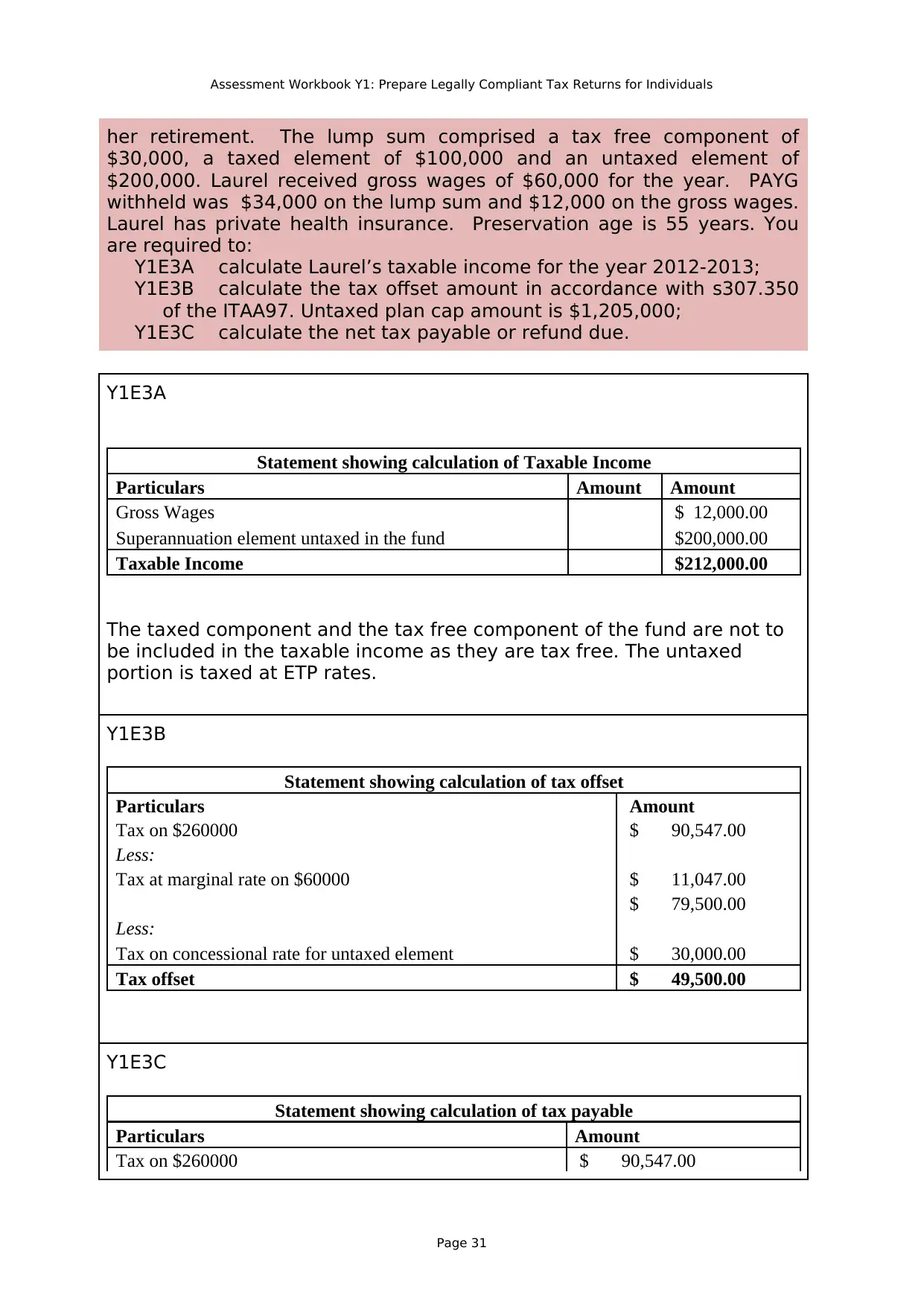
Assessment Workbook Y1: Prepare Legally Compliant Tax Returns for Individuals
her retirement. The lump sum comprised a tax free component of
$30,000, a taxed element of $100,000 and an untaxed element of
$200,000. Laurel received gross wages of $60,000 for the year. PAYG
withheld was $34,000 on the lump sum and $12,000 on the gross wages.
Laurel has private health insurance. Preservation age is 55 years. You
are required to:
Y1E3A calculate Laurel’s taxable income for the year 2012-2013;
Y1E3B calculate the tax offset amount in accordance with s307.350
of the ITAA97. Untaxed plan cap amount is $1,205,000;
Y1E3C calculate the net tax payable or refund due.
Y1E3A
Statement showing calculation of Taxable Income
Particulars Amount Amount
Gross Wages $ 12,000.00
Superannuation element untaxed in the fund $200,000.00
Taxable Income $212,000.00
The taxed component and the tax free component of the fund are not to
be included in the taxable income as they are tax free. The untaxed
portion is taxed at ETP rates.
Y1E3B
Statement showing calculation of tax offset
Particulars Amount
Tax on $260000 $ 90,547.00
Less:
Tax at marginal rate on $60000 $ 11,047.00
$ 79,500.00
Less:
Tax on concessional rate for untaxed element $ 30,000.00
Tax offset $ 49,500.00
Y1E3C
Statement showing calculation of tax payable
Particulars Amount
Tax on $260000 $ 90,547.00
Page 31
her retirement. The lump sum comprised a tax free component of
$30,000, a taxed element of $100,000 and an untaxed element of
$200,000. Laurel received gross wages of $60,000 for the year. PAYG
withheld was $34,000 on the lump sum and $12,000 on the gross wages.
Laurel has private health insurance. Preservation age is 55 years. You
are required to:
Y1E3A calculate Laurel’s taxable income for the year 2012-2013;
Y1E3B calculate the tax offset amount in accordance with s307.350
of the ITAA97. Untaxed plan cap amount is $1,205,000;
Y1E3C calculate the net tax payable or refund due.
Y1E3A
Statement showing calculation of Taxable Income
Particulars Amount Amount
Gross Wages $ 12,000.00
Superannuation element untaxed in the fund $200,000.00
Taxable Income $212,000.00
The taxed component and the tax free component of the fund are not to
be included in the taxable income as they are tax free. The untaxed
portion is taxed at ETP rates.
Y1E3B
Statement showing calculation of tax offset
Particulars Amount
Tax on $260000 $ 90,547.00
Less:
Tax at marginal rate on $60000 $ 11,047.00
$ 79,500.00
Less:
Tax on concessional rate for untaxed element $ 30,000.00
Tax offset $ 49,500.00
Y1E3C
Statement showing calculation of tax payable
Particulars Amount
Tax on $260000 $ 90,547.00
Page 31
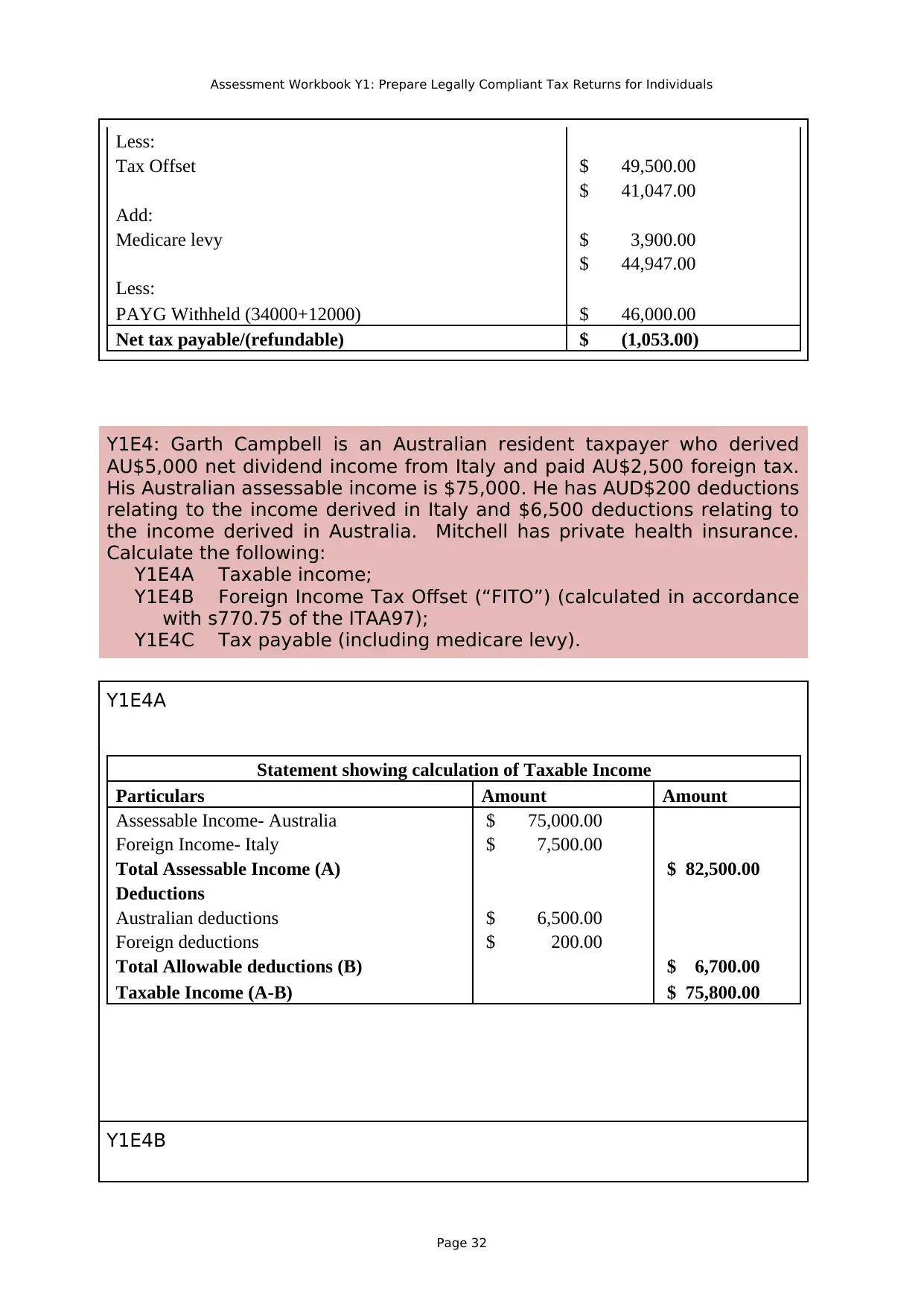
Assessment Workbook Y1: Prepare Legally Compliant Tax Returns for Individuals
Less:
Tax Offset $ 49,500.00
$ 41,047.00
Add:
Medicare levy $ 3,900.00
$ 44,947.00
Less:
PAYG Withheld (34000+12000) $ 46,000.00
Net tax payable/(refundable) $ (1,053.00)
Y1E4: Garth Campbell is an Australian resident taxpayer who derived
AU$5,000 net dividend income from Italy and paid AU$2,500 foreign tax.
His Australian assessable income is $75,000. He has AUD$200 deductions
relating to the income derived in Italy and $6,500 deductions relating to
the income derived in Australia. Mitchell has private health insurance.
Calculate the following:
Y1E4A Taxable income;
Y1E4B Foreign Income Tax Offset (“FITO”) (calculated in accordance
with s770.75 of the ITAA97);
Y1E4C Tax payable (including medicare levy).
Y1E4A
Statement showing calculation of Taxable Income
Particulars Amount Amount
Assessable Income- Australia $ 75,000.00
Foreign Income- Italy $ 7,500.00
Total Assessable Income (A) $ 82,500.00
Deductions
Australian deductions $ 6,500.00
Foreign deductions $ 200.00
Total Allowable deductions (B) $ 6,700.00
Taxable Income (A-B) $ 75,800.00
Y1E4B
Page 32
Less:
Tax Offset $ 49,500.00
$ 41,047.00
Add:
Medicare levy $ 3,900.00
$ 44,947.00
Less:
PAYG Withheld (34000+12000) $ 46,000.00
Net tax payable/(refundable) $ (1,053.00)
Y1E4: Garth Campbell is an Australian resident taxpayer who derived
AU$5,000 net dividend income from Italy and paid AU$2,500 foreign tax.
His Australian assessable income is $75,000. He has AUD$200 deductions
relating to the income derived in Italy and $6,500 deductions relating to
the income derived in Australia. Mitchell has private health insurance.
Calculate the following:
Y1E4A Taxable income;
Y1E4B Foreign Income Tax Offset (“FITO”) (calculated in accordance
with s770.75 of the ITAA97);
Y1E4C Tax payable (including medicare levy).
Y1E4A
Statement showing calculation of Taxable Income
Particulars Amount Amount
Assessable Income- Australia $ 75,000.00
Foreign Income- Italy $ 7,500.00
Total Assessable Income (A) $ 82,500.00
Deductions
Australian deductions $ 6,500.00
Foreign deductions $ 200.00
Total Allowable deductions (B) $ 6,700.00
Taxable Income (A-B) $ 75,800.00
Y1E4B
Page 32
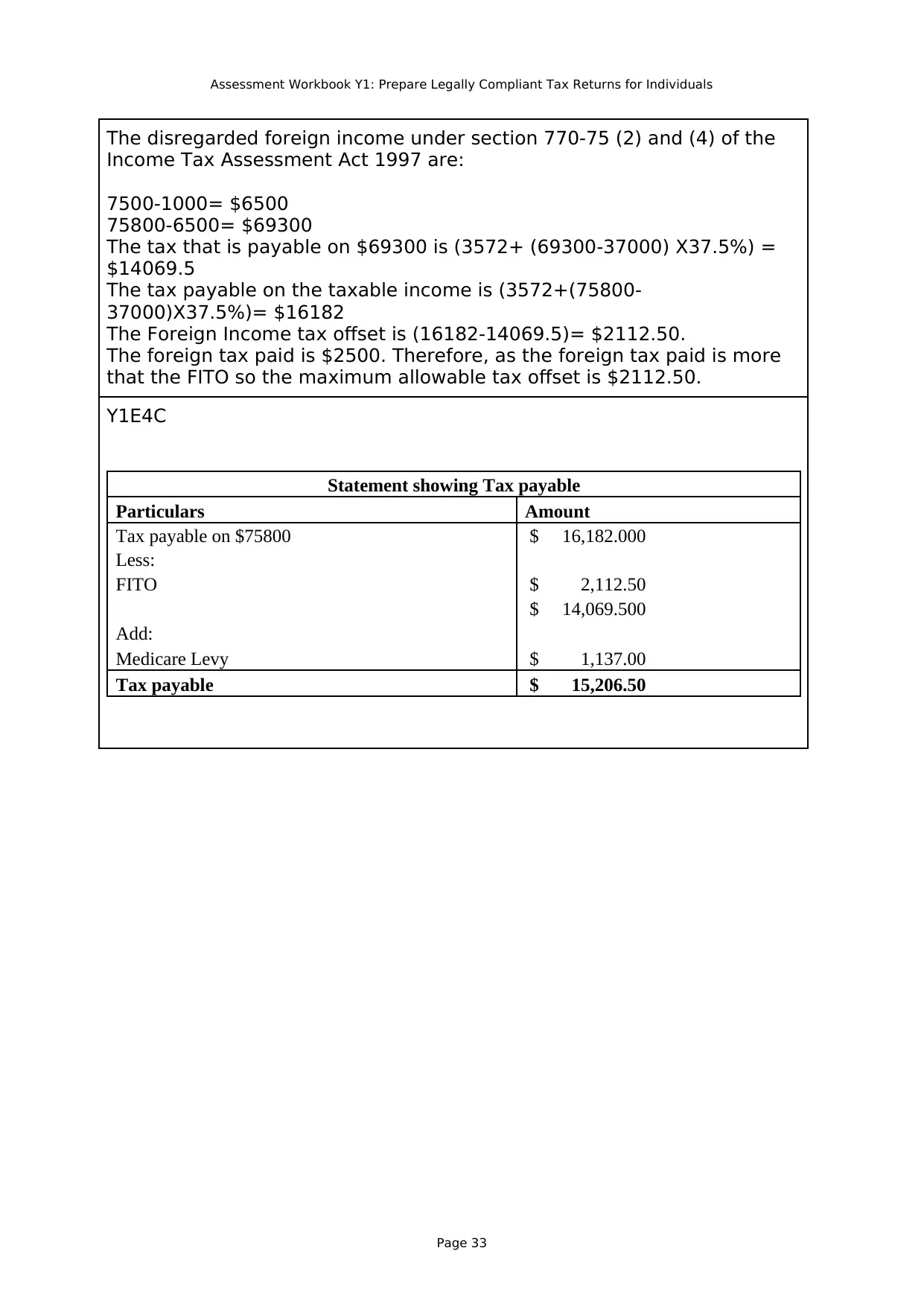
Assessment Workbook Y1: Prepare Legally Compliant Tax Returns for Individuals
The disregarded foreign income under section 770-75 (2) and (4) of the
Income Tax Assessment Act 1997 are:
7500-1000= $6500
75800-6500= $69300
The tax that is payable on $69300 is (3572+ (69300-37000) X37.5%) =
$14069.5
The tax payable on the taxable income is (3572+(75800-
37000)X37.5%)= $16182
The Foreign Income tax offset is (16182-14069.5)= $2112.50.
The foreign tax paid is $2500. Therefore, as the foreign tax paid is more
that the FITO so the maximum allowable tax offset is $2112.50.
Y1E4C
Statement showing Tax payable
Particulars Amount
Tax payable on $75800 $ 16,182.000
Less:
FITO $ 2,112.50
$ 14,069.500
Add:
Medicare Levy $ 1,137.00
Tax payable $ 15,206.50
Page 33
The disregarded foreign income under section 770-75 (2) and (4) of the
Income Tax Assessment Act 1997 are:
7500-1000= $6500
75800-6500= $69300
The tax that is payable on $69300 is (3572+ (69300-37000) X37.5%) =
$14069.5
The tax payable on the taxable income is (3572+(75800-
37000)X37.5%)= $16182
The Foreign Income tax offset is (16182-14069.5)= $2112.50.
The foreign tax paid is $2500. Therefore, as the foreign tax paid is more
that the FITO so the maximum allowable tax offset is $2112.50.
Y1E4C
Statement showing Tax payable
Particulars Amount
Tax payable on $75800 $ 16,182.000
Less:
FITO $ 2,112.50
$ 14,069.500
Add:
Medicare Levy $ 1,137.00
Tax payable $ 15,206.50
Page 33
Secure Best Marks with AI Grader
Need help grading? Try our AI Grader for instant feedback on your assignments.
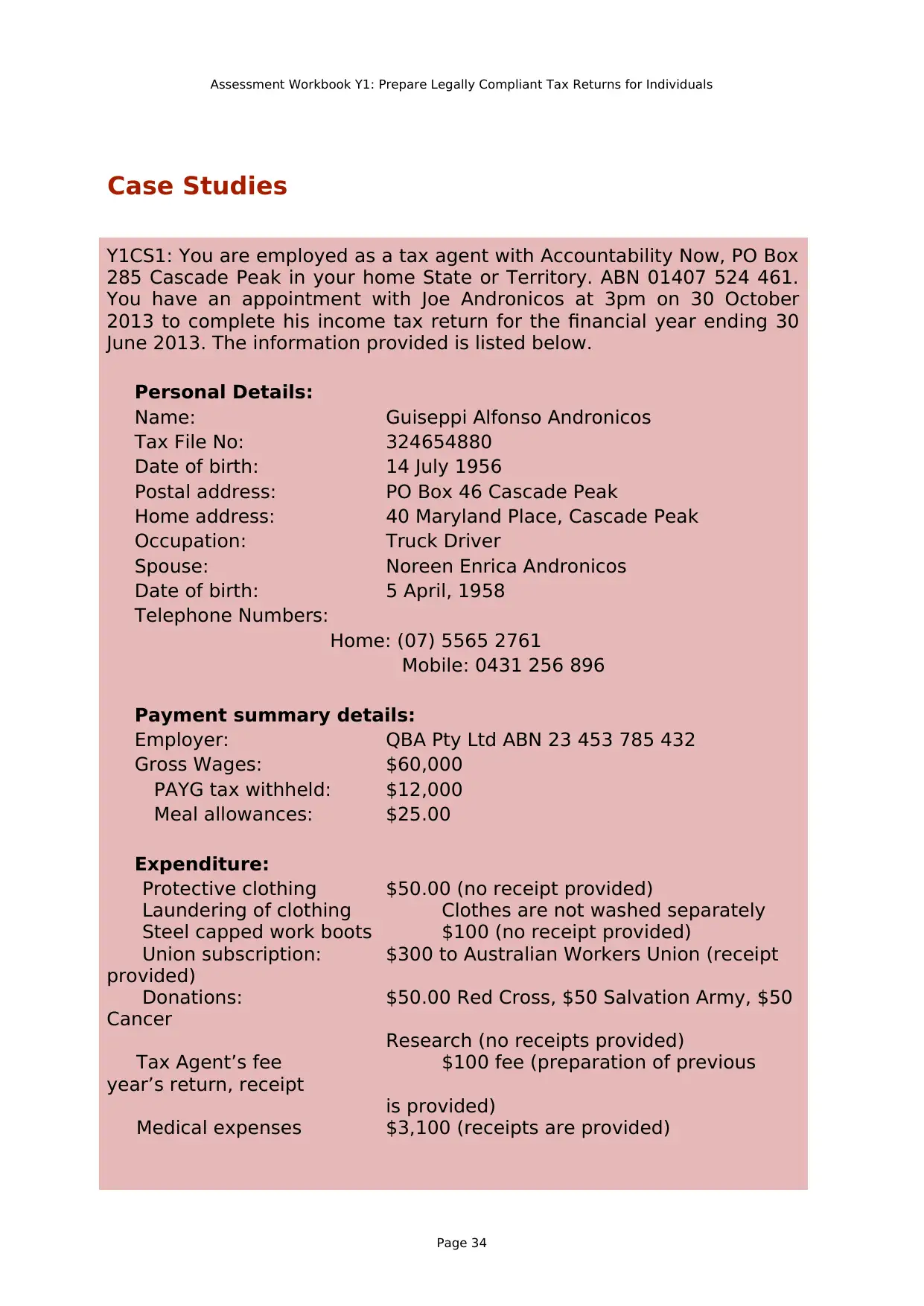
Assessment Workbook Y1: Prepare Legally Compliant Tax Returns for Individuals
Case Studies
Y1CS1: You are employed as a tax agent with Accountability Now, PO Box
285 Cascade Peak in your home State or Territory. ABN 01407 524 461.
You have an appointment with Joe Andronicos at 3pm on 30 October
2013 to complete his income tax return for the financial year ending 30
June 2013. The information provided is listed below.
Personal Details:
Name: Guiseppi Alfonso Andronicos
Tax File No: 324654880
Date of birth: 14 July 1956
Postal address: PO Box 46 Cascade Peak
Home address: 40 Maryland Place, Cascade Peak
Occupation: Truck Driver
Spouse: Noreen Enrica Andronicos
Date of birth: 5 April, 1958
Telephone Numbers:
Home: (07) 5565 2761
Mobile: 0431 256 896
Payment summary details:
Employer: QBA Pty Ltd ABN 23 453 785 432
Gross Wages: $60,000
PAYG tax withheld: $12,000
Meal allowances: $25.00
Expenditure:
Protective clothing $50.00 (no receipt provided)
Laundering of clothing Clothes are not washed separately
Steel capped work boots $100 (no receipt provided)
Union subscription: $300 to Australian Workers Union (receipt
provided)
Donations: $50.00 Red Cross, $50 Salvation Army, $50
Cancer
Research (no receipts provided)
Tax Agent’s fee $100 fee (preparation of previous
year’s return, receipt
is provided)
Medical expenses $3,100 (receipts are provided)
Page 34
Case Studies
Y1CS1: You are employed as a tax agent with Accountability Now, PO Box
285 Cascade Peak in your home State or Territory. ABN 01407 524 461.
You have an appointment with Joe Andronicos at 3pm on 30 October
2013 to complete his income tax return for the financial year ending 30
June 2013. The information provided is listed below.
Personal Details:
Name: Guiseppi Alfonso Andronicos
Tax File No: 324654880
Date of birth: 14 July 1956
Postal address: PO Box 46 Cascade Peak
Home address: 40 Maryland Place, Cascade Peak
Occupation: Truck Driver
Spouse: Noreen Enrica Andronicos
Date of birth: 5 April, 1958
Telephone Numbers:
Home: (07) 5565 2761
Mobile: 0431 256 896
Payment summary details:
Employer: QBA Pty Ltd ABN 23 453 785 432
Gross Wages: $60,000
PAYG tax withheld: $12,000
Meal allowances: $25.00
Expenditure:
Protective clothing $50.00 (no receipt provided)
Laundering of clothing Clothes are not washed separately
Steel capped work boots $100 (no receipt provided)
Union subscription: $300 to Australian Workers Union (receipt
provided)
Donations: $50.00 Red Cross, $50 Salvation Army, $50
Cancer
Research (no receipts provided)
Tax Agent’s fee $100 fee (preparation of previous
year’s return, receipt
is provided)
Medical expenses $3,100 (receipts are provided)
Page 34
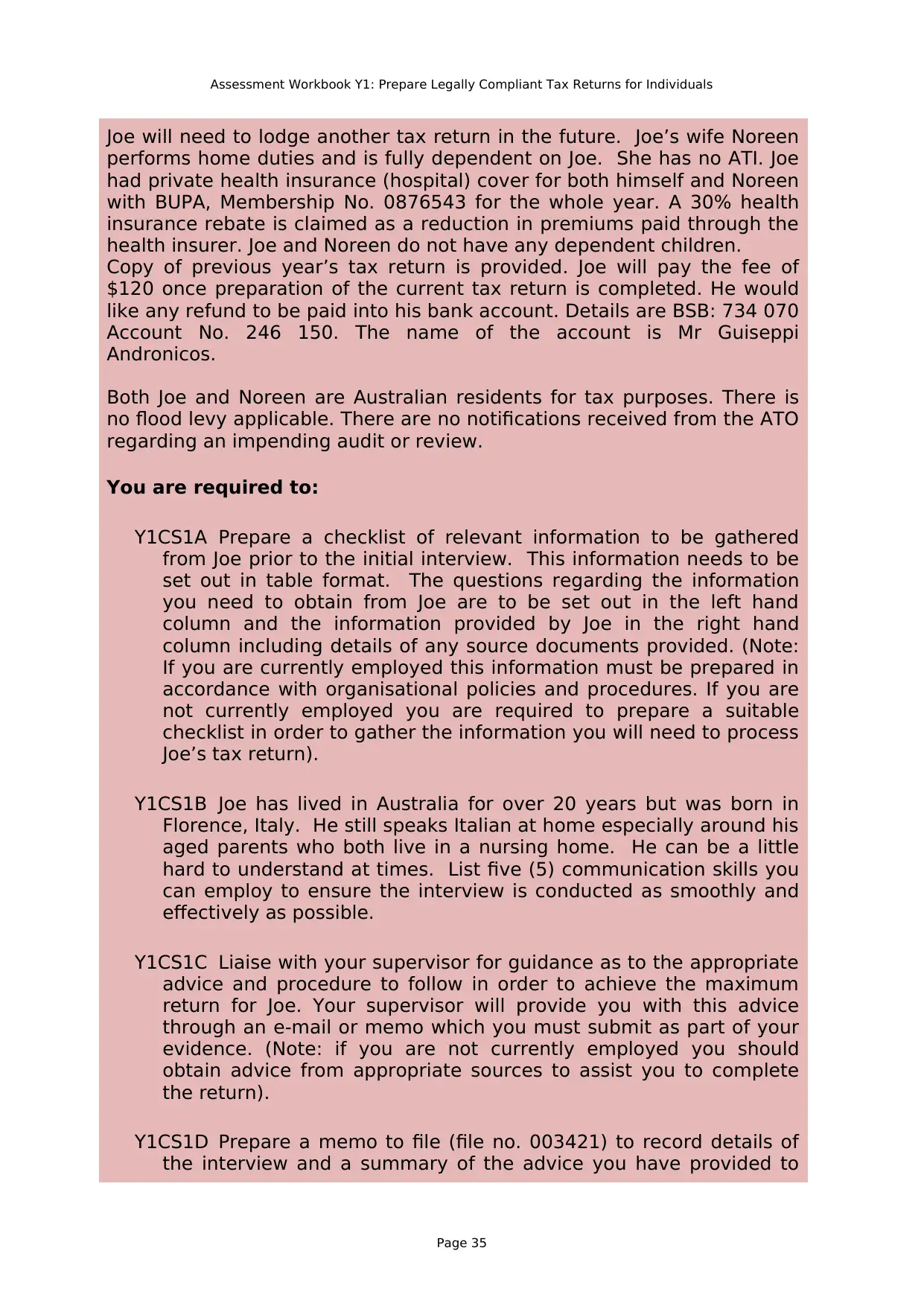
Assessment Workbook Y1: Prepare Legally Compliant Tax Returns for Individuals
Joe will need to lodge another tax return in the future. Joe’s wife Noreen
performs home duties and is fully dependent on Joe. She has no ATI. Joe
had private health insurance (hospital) cover for both himself and Noreen
with BUPA, Membership No. 0876543 for the whole year. A 30% health
insurance rebate is claimed as a reduction in premiums paid through the
health insurer. Joe and Noreen do not have any dependent children.
Copy of previous year’s tax return is provided. Joe will pay the fee of
$120 once preparation of the current tax return is completed. He would
like any refund to be paid into his bank account. Details are BSB: 734 070
Account No. 246 150. The name of the account is Mr Guiseppi
Andronicos.
Both Joe and Noreen are Australian residents for tax purposes. There is
no flood levy applicable. There are no notifications received from the ATO
regarding an impending audit or review.
You are required to:
Y1CS1A Prepare a checklist of relevant information to be gathered
from Joe prior to the initial interview. This information needs to be
set out in table format. The questions regarding the information
you need to obtain from Joe are to be set out in the left hand
column and the information provided by Joe in the right hand
column including details of any source documents provided. (Note:
If you are currently employed this information must be prepared in
accordance with organisational policies and procedures. If you are
not currently employed you are required to prepare a suitable
checklist in order to gather the information you will need to process
Joe’s tax return).
Y1CS1B Joe has lived in Australia for over 20 years but was born in
Florence, Italy. He still speaks Italian at home especially around his
aged parents who both live in a nursing home. He can be a little
hard to understand at times. List five (5) communication skills you
can employ to ensure the interview is conducted as smoothly and
effectively as possible.
Y1CS1C Liaise with your supervisor for guidance as to the appropriate
advice and procedure to follow in order to achieve the maximum
return for Joe. Your supervisor will provide you with this advice
through an e-mail or memo which you must submit as part of your
evidence. (Note: if you are not currently employed you should
obtain advice from appropriate sources to assist you to complete
the return).
Y1CS1D Prepare a memo to file (file no. 003421) to record details of
the interview and a summary of the advice you have provided to
Page 35
Joe will need to lodge another tax return in the future. Joe’s wife Noreen
performs home duties and is fully dependent on Joe. She has no ATI. Joe
had private health insurance (hospital) cover for both himself and Noreen
with BUPA, Membership No. 0876543 for the whole year. A 30% health
insurance rebate is claimed as a reduction in premiums paid through the
health insurer. Joe and Noreen do not have any dependent children.
Copy of previous year’s tax return is provided. Joe will pay the fee of
$120 once preparation of the current tax return is completed. He would
like any refund to be paid into his bank account. Details are BSB: 734 070
Account No. 246 150. The name of the account is Mr Guiseppi
Andronicos.
Both Joe and Noreen are Australian residents for tax purposes. There is
no flood levy applicable. There are no notifications received from the ATO
regarding an impending audit or review.
You are required to:
Y1CS1A Prepare a checklist of relevant information to be gathered
from Joe prior to the initial interview. This information needs to be
set out in table format. The questions regarding the information
you need to obtain from Joe are to be set out in the left hand
column and the information provided by Joe in the right hand
column including details of any source documents provided. (Note:
If you are currently employed this information must be prepared in
accordance with organisational policies and procedures. If you are
not currently employed you are required to prepare a suitable
checklist in order to gather the information you will need to process
Joe’s tax return).
Y1CS1B Joe has lived in Australia for over 20 years but was born in
Florence, Italy. He still speaks Italian at home especially around his
aged parents who both live in a nursing home. He can be a little
hard to understand at times. List five (5) communication skills you
can employ to ensure the interview is conducted as smoothly and
effectively as possible.
Y1CS1C Liaise with your supervisor for guidance as to the appropriate
advice and procedure to follow in order to achieve the maximum
return for Joe. Your supervisor will provide you with this advice
through an e-mail or memo which you must submit as part of your
evidence. (Note: if you are not currently employed you should
obtain advice from appropriate sources to assist you to complete
the return).
Y1CS1D Prepare a memo to file (file no. 003421) to record details of
the interview and a summary of the advice you have provided to
Page 35
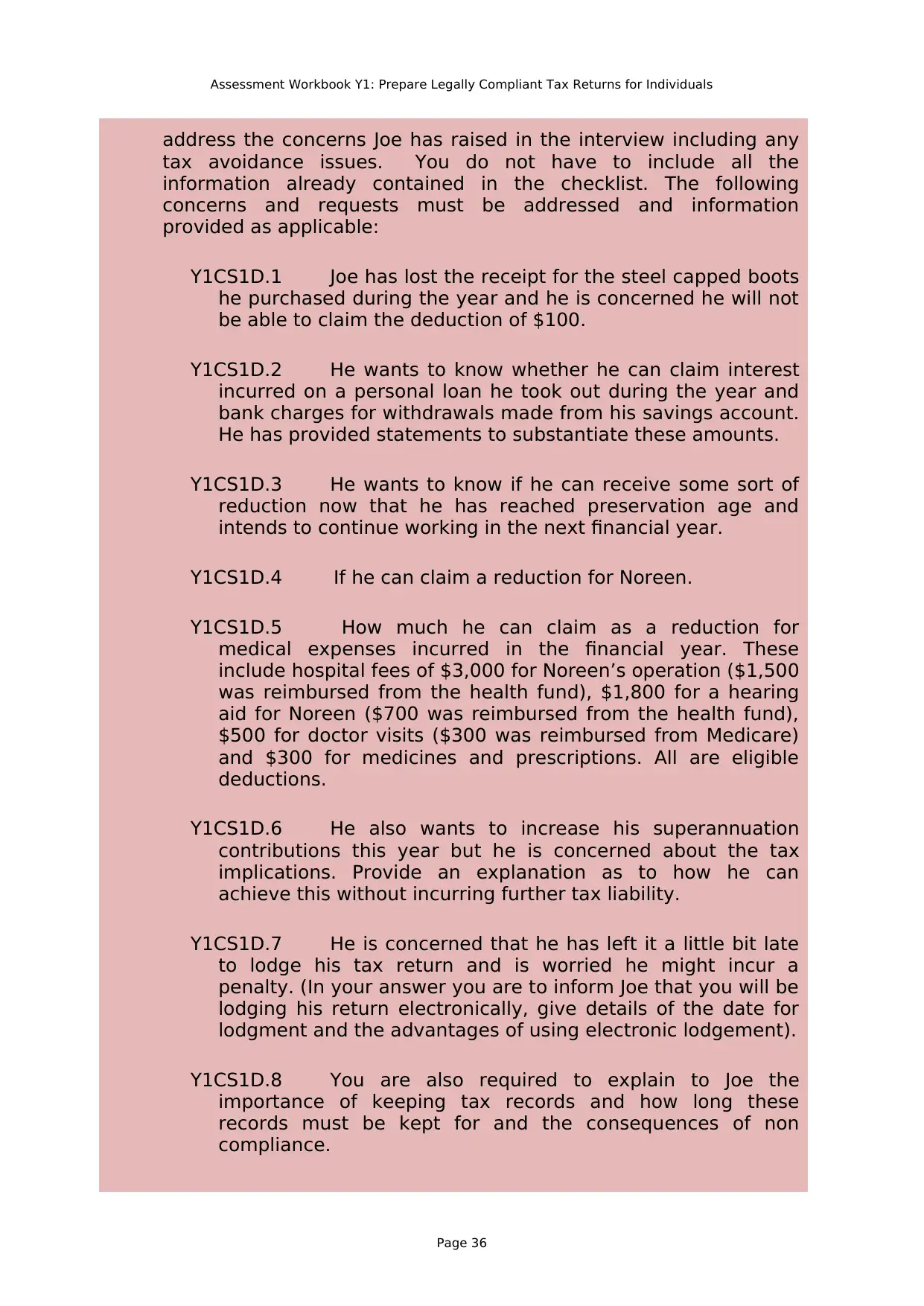
Assessment Workbook Y1: Prepare Legally Compliant Tax Returns for Individuals
address the concerns Joe has raised in the interview including any
tax avoidance issues. You do not have to include all the
information already contained in the checklist. The following
concerns and requests must be addressed and information
provided as applicable:
Y1CS1D.1 Joe has lost the receipt for the steel capped boots
he purchased during the year and he is concerned he will not
be able to claim the deduction of $100.
Y1CS1D.2 He wants to know whether he can claim interest
incurred on a personal loan he took out during the year and
bank charges for withdrawals made from his savings account.
He has provided statements to substantiate these amounts.
Y1CS1D.3 He wants to know if he can receive some sort of
reduction now that he has reached preservation age and
intends to continue working in the next financial year.
Y1CS1D.4 If he can claim a reduction for Noreen.
Y1CS1D.5 How much he can claim as a reduction for
medical expenses incurred in the financial year. These
include hospital fees of $3,000 for Noreen’s operation ($1,500
was reimbursed from the health fund), $1,800 for a hearing
aid for Noreen ($700 was reimbursed from the health fund),
$500 for doctor visits ($300 was reimbursed from Medicare)
and $300 for medicines and prescriptions. All are eligible
deductions.
Y1CS1D.6 He also wants to increase his superannuation
contributions this year but he is concerned about the tax
implications. Provide an explanation as to how he can
achieve this without incurring further tax liability.
Y1CS1D.7 He is concerned that he has left it a little bit late
to lodge his tax return and is worried he might incur a
penalty. (In your answer you are to inform Joe that you will be
lodging his return electronically, give details of the date for
lodgment and the advantages of using electronic lodgement).
Y1CS1D.8 You are also required to explain to Joe the
importance of keeping tax records and how long these
records must be kept for and the consequences of non
compliance.
Page 36
address the concerns Joe has raised in the interview including any
tax avoidance issues. You do not have to include all the
information already contained in the checklist. The following
concerns and requests must be addressed and information
provided as applicable:
Y1CS1D.1 Joe has lost the receipt for the steel capped boots
he purchased during the year and he is concerned he will not
be able to claim the deduction of $100.
Y1CS1D.2 He wants to know whether he can claim interest
incurred on a personal loan he took out during the year and
bank charges for withdrawals made from his savings account.
He has provided statements to substantiate these amounts.
Y1CS1D.3 He wants to know if he can receive some sort of
reduction now that he has reached preservation age and
intends to continue working in the next financial year.
Y1CS1D.4 If he can claim a reduction for Noreen.
Y1CS1D.5 How much he can claim as a reduction for
medical expenses incurred in the financial year. These
include hospital fees of $3,000 for Noreen’s operation ($1,500
was reimbursed from the health fund), $1,800 for a hearing
aid for Noreen ($700 was reimbursed from the health fund),
$500 for doctor visits ($300 was reimbursed from Medicare)
and $300 for medicines and prescriptions. All are eligible
deductions.
Y1CS1D.6 He also wants to increase his superannuation
contributions this year but he is concerned about the tax
implications. Provide an explanation as to how he can
achieve this without incurring further tax liability.
Y1CS1D.7 He is concerned that he has left it a little bit late
to lodge his tax return and is worried he might incur a
penalty. (In your answer you are to inform Joe that you will be
lodging his return electronically, give details of the date for
lodgment and the advantages of using electronic lodgement).
Y1CS1D.8 You are also required to explain to Joe the
importance of keeping tax records and how long these
records must be kept for and the consequences of non
compliance.
Page 36
Paraphrase This Document
Need a fresh take? Get an instant paraphrase of this document with our AI Paraphraser
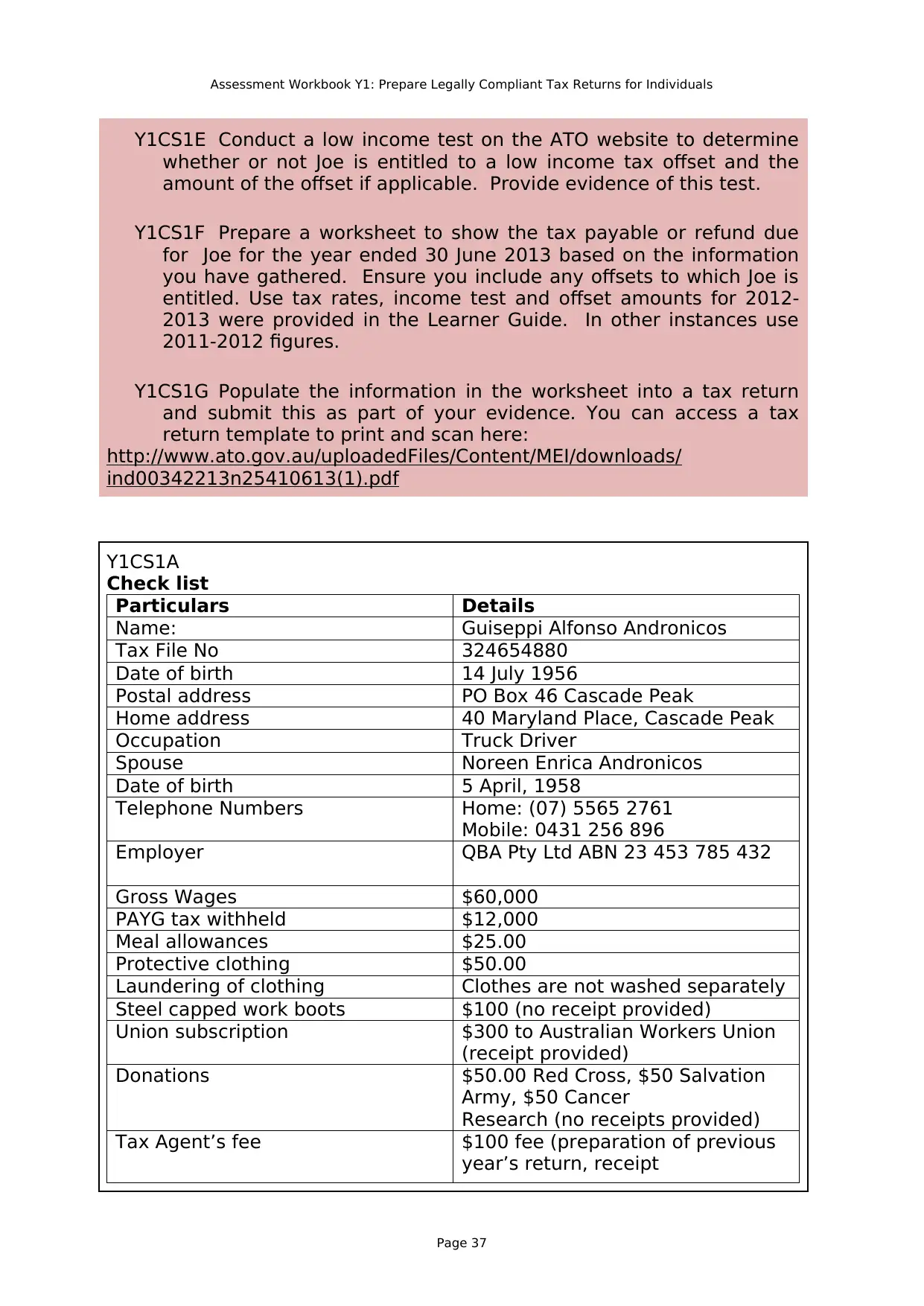
Assessment Workbook Y1: Prepare Legally Compliant Tax Returns for Individuals
Y1CS1E Conduct a low income test on the ATO website to determine
whether or not Joe is entitled to a low income tax offset and the
amount of the offset if applicable. Provide evidence of this test.
Y1CS1F Prepare a worksheet to show the tax payable or refund due
for Joe for the year ended 30 June 2013 based on the information
you have gathered. Ensure you include any offsets to which Joe is
entitled. Use tax rates, income test and offset amounts for 2012-
2013 were provided in the Learner Guide. In other instances use
2011-2012 figures.
Y1CS1G Populate the information in the worksheet into a tax return
and submit this as part of your evidence. You can access a tax
return template to print and scan here:
http://www.ato.gov.au/uploadedFiles/Content/MEI/downloads/
ind00342213n25410613(1).pdf
Y1CS1A
Check list
Particulars Details
Name: Guiseppi Alfonso Andronicos
Tax File No 324654880
Date of birth 14 July 1956
Postal address PO Box 46 Cascade Peak
Home address 40 Maryland Place, Cascade Peak
Occupation Truck Driver
Spouse Noreen Enrica Andronicos
Date of birth 5 April, 1958
Telephone Numbers Home: (07) 5565 2761
Mobile: 0431 256 896
Employer QBA Pty Ltd ABN 23 453 785 432
Gross Wages $60,000
PAYG tax withheld $12,000
Meal allowances $25.00
Protective clothing $50.00
Laundering of clothing Clothes are not washed separately
Steel capped work boots $100 (no receipt provided)
Union subscription $300 to Australian Workers Union
(receipt provided)
Donations $50.00 Red Cross, $50 Salvation
Army, $50 Cancer
Research (no receipts provided)
Tax Agent’s fee $100 fee (preparation of previous
year’s return, receipt
Page 37
Y1CS1E Conduct a low income test on the ATO website to determine
whether or not Joe is entitled to a low income tax offset and the
amount of the offset if applicable. Provide evidence of this test.
Y1CS1F Prepare a worksheet to show the tax payable or refund due
for Joe for the year ended 30 June 2013 based on the information
you have gathered. Ensure you include any offsets to which Joe is
entitled. Use tax rates, income test and offset amounts for 2012-
2013 were provided in the Learner Guide. In other instances use
2011-2012 figures.
Y1CS1G Populate the information in the worksheet into a tax return
and submit this as part of your evidence. You can access a tax
return template to print and scan here:
http://www.ato.gov.au/uploadedFiles/Content/MEI/downloads/
ind00342213n25410613(1).pdf
Y1CS1A
Check list
Particulars Details
Name: Guiseppi Alfonso Andronicos
Tax File No 324654880
Date of birth 14 July 1956
Postal address PO Box 46 Cascade Peak
Home address 40 Maryland Place, Cascade Peak
Occupation Truck Driver
Spouse Noreen Enrica Andronicos
Date of birth 5 April, 1958
Telephone Numbers Home: (07) 5565 2761
Mobile: 0431 256 896
Employer QBA Pty Ltd ABN 23 453 785 432
Gross Wages $60,000
PAYG tax withheld $12,000
Meal allowances $25.00
Protective clothing $50.00
Laundering of clothing Clothes are not washed separately
Steel capped work boots $100 (no receipt provided)
Union subscription $300 to Australian Workers Union
(receipt provided)
Donations $50.00 Red Cross, $50 Salvation
Army, $50 Cancer
Research (no receipts provided)
Tax Agent’s fee $100 fee (preparation of previous
year’s return, receipt
Page 37

Assessment Workbook Y1: Prepare Legally Compliant Tax Returns for Individuals
is provided)
Medical expenses $3,100 (receipts are provided)
Y1CS1B
The five communication skill are:
Patience Listening;
Nonverbal communication;
Clarity and concision;
Empathy;
Open mindedness;
Y1CS1C
The advice related to completion of the return is obtained from the ATO
website and guide provided by the website.
Y1CS1D
1.
The expenses that can be claimed as deduction should be supported by
proper documentary evidence. In the given case, as Joe has lost the
invoice then he cannot claim deduction for the expenses.
2.
The section 8-1 of the ITAA 97 states that the expenses that the
expenses that are utilized for generating assessable income are allowed
as deduction. In the given case the interest from personal loan is a
personal expenses so it can be claimed as deduction.
3.
The mature age tax offset are provided to individual working that have
age more than 55 years. Therefore, it can be said that he can receive
reduction in the form of mature age tax offset of maximum $500.
4.
The taxpayer is eligible to claim tax offset for dependent spouse and
relatives. In the given case, Noreen is dependent so he can claim spouse
tax deduction.
5.
The medical expenses that can be claimed, as deduction is 20% of the
net medical expenses over the prescribed limit.
Statement showing allowable medical tax offset
Page 38
is provided)
Medical expenses $3,100 (receipts are provided)
Y1CS1B
The five communication skill are:
Patience Listening;
Nonverbal communication;
Clarity and concision;
Empathy;
Open mindedness;
Y1CS1C
The advice related to completion of the return is obtained from the ATO
website and guide provided by the website.
Y1CS1D
1.
The expenses that can be claimed as deduction should be supported by
proper documentary evidence. In the given case, as Joe has lost the
invoice then he cannot claim deduction for the expenses.
2.
The section 8-1 of the ITAA 97 states that the expenses that the
expenses that are utilized for generating assessable income are allowed
as deduction. In the given case the interest from personal loan is a
personal expenses so it can be claimed as deduction.
3.
The mature age tax offset are provided to individual working that have
age more than 55 years. Therefore, it can be said that he can receive
reduction in the form of mature age tax offset of maximum $500.
4.
The taxpayer is eligible to claim tax offset for dependent spouse and
relatives. In the given case, Noreen is dependent so he can claim spouse
tax deduction.
5.
The medical expenses that can be claimed, as deduction is 20% of the
net medical expenses over the prescribed limit.
Statement showing allowable medical tax offset
Page 38
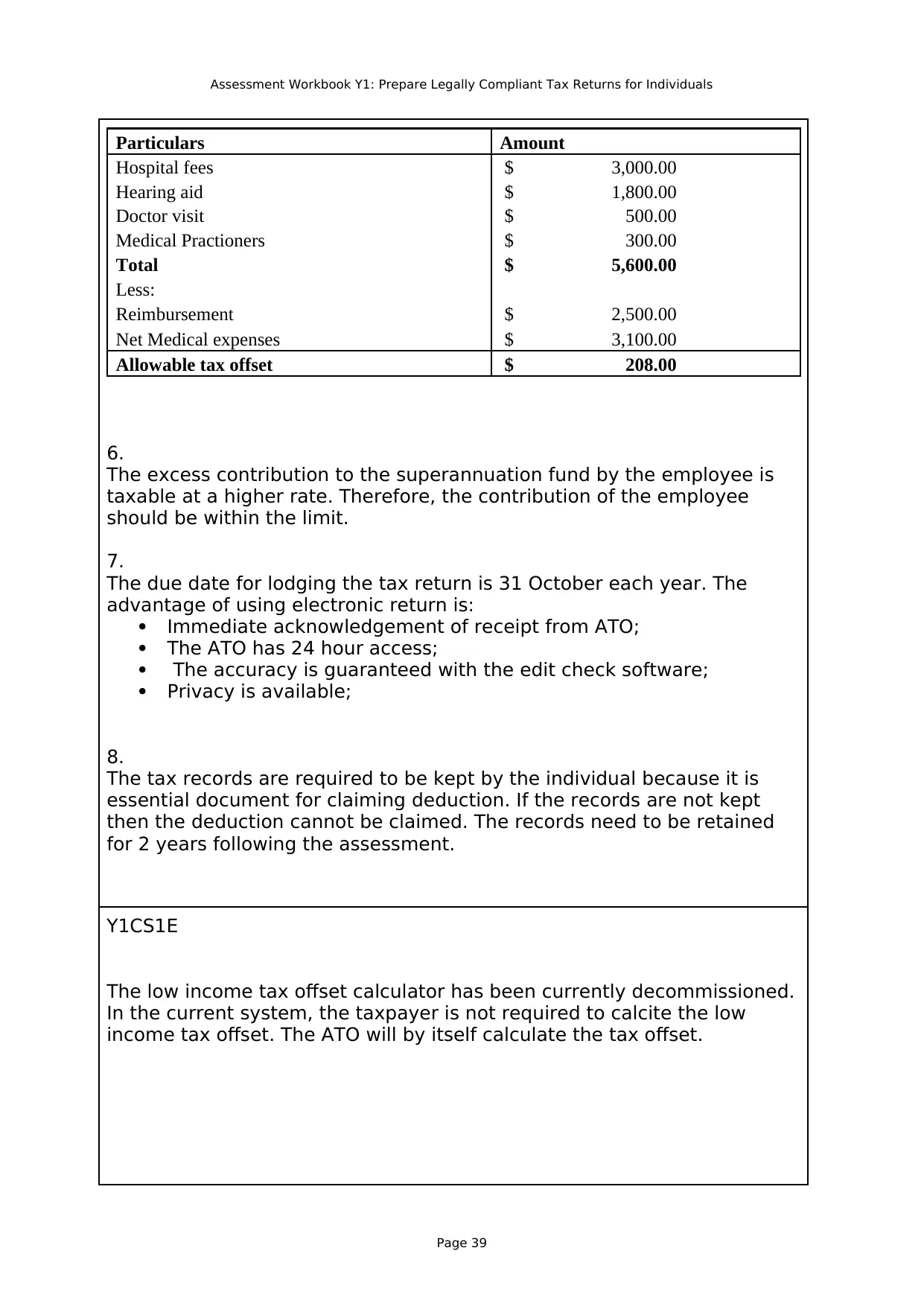
Assessment Workbook Y1: Prepare Legally Compliant Tax Returns for Individuals
Particulars Amount
Hospital fees $ 3,000.00
Hearing aid $ 1,800.00
Doctor visit $ 500.00
Medical Practioners $ 300.00
Total $ 5,600.00
Less:
Reimbursement $ 2,500.00
Net Medical expenses $ 3,100.00
Allowable tax offset $ 208.00
6.
The excess contribution to the superannuation fund by the employee is
taxable at a higher rate. Therefore, the contribution of the employee
should be within the limit.
7.
The due date for lodging the tax return is 31 October each year. The
advantage of using electronic return is:
Immediate acknowledgement of receipt from ATO;
The ATO has 24 hour access;
The accuracy is guaranteed with the edit check software;
Privacy is available;
8.
The tax records are required to be kept by the individual because it is
essential document for claiming deduction. If the records are not kept
then the deduction cannot be claimed. The records need to be retained
for 2 years following the assessment.
Y1CS1E
The low income tax offset calculator has been currently decommissioned.
In the current system, the taxpayer is not required to calcite the low
income tax offset. The ATO will by itself calculate the tax offset.
Page 39
Particulars Amount
Hospital fees $ 3,000.00
Hearing aid $ 1,800.00
Doctor visit $ 500.00
Medical Practioners $ 300.00
Total $ 5,600.00
Less:
Reimbursement $ 2,500.00
Net Medical expenses $ 3,100.00
Allowable tax offset $ 208.00
6.
The excess contribution to the superannuation fund by the employee is
taxable at a higher rate. Therefore, the contribution of the employee
should be within the limit.
7.
The due date for lodging the tax return is 31 October each year. The
advantage of using electronic return is:
Immediate acknowledgement of receipt from ATO;
The ATO has 24 hour access;
The accuracy is guaranteed with the edit check software;
Privacy is available;
8.
The tax records are required to be kept by the individual because it is
essential document for claiming deduction. If the records are not kept
then the deduction cannot be claimed. The records need to be retained
for 2 years following the assessment.
Y1CS1E
The low income tax offset calculator has been currently decommissioned.
In the current system, the taxpayer is not required to calcite the low
income tax offset. The ATO will by itself calculate the tax offset.
Page 39
Secure Best Marks with AI Grader
Need help grading? Try our AI Grader for instant feedback on your assignments.

Assessment Workbook Y1: Prepare Legally Compliant Tax Returns for Individuals
Y1CS1F
Statement showing Calculation of Tax Payable
Particulars Amount Amount
Gross Wages $60,000.00
Meal Allowance $25.00
Assessable Income (A) $60,025.00
Deductions
Laundering Expenses @ $0.50 per cloth $150.00
Union Subscription $300.00
Donation $100.00
Tax Agents Fees $100.00
Total Allowable deduction (B) $650.00
Taxable Income (A-B) $59,375.00
Tax on Taxable Income (3572+(59375-37000)X32.5%) $10,843.88
Medicare Levy $890.63
$11,734.50
Less:
Mature Age Tax offset $500.00
Medical Tax offset $208.00
Total tax offset $708.00
$11,026.50
Less:
PAYG $12,000.00
Tax Refundable -$973.50
Page 40
Y1CS1F
Statement showing Calculation of Tax Payable
Particulars Amount Amount
Gross Wages $60,000.00
Meal Allowance $25.00
Assessable Income (A) $60,025.00
Deductions
Laundering Expenses @ $0.50 per cloth $150.00
Union Subscription $300.00
Donation $100.00
Tax Agents Fees $100.00
Total Allowable deduction (B) $650.00
Taxable Income (A-B) $59,375.00
Tax on Taxable Income (3572+(59375-37000)X32.5%) $10,843.88
Medicare Levy $890.63
$11,734.50
Less:
Mature Age Tax offset $500.00
Medical Tax offset $208.00
Total tax offset $708.00
$11,026.50
Less:
PAYG $12,000.00
Tax Refundable -$973.50
Page 40

Assessment Workbook Y1: Prepare Legally Compliant Tax Returns for Individuals
Y1CS1G
Page 41
Y1CS1G
Page 41
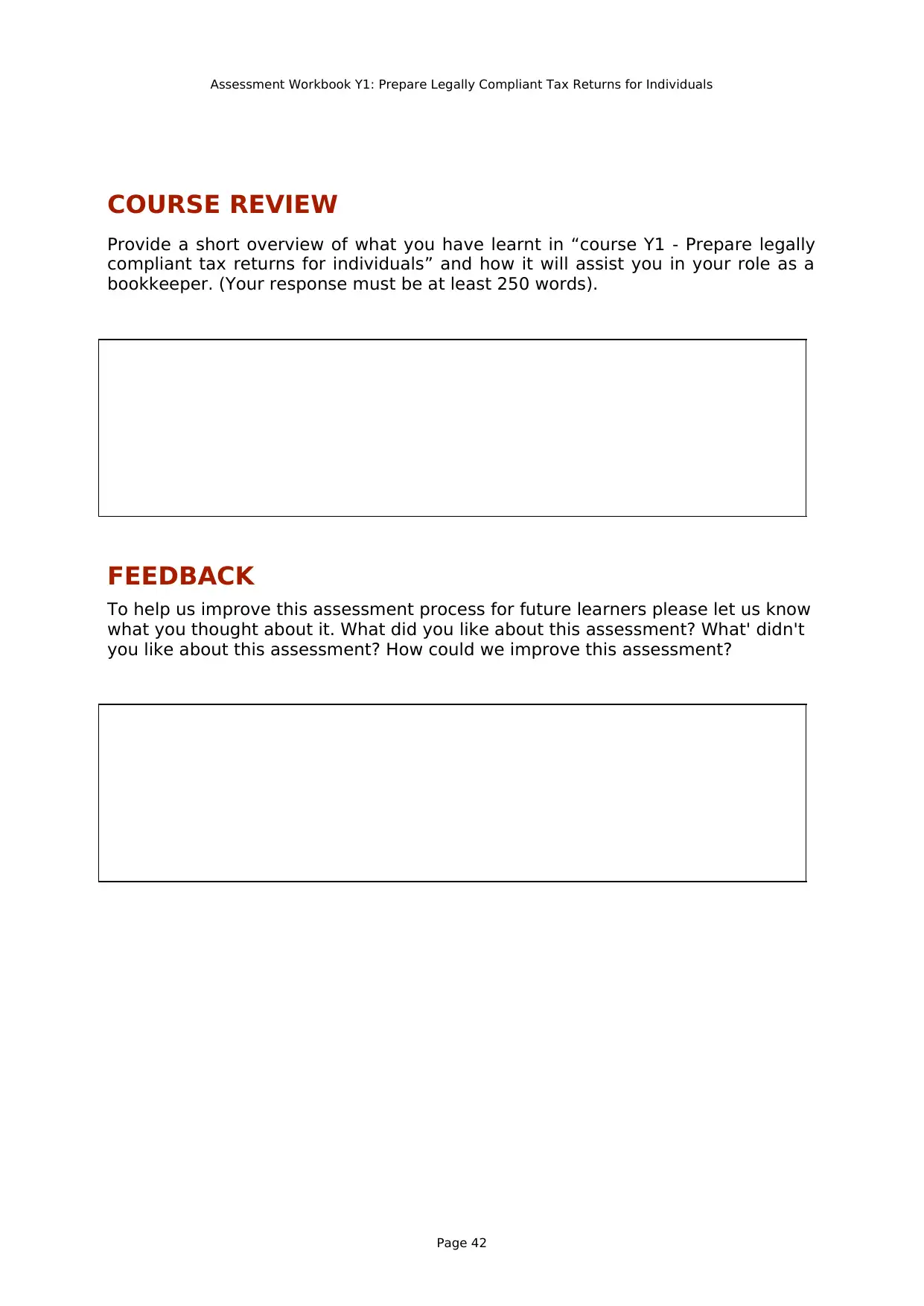
Assessment Workbook Y1: Prepare Legally Compliant Tax Returns for Individuals
COURSE REVIEW
Provide a short overview of what you have learnt in “course Y1 - Prepare legally
compliant tax returns for individuals” and how it will assist you in your role as a
bookkeeper. (Your response must be at least 250 words).
FEEDBACK
To help us improve this assessment process for future learners please let us know
what you thought about it. What did you like about this assessment? What' didn't
you like about this assessment? How could we improve this assessment?
Page 42
COURSE REVIEW
Provide a short overview of what you have learnt in “course Y1 - Prepare legally
compliant tax returns for individuals” and how it will assist you in your role as a
bookkeeper. (Your response must be at least 250 words).
FEEDBACK
To help us improve this assessment process for future learners please let us know
what you thought about it. What did you like about this assessment? What' didn't
you like about this assessment? How could we improve this assessment?
Page 42
1 out of 43
Related Documents
Your All-in-One AI-Powered Toolkit for Academic Success.
+13062052269
info@desklib.com
Available 24*7 on WhatsApp / Email
![[object Object]](/_next/static/media/star-bottom.7253800d.svg)
Unlock your academic potential
© 2024 | Zucol Services PVT LTD | All rights reserved.





